August 9th, 2011
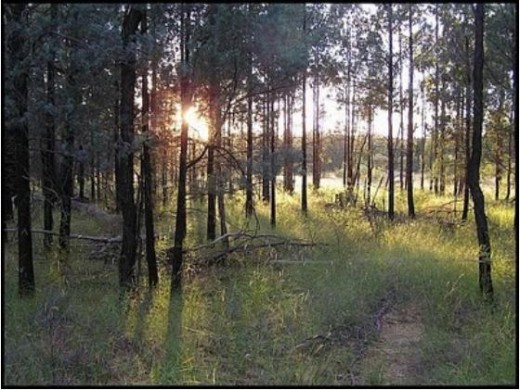 Pilliga Forest
The early morning sun illuminates fresh forest grasses
beneath a stand of young native White Cypress Pine (Callitris glaucophylla), Feb 2010
^http://huntervalleyjournal.blogspot.com/2010_02_01_archive.html Pilliga Forest
The early morning sun illuminates fresh forest grasses
beneath a stand of young native White Cypress Pine (Callitris glaucophylla), Feb 2010
^http://huntervalleyjournal.blogspot.com/2010_02_01_archive.html
.
The Pilliga Forests
.
‘The Pilliga‘, also traditionally known as ‘The Pilliga Scrub‘ is a vast western woodland – the largest continuous remnant of semi-arid woodland in temperate New South Wales, Australia. The Pilliga comprises the largest remaining area of native forest west of the Great Dividing Range, covering about 500,000 hectares between the Namoi River in the North and Warrumbungle Ranges in the South. The Pilliga is part of the Brigalow Belt South bioregion. Australian land mass is divided into 85 bioregions. Each bioregion is a large geographically distinct area of similar climate, geology, landform, vegetation and animal communities. [Read More]
The Pilliga is characterised by native white cypress and iron bark forests, broom bush plains, vivid spring flowers and abundant fauna. The forest contains at least 300 native animal species, with at least 22 endangered animal species including such favorites as the Glossy Black-Cockatoo, Squirrel Glider, Koala, Pilliga Mouse (Pseudomys pilligaensis) and Rufous Bettong, and at least 900 plant species including species now widely grown in cultivation as well as many threatened plant species. The forest spans about 3,000 square kilometres of land. Some towns that surround the forest include Narrabri, Pilliga, Gwabegar, Baradine, Coonabarabran, Boggabri and Baan Baa. Some areas of the forest, particularly in the Western Pilliga, are completely dominated by “cypress pine” (Callitris spp.), however there are a vast number of distinct plant communities in the forest, some of which do not include Callitris pine. Another dominant sub-canopy genus are the Casuarinas, while Eucalypts dominate the canopy throughout the forest. Much of the area is State Forest under the management of the New South Wales Government, which effectively means that it is unprotected.
The name ‘Pilliga’ (or ‘Billarga‘) is an Aboriginal word meaning swamp oak (Casuarina trees). The name was borrowed back in the mid 1800’s as the name of one of the original grazing runs, near where the town of Pilliga now stands. [This theory is contracted by Les Murray in his Forward in Eric Rolls‘ seminal 1981 book ‘A Million Wild Acres‘, who accounts at page iv…”the Pilliga (from Kamilaroi peelaka, a spearhead”).

The geology of the area is dominated by the Pilliga Sandstone, a coarse red/yellow Jurassic sandstone containing about 75% quartz, 15% plagioclase and 10% iron oxide,[2] although local variations in soil type do occur. Sandstone outcrops with basalt-capped ridges are common in the south, while the Pilliga outwash areas to the north and west are dominated by alluvial sediment from the sandy, flooding creeks.
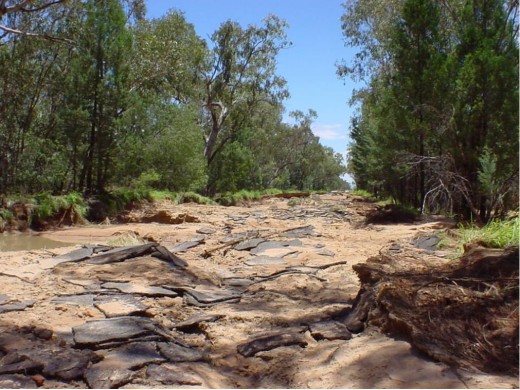 Nuable Creek in flood, Pilliga 2004
Source: David Brodrick, 2004, ^http://www.narrabriweather.net/events/10Dec2004.html Nuable Creek in flood, Pilliga 2004
Source: David Brodrick, 2004, ^http://www.narrabriweather.net/events/10Dec2004.html
.
There is a vast network of roads throughout the scrub, many of which are former forestry roads. The forest once supported a large forestry industry in the surrounding towns (harvesting mostly cypress pine and ironbarks) however this has been greatly scaled back since 2005 when much of the forest was set aside for environmental conservation by the NSW government.
[Sources: ^ http://en.wikipedia.org/wiki/Pilliga_forest, ^ http://narrabri.net/Document1.aspx?id=1872]
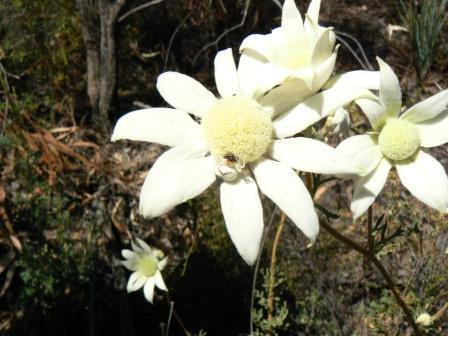
According to the Narrabri Shire Visitor Information Centre, the Pilliga Forest… ‘is one of the largest native cypress forests in Australia and hosts an abundance of wildlife including koalas, kangaroos, possums, echidnas, goannas, emus and its very own species of mouse, the Pilliga Mouse. The area is renowned for its glorious wildflowers which can be found in the Forest year round, with particularly impressive displays in Spring. The Baradine Community has developed three wildflower routes through the Forest. The “Wildflowers of Baradine and the Pilliga’.
[Source: ^ http://www.visitnarrabri.cfm.predelegation.com/index.cfm?page_id=1051&page_name=Wildflowers%20in%20the%20Pilliga]
.
.
.
‘The Pilliga’..after rain
.
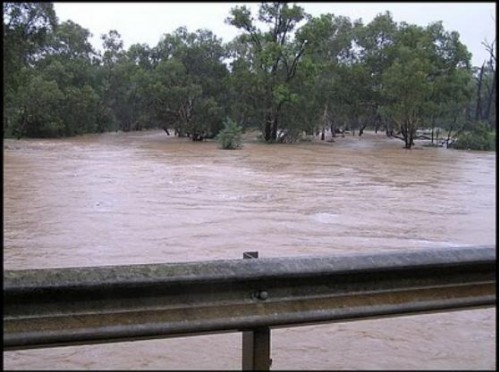
‘Prolific rain on the northwest plains of New South Wales
quickly results in a swelling of rivers and creeks,
followed by a profusion of growth and renewal.
.
Many centimetres of very welcome rain covered the black soil grazing pastures and agricultural properties
surrounding the village of Baradine over the first weekend of February, 2010.
We were there to witness this amazing natural event.
Sheets of water rapidly cover the vast plains,
draining into gullies and creeks, and filling rivers.
Many outlying unsealed roads become impassable,
and the town is temporarily isolated.
But life goes on with relative normality,
albeit with joyous appreciation of the blessings the downpour will bring.’
[Source: HunterValleyJournal, http://huntervalleyjournal.blogspot.com/2010_02_01_archive.html, Feb. 2010,]
.
.
Where is ‘The Pilliga’?
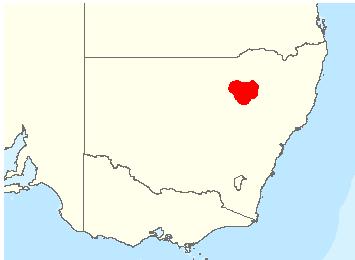 Location of ‘The Pilliga’ as shown by the distribution map of the native Pilliga Mouse
Australian Department of Environment et al.
[Source: ^http://www.environment.gov.au/cgi-bin/sprat/public/publicspecies.pl?taxon_id=99#recovery_plan_loop] Location of ‘The Pilliga’ as shown by the distribution map of the native Pilliga Mouse
Australian Department of Environment et al.
[Source: ^http://www.environment.gov.au/cgi-bin/sprat/public/publicspecies.pl?taxon_id=99#recovery_plan_loop]
.
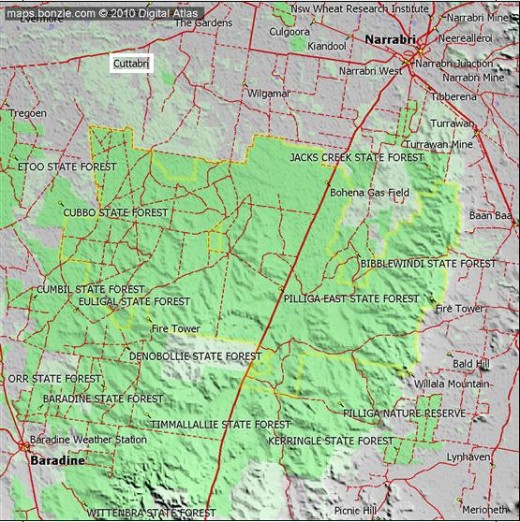 The Pilliga Forests
lie between the towns of Coonabrabran in the south and Narrabri in the north
situated in north western New South Wales in the Brigalow Belt South bioregion.
[Source: ^http://maps.bonzle.com/c/a?a=p&p=56925&cmd=sp] The Pilliga Forests
lie between the towns of Coonabrabran in the south and Narrabri in the north
situated in north western New South Wales in the Brigalow Belt South bioregion.
[Source: ^http://maps.bonzle.com/c/a?a=p&p=56925&cmd=sp]
.
.
The Pilliga’s history of colonial exploitation
.
‘Following many thousands of years of Aboriginal occupation, European settlers started arriving around the early 1830’s. These settlers established grazing runs throughout the forests, which then comprised a few well-scattered large trees over a grassy understorey. Aboriginal burning and grazing by Kangaroo Rats had kept the forest floor clear of regeneration until that time.
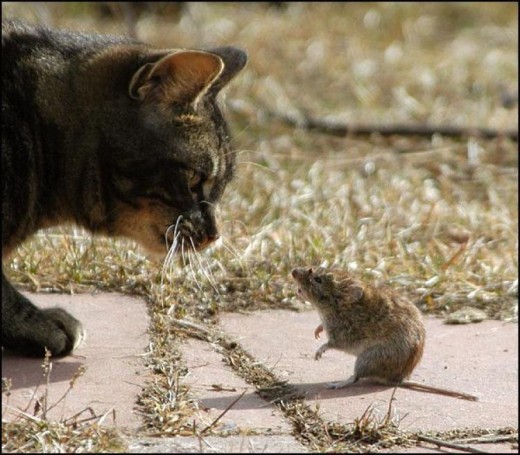
The introduction of cattle and sheep resulted in significant ecological changes. The soils deteriorated and the mix (and grazing quality) of the native grasses changed. The Kangaroo rats were displaced. The 1970’s and 1880’s produced a prolonged drought that saw most of the grazing runs abandoned. Then, during the late 1880’s and early 1890’s, there was a succession of good seasons and, in the absence of grazing pressure and regular burning; massive regeneration of native cypress and eucalyptus took place across much of the Pilliga.
The spread of rabbits to the area in the early 1900’s prevented any further regeneration events in the Pilliga until the introduction of myxomatosis in the 1950’s. With the demise of the Rabbit, a new pulse of young cypress and eucalypt seedlings was able to get up and away.
The cypress regeneration from the late 1800’s forms the basis of the timber industry operating from the Pilliga today. The 1950’s and subsequent growth is being managed to provide a sustainable supply of timber to industry for generations to come. In 1999, there were over 150 jobs dependant on the timber resources of the Pilliga and the industry provides the backbone of many small communities on the fringe of the Pilliga.
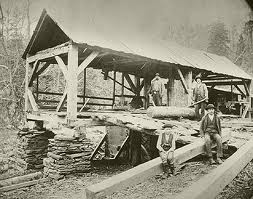 Wooleybah Sawmill, Pillaga
(NSW Heritage Office) Wooleybah Sawmill, Pillaga
(NSW Heritage Office)
.
Between the 1920’s and mid 1990’s, over 5 million railway sleepers were cut from ironbark grown in the Pilliga.

Ironbark is still used to produce fence posts and drops for electric fencing systems, where the non-conductivity of its heartwood provides a unique advantage.’ [Source: ^http://narrabri.net/Document1.aspx?id=1872]
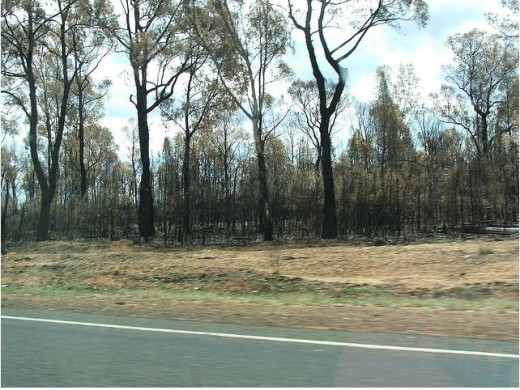 The Pilliga is susceptible to bushfire – by lighting, arsonists and incompetence.
[Source: clubr8255’s photostream, http://www.flickr.com/photos/32053650@N03/with/3038473001/ The Pilliga is susceptible to bushfire – by lighting, arsonists and incompetence.
[Source: clubr8255’s photostream, http://www.flickr.com/photos/32053650@N03/with/3038473001/
.
.
The endemic ‘Pilliga Mouse’
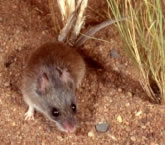
‘Endemic‘ means found naturally nowhere else on the planet.
The Pilliga Mouse (Pseudomys pilligaensis ) is a small native murid rodent found in the Pilliga Forests ecosystem. It is listed as Vulnerable in Australia and is endemic to the Pilliga Forests of New South Wales.
The Pilliga Mouse is very sparsely distributed and appears to prefer moist gullies, areas dominated by extensive coverage of low grasses and sedges, broombush and areas containing an understorey of kurricabah (Acacia burrowii) with a bloodwood (Corymbia trachyphloia) overstorey. It is nocturnal and appears to live in burrows.
Its main threats are from logging operations that destroy the understorey particularly broombush, inappropriate fire regimes (broadscale and frequent bushfire management), predation by ferals (foxes, cats and wild pigs/boars)
.
[Source: ^http://www.environment.gov.au/cgi-bin/sprat/public/publicspecies.pl?taxon_id=99]
.
.
The Pilliga… now threatened by Mining
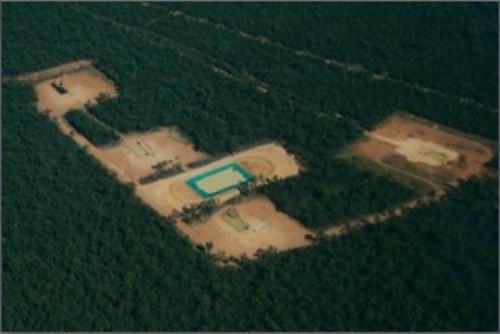
‘Eastern Star Gas coal seam expansion in Pilliga under federal investigation’
(Article on ABC Rural, 20110721, ^http://www.abc.net.au/rural/news/content/201107/s3274633.htm]
.
The Federal Government is investigating whether Eastern Star Gas is in breach of the Environment Protection Biodiversity Conseration Act at its coal seam gas project in NSW’s Pilliga forest.
The project is expected to result in the first large-scale coal seam gas operation in NSW. The Pilliga forest is the largest remaining temperate woodland in eastern Australia.
Chief Executive Officer of the National Conservation Council, Pepe Clark is calling on Santos, which owns Eastern Star Gas, to either desist or defer work until they have Federal approval.
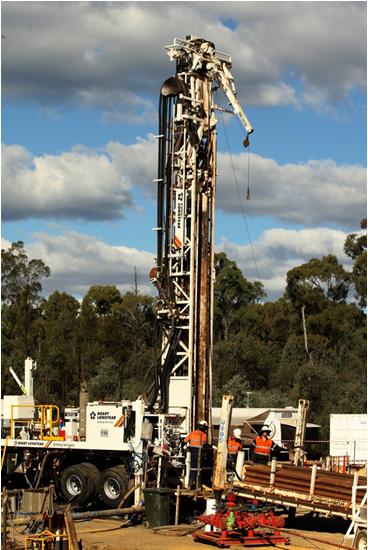 A Silhouette of Pillage
Eastern Star Gas’s coal seam gas development in the Pilliga State Forest, A Silhouette of Pillage
Eastern Star Gas’s coal seam gas development in the Pilliga State Forest,
which is having a profound effect on the Bohema creek water quality and flow which flows into the Murray River
© The Wilderness Society, Photo by Dean Sewell, May 2011
.
.
‘Pilliga coal seam gas developments breach Federal environmental law: report’
(Article by Nature Conservation Council of NSW, 20110719, ^http://www.nccnsw.org.au/media/pilliga-coal-seam-gas-developments-breach-federal-environmental-law-report)
.
‘Eastern Star Gas has conducted coal seam gas exploration and production activities in the Pilliga forest without seeking federal assessment on matters of national environmental significance, according to a report by the Northern Inland Council for the Environment, The Wilderness Society and the Nature Conservation Council of NSW.
The report, Under the Radar, was released today following the recent purchase of Eastern Star Gas by one of Australia’s largest domestic gas producers, Santos.
 
“Eastern Star Gas has undertaken extensive coal seam gas exploration and production without seeking federal approval. This is likely to have damaged the habitat of iconic threatened species such as the Pilliga Mouse and the Regent Honeyeater,” said Warrick Jordan, Campaign Manager at the Wilderness Society Newcastle.
“Santos is taking on the most environmentally destructive and contentious gas project in NSW. As the new owner, Santos should look carefully at the damaging impacts of this proposal and immediately desist or refer all existing operations in the Pilliga for proper assessment.
“We are asking Tony Burke to immediately ‘call-in’ all existing Eastern Star Gas operations in the Pilliga under federal environment laws. Eastern Star should not be able to get away with destroying our natural heritage,” he said.
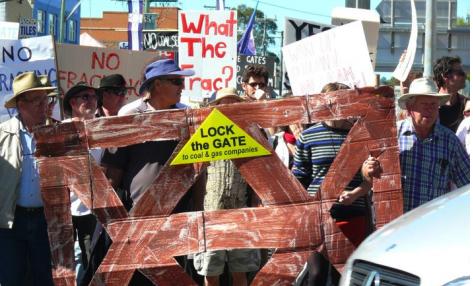
The Under the Radar report found coal seam gas operations in the Pilliga have cleared more than 150ha and fragmented 1,700ha of bushland, drilled 92 coal seam gas wells, constructed 56.6km of pipelines, and operated 35 production wells without seeking approval under the Federal EPBC Act. These activities have occurred in habitat for federally-listed threatened species, such as the South-Eastern Long-eared Bat.
“Under Commonwealth legislation, any potential impacts on nationally-threatened species must be referred to the Environment Department for approval. Eastern Star Gas has been flying under the radar to avoid this process in the Pilliga,” said Pepe Clarke, CEO of the Nature Conservation Council of NSW.
“Eastern Star has recently applied for Commonwealth approval for a large new coal seam gas field in the same area of the Pilliga as existing operations. If these future operations trigger federal environment laws, then so do the existing operations and Santos should immediately cease those operations and be refer them to the Federal Government”,” he said.
“The question remains, will Santos continue Eastern Star’s reckless attempts to turn the iconic Pilliga Forest into an industrial coal seam gas field? If Santos can’t be trusted to abide by environmental laws now, they cannot be trusted to manage the environmental impacts of NSW’ biggest coal seam gas development,” said Carmel Flint, of the Northern Inland Council for the Environment.
Under the Radar report summary
The Federal Environment Protection and Biodiversity Conservation Act 1999 (EPBC Act) makes it illegal to undertake an activity that has, or is likely to have, a significant impact on matters of national environment significance. These prohibitions are set down in Part 3 of the EPBC Act 1999, in s18 and s20 respectively.
There are at least 24 matters of national environmental significance, as defined by the EPBC Act, which occur within the Pilliga Forest section of the Eastern Star Gas Petroleum Exploration Licence 238 and Petroleum Assessment Lease 2. These include known, likely, and potential habitat for 15 nationally threatened species (4 endangered, 11 vulnerable), and known or potential habitat for 9 migratory birds listed under international conventions.
Environment groups have conducted a detailed assessment of the likely impacts of current coal seam gas activities in the Pilliga Forest on matters of national environmental significance, by applying the Guidelines for Significant Impact set down by the Department of Sustainability, Environment, Water, Population and Communities (SEWPaC). These are the same guidelines that should have been applied by Eastern Star Gas to assess the impacts of the activities.
The following coal seam gas activities have been undertaken in PEL 238 and PAL2:
1. The drilling and on-going management of more than 92 coal seam gas bores and coreholes
2. The conduct of 482km of seismic surveys
3. The construction and management of 56.6km of gas and water gathering pipelines
4. The development and management of five production fields, encompassing 35 production bores
5. The construction and management of a gas-fired power station at Wilga Park, including an upgrade of the station from 10MW to 40MW
6. The construction and operation of 1 reverse osmosis unit
7. The construction and management of 13 major water treatment dams/impoundments and numerous drill ponds
8. The discharge of treated produced water into the Bohena Ck, part of the Murray-Darling Basin.
9. The bull-dozing of numerous roads and tracks to facilitate the construction and operation of works listed above.
None of these activities, nor the whole action combined, has ever been referred to the Federal Government for consideration of the likely impacts on federally-listed species under the EPBC Act 1999. There is no Federal approval in place for the action.
The environmental impacts of these activities include: direct destruction of at least 150ha of native vegetation that is habitat for federally-listed species; heavy fragmentation of an area of 1,700 ha of native vegetation leading to the spread of invasive species; creation of artificial watering points at more than 13 different locations representing a risk to wildlife; introducing numerous sources of pollution through the use of chemicals and the handling and disposal of produced water; direct alteration of the ecology of a creek system for up to 22km; increased fire ignition sources and introduction of a flammable gas into an already fire prone environment; an overall disturbance footprint across 44,700ha of bushland.
Applying the Guidelines for Significant Impact, the report concludes that the impacts on federally-listed species are likely to be significant because of the intensity at which they have occurred, as well as:
- The extraordinary national and international conservation significance of the environment in which it is occurring;
- The sensitivity of the ecosystem given the scale of extinctions that have already occurred in the mammal fauna and the scale of decline now evident in the bird fauna;
- The substantial geographic area affected;
- The high cumulative impact in the context of other threats (other mining and gas developments, background clearing rates, climate change, invasive species, logging, and high intensity and frequent fires);
- The low level of confidence with which the impacts are understood; and
- the context in which it occurs of a heavily cleared and highly fragmented landscape with very low levels of reservation.
- The measures put in place by Eastern Star Gas to avoid or mitigate impacts are inadequate to prevent such impacts, and their effectiveness is uncertain and not scientifically established.
..
.
‘Farmers see threat in $900m Santos buyout’
(Article by Ben Cubby and Brian Robins, in Sydney Morning Herald, 20110719, ^http://www.smh.com.au/environment/farmers-see-threat-in-900m-santos-buyout-20110718-1hlq7.html)
.
‘A GAS exploration company chaired by the former deputy prime minister John Anderson will be bought out for $900 million, in a move expected to pave the way for the first large-scale coal seam gas drilling operation in NSW.
The resources giant Santos will buy Mr Anderson’s Eastern Star Gas, which has plans to drill more than 500 gas wells in the Pilliga scrub, near Narrabri, the largest surviving remnant of temperate woodland in eastern Australia.
The plan has already sparked fierce resistance from some farmers, who have said they will lock their gates rather than allow drilling rigs on their grazing land. Many are concerned that the controversial fracking technique, which can lead to groundwater contamination, will be used.
Santos said it recognised the objections people had to coal seam gas drilling, and would campaign to win public support.
”We are confident these issues can be addressed,” said the chief executive, David Knox. ”We’re going to set the right pace and bring [the community] along, as we prove things up … We recognise the criticality of working with local communities.”
Last month Santos launched a television advertising campaign, saying that coal seam gas was ”a fuel for the future” and that the company had previously forged good relationships with rural land-holders.
Mr Knox said the federal government’s introduction of a carbon price would increase demand for gas instead of coal, which generally had higher greenhouse gas emissions.
The acquisition will make Santos the state’s biggest holder of coal seam gasfields.
Opponents say the construction of hundreds of wells, and a network of roads linking them, would industrialise the landscape. ”What’s being allowed here is an uncontrolled experiment on the Australian environment,” said Drew Hutton, a campaigner with the anti-coal seam gas group Lock the Gate Alliance.
Initial surveys prepared for Eastern Star indicate the area is home to many threatened animal and plant species, including the Pilliga mouse, black-striped wallaby, glossy black cockatoo, painted honeyeater and barking owl.
From the beginning of June the Moree Plains Shire Council has placed a 60-day moratorium on seismic surveys, drilling or exploration for coal seam gas, to allow the council and community time to study the implications of proposals.
A report produced by the Wilderness Society said the project was of national significance and should be independently assessed by the federal Environment Minister, Tony Burke.
“The Pilliga project, if it proceeds, will have a devastating impact on the environment,” said a Wilderness Society campaigner, Warrick Jordan.
”It will clear 2410 hectares of valuable bushland across the eastern Pilliga, including in a state conservation area, pose risks to the Great Artesian Basin, produce massive amounts of saline water, and the associated pipelines and wells will impact surrounding agricultural areas.”
The Nature Conservation Council of NSW also said that work already done on the site meant it should be referred to the federal government.
Tony Pickard, a farmer whose land falls within the proposed gas well area, said the first he had heard of the proposal was on a government website that showed dots on his land representing gas wells. Mr Pickard has vowed not to allow drilling on his land.
A NSW Greens MP, Jeremy Buckingham, is travelling through the state speaking to people who oppose coal seam gas extraction.
”To have an energy giant like Santos move in and take over means that the project is much more likely to go ahead,” Mr Buckingham said.
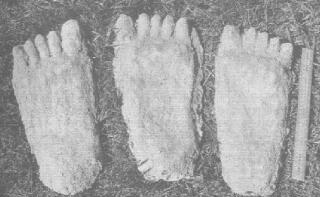 Santos footprints in The Pilliga Santos footprints in The Pilliga
.
‘Under the Radar – new report lifts the lid on Eastern Star Gas operations’
– Article by The Wilderness Society, [Source: ^http://www.wilderness.org.au/campaigns/coal-seam-gas/under-the-radar-new-report-lifts-the-lid-on-eastern-star-gas-operations]
.
‘Eastern Star Gas has been trashing parts of the Pilliga since 2004, avoiding environmental laws in the process. A new report by the Wilderness Society, the Northern Inland Council for the Environment, and the Nature Conservation Council has exposed this scandal.
The Pilliga Forest is home to a host of threatened species, including the Pilliga Mouse and the Regent Honeyeater. Many of these species are listed under the federal Environmental Protection and Biodiversity Conservation Act.
When a company wants to develop a project on a site with nationally listed threatened species, they are required by law to refer the project to the federal environment department.
Eastern Star Gas has been exploring for and producing coal seam gas in the Pilliga Forest since 2004. This has resulted, amongst other actions, in the clearing of 150 hectares of forest, fragmentation of a further 1700 hectares, and the dumping of waste water into creeks.
The ‘Under the Radar‘ (1.35MB – pdf) report concludes that Eastern Star Gas has impacted threatened species habitat, and should have sought federal environmental assessment for its operations. All current and proposed activities should be suspended, and assessed by the Commonwealth Environment Department.
Eastern Star Gas, after ignoring environmental legislation, now wants to build the biggest coal seam gas project in NSW in the Pilliga. They promote this destructive project as environmentally friendly and well managed.
Eastern Star has been exposed as a company that will get away with what it can if it thinks no-one is looking.
Well, now we are watching, and we’ll be ensuring, with your help, that the unique Pilliga Forest won’t become an industrial wasteland.’
.
.
‘A national treasure or an industrial wasteland?’
– Article by Carmel Flint in the Colong Bulletin, No. 241, July 2011, pp.1-2, reproduced with premission of The Colong Foundation for Wilderness, Inc.
.
Coal seam gas has recently emerged as a massive threat to the future of the Pilliga Forest, in north-west NSW. The Pilliga is located between Narrabri and Coonabarabran, and covers an extraordinary 500,000 hectares of intact and contiguous bushland.
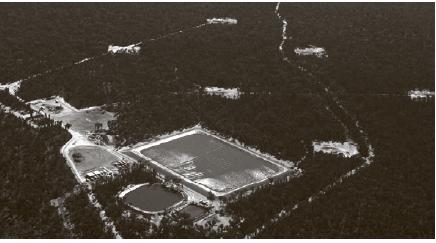 The Bibblewindi water pollution ponds are one of ten constructed during the Pilliga ‘exploration’ phase.
So far there are 1,100 well heads planned for gas extraction just in the eastern quarter of the Pilliga alone.
Photo: T Pickard The Bibblewindi water pollution ponds are one of ten constructed during the Pilliga ‘exploration’ phase.
So far there are 1,100 well heads planned for gas extraction just in the eastern quarter of the Pilliga alone.
Photo: T Pickard
One tends to run out of superlatives very quickly when it comes to the conservation significance of the Pilliga.
It is the largest temperate woodland left in eastern Australia and the southern recharge area for the Great Artesian Basin. It’s surface waters flow into the rivers of the Murray-Darling Basin. It is the single most important biodiversity refuge area remaining in the NSW Wheat-Sheep Belt.
The Pilliga is home to more than 25 threatened or migratory species that are listed under federal laws and at least 48 threatened species under NSW law. It includes the only known population of the endemic Pilliga Mouse, the largest Koala population in western NSW and the only known Black-striped Wallaby population in western NSW. It represents the national stronghold for populations of the Barking Owl and the Southeastern Long-eared Bat within eastern Australia.
It is an internationally recognised Important Bird Area, with particular significance for the Painted Honeyeater and Diamond Firetail. It is also recognised as an important part of the East Australian Bird Migration System, and is located in the Brigalow Belt South bioregion which is one of only 15 biodiversity hotspots recognised by the Federal Government across the nation. It is mostly public land, either State Forest, State Conservation Area or National Park, and it has recognised wilderness values.
Coal seam gas companies have been conducting exploration in the Pilliga for about 10 years now, and they have already done considerable damage. Under the guise of exploration, they have to date drilled 92 coal seam gas wells, constructed 46.2km of pipelines, conducted 394.2km of seismic surveys, constructed 1 gas compression station and 1 reverse osmosis unit, developed five pilot production fields encompassing 35 boreholes, produced and delivered gas to a local power station, constructed
10 major water treatment dams/impoundments, discharged produced water into a local creek system and bulldozed numerous roads and tracks. This, however, is just the tip of the iceberg. In April this year Eastern Star Gas applied to the Federal Government for
an environmental approval to move to full production in the Pilliga Forest.
They want to put in 1,100 wellheads and 1,000km of pipelines across the eastern section of the Pilliga, clearing at least 2,410 hectares and fragmenting 85,000 hectares.
.
Associated with this proposal are two pipelines – one to a proposed gas-fired power station at Wellington and another to a proposed new LNG export facility at Newcastle. By incorporating the first ever major LNG export facility, this Pilliga proposal will effectively open up the whole state to a massive expansion in coal seam gas. And, if that is not enough, it is very clear that this is only the beginning of the project. Having reviewed the data on coal seam gas potential across the companies full exploration licence (PEL238) we estimate that they will ultimately drill 7,100 boreholes, develop 7,000km of pipeline and clear more than 8,000 hectares of land across the Pilliga Forest and farmlands to the north.
Coal seam gas will destroy, fragment and degrade the integrity of this natural treasure. It will transform a thriving, living ecosystem into a heavy industrial zone with massive impacts on fauna and flora. It will dramatically increase fire risk and forever
change the nature of this wildflower wonderland.
.
If you don’t accept such an appalling transformation, then please act now to do something about it.
Email carmelflint@tpg.com.au to get involved and keep updated on what you can do.
.
.
.
Further Reading:
.
[1] ‘Under the Radar: How Coal Seam Gas Mining in the Pilliga is impacting matters of national environmental significance‘, 201106, a joint publication by The Wilderness Society Newcastle, The Nature Conservation Council of NSW and Northern Inland Council for the Environment. [>Open PDF document]
[2] ^http://en.wikipedia.org/wiki/Pilliga_forest,
[3] ^http://narrabri.net/Document1.aspx?id=1872
[4] ^http://huntervalleyjournal.blogspot.com/2010_02_01_archive.html
[5] ^http://www.nccnsw.org.au/media/pilliga-coal-seam-gas-developments-breach-federal-environmental-law-report
[6] ‘A Million Wild Acres’, 1981, by Eric Rolls, $32.95, GHR Press, ^http://ghrpress.com/shoppingcart/index.php?main_page=product_info&products_id=7
.
‘Thirty years ago, a bomb landed in the field of Australian consciousness of itself and its land in the form of Eric Rolls’ A Million Wild Acres. The ensuing explosion has caused extensive and heated debate ever since amongst historians, ecologists, environmentalists, poets and writers. Now reprinted in a commemorative 30th Anniversary Edition for a new generation of readers and against the backdrop of renewed and urgent concern about climate change, it includes Tom Griffiths’ seminal essay, The Writing of A Million Wild Acres, and a foreword by Les Murray drawn from his work Eric Rolls and the Golden Disobedience.
Here is a contentious story of men and their passion for land; of occupation and settlement; of destruction and growth. By following the tracks of these pioneers who crossed the Blue Mountains into northern New South Wales, Eric Rolls – poet, farmer and self-taught naturalist – has written the history of European settlement in Australia. He evokes the ruthlessness and determination of the first settlers who worked the land — a land they knew little about.
Rolls has re-written the history of settlement and destroyed the argument that Australia’s present dense eucalypt forests are the remnants of 200 years of energetic clearing.
Neither education nor social advantage decided the success of the first settlers, or those squatters, selectors, stockmen and timber getters who helped grow the Pilliga forest. Few men were more violent than John Macarthur, few rogues more vigorous than William Cox, few statesmen more self-seeking than William Wentworth.
Rolls’ environment teems with wildlife, with plants and trees, with feral pigs; with the marvellous interaction of insects and plants, rare animals and birds. The lovely tangle which is the modern forest comes to life as Rolls reflects on soils, living conditions, breeding and ecology.
Winner of the prestigious Age Book of the Year Award, A Million Wild Acres is also an important account of the long-term effect man – both black and white – has had upon the forest.’

“The story of the Pilliga forest is one of advance, disappointment and retreat by pastoralists and then by small farmers“. [Les Murray]
May Santos and its Eastern Star Gas venture follow suit and show The Pilliga the respect it so long deserves.
.
.
.
Related Reading:
.
[1] Wollembi Valley Against Gas Extraction,
^http://wage.org.au/news/
.
.
[2] The Permaculture Research Institute of Australia, ‘Save Pilliga – NSW’s Largest Temperate Woodland’,
^http://permaculture.org.au/2011/05/25/save-pilliga-nsws-largest-temperate-woodland/
‘Save Pilliga – NSW’s Largest Temperate Woodland’
— by Cate Faehrmann May 25, 2011
Introduction
Eastern Star Gas has applied for approval under both state and federal regulations to develop a massive coal seam gas field of around 550 gas wells in the State Forests of The Pilliga. Commonly known as the ‘Pilliga Scrub’, this unique woodland is near Narrabri in northern NSW. The gas project is set to clear over 2,400 hectares of native vegetation and will forever change the landscape of the Pilliga.
The Pilliga Scrub is a highly significant area in terms of the state’s biodiversity. It is known to be the largest continuous remnant of semi-arid woodland in temperate New South Wales and contains many threatened animal and plant species such as the Pilliga Mouse, Black-striped Wallaby and South-eastern Long-eared Bat.
Email the Minister now and ask him to protect the Pilliga Scrub from coal seam gas.
Black-striped Wallaby, a mostly nocturnal animal under threat from land clearing, and now, coal seam gas.
The gas field and the related infrastructure proposals (including two major regional pipelines) have been determined to be ‘controlled actions’ under the Environment Protection and Biodiversity Conservation (EPBC) Act. This means they will require the approval of Minister Tony Burke and the Federal Department of Environment. There is also a proposal from Eastern Star Gas being referred for a LNG export processing facility at Kooragang Island at Newcastle.
At the NSW Government level, the projects are being assessed by the Department of Planning under Part3A. The Director General’s Requirements (DGRs) for the environmental assessments were issued in December 2010, but this was not made public until after the recent state election. You can view them here.
This is the biggest coal seam gas field ever proposed in NSW and the first ever LNG export facility in the state. However, it looks to be just the beginning. Eastern Star Gas, headed by former Nationals Leader and Deputy Prime Minister John Anderson, has not revealed their full plans for the area. Coal seams extend underneath almost the entire Pilliga Scrub, and this initial proposal covers 85,000ha of a 500,000ha vegetation remnant. Extrapolating these figures, 550 wells now could mean as many as 3,000 wells in the future. You can read more about the EPBC referrals for the Narrabri Gas Field here at the Federal Environment Department’s website.
The four project components
- Development of a major coal seam gas field in the Pilliga Scrub
- A pipeline from Narrabri to Wellington (via Coolah)
- A pipeline from Coolah to Newcastle
- An LNG export facility at Kooragang Island at Newcastle
Existing activities
Eastern Star Gas Limited (ESG) is the operator of the Narrabri CSG Joint Venture (NJV). Some 35% of the CSG interest in PEL 238 is strata titled to Santos. The Chairman of ESG is John Anderson, former National Party politician. The Narrabri Coal Seam Gas Project is being developed by the NJV.
ESG developed the Wilga Park Power Station in 2004, and supplied it with gas from the Coonarah Gas Field on private land to the north of the Pilliga.
In 2006, a number of closely spaced well production pilots were developed in the Bohena and Bibblewindi fields in the Pilliga Scrub. In 2008, approval was granted for a gas pipeline from the pilot wells in the Pilliga to the Wilga Park Power Station and the expansion of the power station. The expected supply of gas from the Coonarah Gas fields did not eventuate, and the station has been utilising production gas from the pilot wells. The NJV currently has an MOU with ERM Power for the provision of gas to a new gas fired power station at Wellington over a 20 year period commencing in 2013.
Gas field development
The proposed gas field development area covers approximately 85,000 ha and includes Pilliga East State Forest, Bibblewindi State Forest, Jacks Creek State Forest, and Pilliga East State Conservation Area, plus some small areas of Crown Land and private land. The project aims to produce, process, compress and transport CSG from within Petroleum Exploration Licence 238, Petroleum Production Lease 3 and Petroleum Assessment Lease 2.
The project proposal includes the following:
- 550 production well sets, initially, on a 500m spacing
- 1,000 km of gas and water gathering systems (ie pipelines)
- access tracks (through the Pilliga Forests)
- a co-located gas processing and compression plant
- a centralised water management facility
- Ancillary infrastructure such as offices and workshops.
Impacts
The gas production will clear at least 2,410 hectares of native vegetation!
The area that is being targeted includes:
- A rich variety of heritage sites, including a rock shelter, burials, a grinding groove, scarred trees, open sites, stone artefact scatters and isolated finds.
- An Internationally recognised Important Bird Area.
- Known or likely habitat for 25 nationally listed threatened species and five nationally listed Endangered Ecological Communities.
- Known or likely habitat for 48 state-listed threatened species and five state-listed Endangered Ecological Communities including:
- Pilliga Mouse – known only from the Pilliga Scrub, this nationally vulnerable species has a total distribution of only 100,000 hectares. It will be severely impacted by the direct habitat loss, increased predation, and fragmentation leading to impacts on dispersal.
- Black-striped Wallaby – endangered in NSW, the northern Pilliga is the only known location of this species in western NSW. Requiring dense vegetation, it is extremely vulnerable to clearing, fragmentation and increased predation.
- Malleefowl – considered endangered in NSW and nationally vulnerable, has been recorded previously in eastern Pilliga. It is highly vulnerable to increased predation and fire.
- South-eastern Long-eared Bat – the Pilliga Scrub is recognised as the likely national stronghold for this vulnerable species (NSW and Federal). It prefers large, intact stands of native vegetation, and is at risk of fragmentation, loss of hollow trees, and uncovered saline ponds. Numerous other threatened bat species face similar risks from the proposal.
- Glossy Black Cockatoo – a very significant western population of the Glossy Black Cockatoo occurs in the Pilliga Scrub.
- Squirrel Glider, Koala and Eastern Pygmy Possum – which are all likely to be severely impacted by the direct habitat loss, fragmentation (and particularly its impacts on mobility and dispersal), and increased predation.
- Grey-crowned Babbler, Diamond Firetail, Hooded Robin, Speckled Warbler – and numerous other declining woodland birds for which the Pilliga represents a major refuge area. Those species are all threatened by increased fragmentation and predation.
- This area of the Pilliga Scrub is prone to severe, high intensity fires that burn very quickly through vast areas. The proposal to have a massive compressor facility located in the Pilliga, and 550 well production sets, represents a very serious fire risk and has the potential to render a regular Pilliga hot burn to a catastrophic level.
Water resources
The Eastern Star Gas proposal suggests that it intends to use lateral drilling rather than hydraulic fracturing (fracking), but it does not explicitly prohibit or rule it out. There is inadequate assessment of the impacts on groundwater and aquifers, including the Great Artesian Basin. The proposal is extremely vague as to what it plans to do with the water that is produced as a by-product of the extraction process. Currently it states that it will use “a combination of storage and evaporation with tertiary treatment and discharge (environmental flows) for co-produced water management”. Produced water contains a range of naturally occurring substances that are likely to be harmful to the environment and human health. It is highly saline, and can also contain toxic drilling and fracturing chemicals. Eastern Star Gas commits to the development of a Water Management Strategy, but in the absence of such a strategy it is not possible to assess the potential impacts on biodiversity or the environment of produced water.
Take action to save the Pilliga Scrub
The Pilliga campaign will no doubt be the next big fight to protect biodiversity in NSW. The coal seam gas industry is expanding rapidly, and governments are largely taking the advice of industry on the environmental impacts.
As a first step, please send a message to the Federal Environment Minister requesting he reject the project under the EPBC Act. You can write your own personal email by contacting him here. Or simply fill out the form here to send him a generic message.
As the Greens environment spokesperson, together with my colleague Jeremy Buckingham as the Greens mining spokesperson, we’ll be building a campaign to save the Pilliga from coal seam gas and to protect its unique biodiversity. Check back here soon for more information on how you can help save the Pilliga Scrub.
.
.
[3] Pilliga Nature Reserve
^http://www.environment.nsw.gov.au/nationalparks/parkHome.aspx?id=N0464
.
.
[4] GreenLeft, ‘Pilliga Forest new CSG battlefront‘
^http://www.greenleft.org.au/node/47934
‘Pilliga forest new CSG battlefront’
By Kate Ausburn, 20110618
.
The Pilliga State Forest in northern NSW will be turned into a gas field if the government approves Eastern Star Gas‘s (ESG) mining proposal for the region. The proposal set out by ESG seeks to develop the Pilliga into the state’s largest coal seam gas (CSG) project.
The development would include the drilling of more than 1000 gas wells and the clearing of vast stretches of native bushland to make way for gas pipelines and other associated infrastructure, such as a water treatment facility and access roads. ESG is already carrying out smaller scale gas development in the Pilliga, as the operator of the Narrabri CSG Joint Venture.
In 2006, ESG developed coal seam gas production pilot wells in the Pilliga. A gas pipeline was also approved and built to carry gas from these wells to the Wilga Park Power Station, which was built by ESG in 2004.
As well as the wells now used to produce gas, some capped, unused gas wells remain behind barbed wire fences in cleared areas of the Pilliga. At least one expansive pond holding wastewater produced by coal seam gas extraction sits amassing algae on its surface.
ESG’s plans for large-scale expansion of coal seam gas operations in the Pilliga have been criticised by environmental groups and landowners from the region.
The Greens NSW environment spokesperson Cate Faehrmann explained the scale of ESG’s proposal: “The proposed gas field development area covers approximately 85,000 hectares and includes Pilliga East State Forest, Bibblewindi State Forest, Jacks Creek State Forest, and Pilliga East State Conservation Area, plus some small areas of Crown Land and private land.”
Despite the NSW government’s recent introduction of “transitional agreements” to regulate the expanding coal seam gas industry, ESG’s Managing Director David Casey is hopeful about the future of his company’s proposal for the Pilliga.
In a May 25 Open Briefing document, Casey said ESG continues to “monitor opportunities and development pathways with a view to ensuring early commercialisation of the project for the benefit of shareholders …
“Currently, our best estimate is that Federal and NSW regulatory approvals will be in place … in early 2012.”
However, The Wilderness Society’s Warrick Jordan said on June 16 that “given the scale of the project and current uncertainty over NSW mining and planning policy” ESG’s timeline would be difficult to fulfil.
“Estimates of state and federal approval being in place in six months appear wildly optimistic,” he said.
“The assessment requires full community consultation and proper consideration of environmental impacts on 85,000 hectares of forest, 1600 km of pipeline, a RAMSAR wetland, the marine environment, and the Great Artesian Basin.”
Local community and environmental groups came together on June 9 to tour the Pilliga and discuss campaigning strategy to minimise risks associated with coal seam gas and safeguard the environmental integrity of the region.
The coalition of groups will combine their efforts to campaign against expansion of coal seam gas mining in the Pilliga.
The Wilderness Society said on June 16:
“The project area in the Pilliga is a recharge area for the Great Artesian Basin and includes habitat for threatened species, endangered ecological communities, and an area protected under legislation for its natural values.”
.
.
Links to articles on the dangers of Fracking Coal Seam Gas:
.
[5] ^http://www.thegreenpages.com.au/news/fracking-coal-seam-gas-may-poison-organic-farms/
[6] ^http://ntn.org.au/wp-content/uploads/2011/07/NTN-CSG-Report-July-2011.pdf
[7] ^http://www.envirowiki.info/Coal_seam_gas
[8] ^http://www.brisbanetimes.com.au/environment/energy-smart/origin-stops-coal-seam-gas-drilling-after-chemicals-found-in-water-20101020-16ud7.html
[9] ^http://www.perthnow.com.au/news/special-features/fracking-threatens-wa-water-resources/story-e6frg19l-1226010221897
[10] ^http://lockthegate.org.au/csg-facts/csg-factsheet.cfm
[11] ^http://dea.org.au/news/article/fracking_for_coal_gas_is_a_health_hazard
[12] ^http://theconversation.edu.au/coal-seam-gas-could-be-a-fracking-disaster-for-our-health-1493
.
.
.
Community Solidarity:
.
The Coal Seam Gas industry is selfishly exploiting Australian resources for corporate profit, much of which is channelled to foreign owners and investors offshore. In the process, coal seam gas exploration, drilling, fracking and the carcinogenic B-TEX chemicals used are destroying Australia’s natural environment and arable land – bulldozing habitat and spewing salt above ground, while below ground chemically poisoning Australia’s Great Artesian Basin and ground water. The industry is one of extreme discretionary greed and arrogance, perpetuating local environmental rape, pillage and plunder.
If you think your area is the only one concerned about coal seem gas , think again.
The following communities around Australia are being exploited by coal seam gas corporations:
-
Camden, NSW
-
Helensburgh and the Illawarra, NSW
-
Pilliga, NSW
-
Liverpool Plains, NSW
-
Wellington, NSW
-
Gunnedah Basin, NSW
-
Gloucester, NSW
-
Broke, NSW
-
Wollombi, NSW
-
Northern Rivers, NSW
-
Cooper Plains, SA,
-
Otways, Vic
-
Tara, Qld
-
Cecil Plains, Qld
-
Darling Downs, Qld
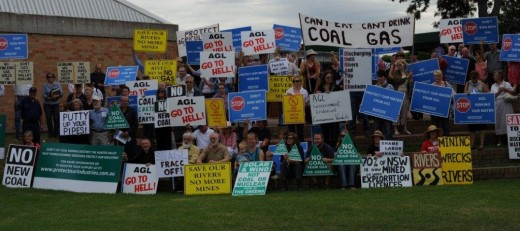
.
Follow similar community campaigns at the following links:
.
[1] ^http://www.gabpg.org.au/downs-farmers-challenge-csg-water-claims
[2] ^http://stop-csg-illawarra.org/
[3] ^http://www.keerronggassquad.org/
[4] ^http://www.stopcoalseamgas.com/
[5] ^http://www.kateausburn.com/2011/07/05/first-for-nsw-protest-stops-coal-seam-gas-rig/
[6] ^http://www.couriermail.com.au/news/queensland/tara-residents-blockade-queensland-gas-company-to-stop-seismic-testing/story-e6freoof-1225903149452
[7] ^http://lockthegate.org.au/tara/
[8] ^http://huntervalleyprotectionalliance.com/
[9] ^http://macarthur-chronicle-camden.whereilive.com.au/news/story/insert-web-head-here-62/
[10] ^http://www.zimbio.com/Australia/articles/P4B7C9pLq7Y/STOP+GLOUCESTER+Coal+Seam+Gas+Mining+near
(The above websites were accessed 20110809)
.
-end of article –
Tags: A Million Wild Acres, a silhouette of pillage, AGL, Apex Energy NL, B-TEX, Bringalow Belt South, Eastern Star Gas, former deputy prime minister John Anderson, fracking coal seam gas, Origin Energy, Pilliga Coal Seam Gas, Pilliga Forests, Pilliga Mouse, Pilliga yowie, Queensland Gas Company, Santos, the Pilliga, what the frack
Posted in Mice (native) and Antechinus, Pilliga (AU), Threats from Bushfire, Threats from Colonising Species, Threats from Deforestation, Threats from Mining | No Comments »
Add this post to Del.icio.us - Digg
Leave a Reply
You must be logged in to post a comment.
August 7th, 2011
The following article was initially posted Tigerquoll on CanDoBetter.net 20090422, and subsequently updated.
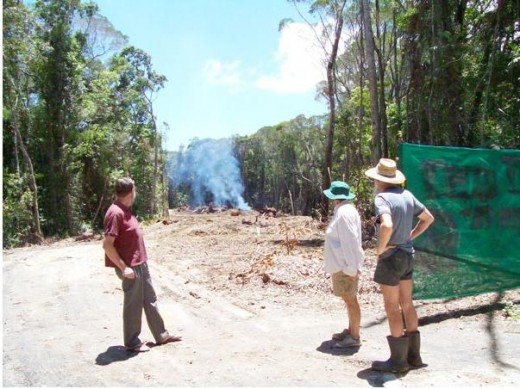 Logging a road through old-growth rainforest
Atherton Tablelands, Far North Queensland
© 2008 Friends of the Earth Kuranda
[Source http://foekuranda.org/]
Logging a road through old-growth rainforest
Atherton Tablelands, Far North Queensland
© 2008 Friends of the Earth Kuranda
[Source http://foekuranda.org/]
.
‘World Forestry Day’ on 21st March is a greenwash promotion by the logging industry. It has the same meaning as the oxymoronic ‘eco-logging‘ (see above photograph).
[‘Eco=logging‘ means that we do leave some trees, sometimes. Some dodgy entrepreneur in South America has tried to register the name ‘ecologging’ as a trademark [^Read More] ]
The concept sounds noble enough on the Victorian Government’s Department of Sustainability and Environment (DSE) site:
“World Forestry Day has been celebrated around the world for 30 years to remind communities of the importance of forests and the many benefits which we gain from them. The concept of having a World Forestry Day originated at the 23rd General Assembly of the European Confederation of Agriculture in 1971.”
.
But hang on a second!
…a “Confederation of Agriculture” …this suggests a different set of values than anecological respect for native forests; somewhat more to do with agriculture (aka ‘logging‘). But I let the Victorian Government’s Dept of Sustainability and Environment (DSE) site continue:
.
“Forests provide many valuable things for the whole community. These include fresh water from forested catchments, a safe home for our flora and fauna, timber for our homes, furniture and paper, beautiful scenery and rugged environments for those who enjoy the outdoors, pollen and nectar for honey production, and archaeological and historical sites.”
“Today, Victoria has an area of approximately 22.7 million hectares. About 40% is public land, meaning that it is owned by the State and managed by the government. There are about 4.8 million hectares of publicly owned native forest which is divided into the following categories: National parks and reserves – 1.7 million hectares, State forest – 3.1 million hectares.”
“Less than one third of Victoria’s state forests are available for timber harvesting and these forests produce more than two million cubic metres of wood products which return about $50 million in revenue to the State.”
.
Ah Ha! So it’s all about revenue FROM our native forests, not a about being FOR our native forests! That phrase ‘timber harvesting‘ conveys such wholesome overtones of good honest pastoral labour, except it’s bloody logging forests! The term has been borrowed by poachers slaughtering kangaroos who euphemistically label the wildlife crime as ‘kangaroo harvesting‘.
So why not just rename this green-washing ‘World Forestry Day‘ what it really is: a celebration of logging – and rename it ‘World Logging Day‘?
DSE on its site suggests:
‘What can I do on World Forestry Day?” ..well children (the propaganda targets school children):
“Celebrate World Forestry Day by visiting your local forests and learning more about the many contributions they make to our well-being. For further information and ideas, see our Forest Education Information.” This link then takes the children directly to the ‘For Schools;’ section of its website which sends a key mesage [sic] to students that ‘forests have many different uses and values.” A second link takes children direct to the hardcore logging site of the Department of Primary Industries”.
[SOURCE: ^http://www.dse.vic.gov.au/DSE/nrenfor.nsf/childdocs/-8E773CD126CA22704A256AA40000EDEE-034EBCC6B1670D984A256AA40011A9F8?open]
.
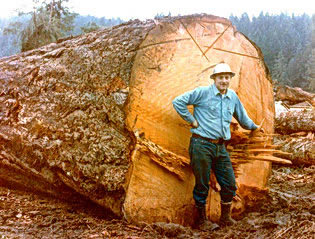 Proud logger Proud logger
.
Forests should be celebrated in their natural state, not by their exploitative revenue potential. Pity that we are now celebrating these in islands and outside the mainstream media. The contrasting ‘Earth Hour’ hype of late seems so token, yet attracts such mainstream publicity and has even Peter Garrett as its cheerleader! But beyond people thinking about turning off lights, Earth Hour pales in addressing irreversible planet damage compared with any day that recognizes the value of global forests.
Recognising natural undisturbed forests and the ‘green carbon’ benefits they contribute to a healthy global future is more important than token politics. As advocated by Professor Brendan Mackey in an article in EEG’s The Potoroo Review (current Spring/Summer 2008-09 edition, p9), “estimates that around 9.3 billion tones of carbon can be stored in the 14.5 million hectares of eucalypt forest in southeast Australia IF THEY ARE LEFT UNDISTURBED.”
While one supports the celebration of native forests in their natural place, the drawback of World Forestry Day is that the forestry industry has corrupted the word ‘forestry’ into a vernacular meaning of ‘exploitation value’.
.
.
World Forest Day – online propaganda during 2010
.
In 2010, if one searched ‘World Forestry Day’ online, one got the following suspicious results:
.
Google Search #1: Department of Sustainability and Environment (DSE) (aka Victorian Government)…say no more
http://www.dse.vic.gov.au/DSE/nrenfor.nsf/childdocs/-8E773CD126CA227 04A256AA40000EDE E-034EBCC6B1670D 984A256AA40011A9 F8?open
.
Search Result in 2011:
.
Google Search #2: NSW Department of Primary Industries | Forests (a chainsaw endorsed site)
http://www.forest.nsw.gov.au/publication/forest_facts/celebrating_ trees_forests/default.asp
.
Search Result in 2011: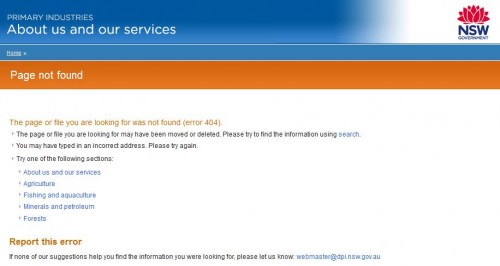
.
Google Search #3: Global Education, but linked to ‘DSE’ after scrolling down the page
http://www.forest.nsw.gov.au/publication/forest_facts/celebrating_ trees_forests/default.asp4: Better Health Victoria
(another Victorian Government website)
.
Search Result in 2011: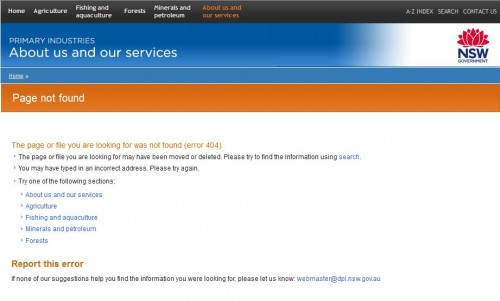
.
Google Search #4: Better Health (Victorian Government again)
http://www.betterhealth.vic.gov.au/bhcv2/bhcevent.nsf/pages/DF43C04B6CC6D19E CA257250007C8F46 ?opendocument
.
Search Result in 2011:
.
So when searching ‘World Forestry Day‘ online, clearly Australian state governments’ greenwashing has set up prime presence.
[Editor: The above government links have disappeared consistent with government short-termism].
.
.
NAFI Propaganda
.
Equally the National Association of Forestry Industries (NAFI) ^http://www.nafi.com.au offered a propaganda page on World Forest Day during 2011.
 NAFI’s logo
NAFI’s logo
.
NAFI boasts that it is..
‘the peak forest industry body in Australia representing a wide variety of companies involved in forest management, wood processing, commercial tree plantation growing, timber sales and distribution, carbon offset growers, forestry harvesters, haulage contractors, and engineered wood products manufacturers. NAFI also represents the interests of forestry research bodies, timber community groups and state forest industry bodies.’
.
Not surprisingly NAFI is located within a ten minute drive of Parliament House Canberra, with a politician never out of earshot.
.
NAFI’s VISION THING
.
‘The vision of NAFI is for an ecologicaly [sic] sustainable Australian society based, in part, on a dynamic, internationally competitive forest industry.’
Clearly drafted by an expensive consultant, it is utopian in its desire for harmonious co-existence between making a buck from logging forests, and conserving the ecological values of those same forests. In other words having one’s cake and eating it too. Pity they couldn’t spell ‘ecologically’.
Yet, conspicuously, ‘ecologically sustainable’ is missing in NAFI’s Objectives.
.
NAFI’s OBJECTIVES
.
- Improve the commercial results and investment attractiveness of the forest industries through favourable government policy decision and actions (i.e. make money from logging).
- Create a preferred position for the Australian forest industries in the rapidly changing international framework of treaties, codes of practice, standards, conventions and legislation. (i.e. influence law making so that more money can be made from logging).
- Achieve widespread community recognition of the social, environmental and economic benefits of forest industries. (i.e. drive a propaganda strategy to win hearts and minds that logging is good).
- Support and promote innovation, research and development. (i.e. pay universities to write reports to show that logging is good).
- Improve market opportunities and competitive advantage in order to increase demand for forest products and achieve consumer satisfaction (i.e. market logging).
- Achieve maximum utilisation of Australian resources within a framework of an open and competitive market. (i.e. be efficient by logging all the forest and invite others to join in).
- Service members needs and maximise industry ownership and involvement in the Association. (i.e. lobby loggers interests for more forests to log and build numbers to maximise political influence)
.
Without compromise, the above objectives convey a single minded focus on commercial logging of forests.
.
NAFI’s BIGGER LOGGER LOBBY GROUPING: ‘AFPA’
.
Consistent with the NAFI objectives (not the VISION), in April 2011 the Australian Forest Products Association (AFPA) was formed through the merger of the Australian Plantations Products and Paper Industry Council (A3P) and the National Association of Forest Industries (NAFI). Nothing uncertain about the motives of this organisation. Anyone who profits from logging is represented by AFPA – ‘tree plantation growers, harvest and haulage contractors, sawmillers, forest product exporters, and pulp and paper processors’. The new website is ^http://www.ausfpa.com.au/site/
Not surprisingly, AFPA is strategically located in NAFI’s offices, just a ten minute drive from Parliament House, Canberra, with ready access to the hearts and minds of Australia’s federal politicians.
A few weeks prior on 21 March 2011, a gala dinner was staged between the loggers and the politicians up the road at Parliament House, Canberra to (believe it or not) celebrate the United Nations’ Declaration of 2011 as the ‘International Year of Forests’. The logger body’s response to 2011 being the ‘International Year of Forests’ has been to unite loggers into a single united mighty lobbying force for logging – the AFPA.
“A single voice, a single association, is a clearer and more concise way to present the forest products industry to governments, the media and the people of Australia in a united fashion.”
– Linda Sewell, transitional Chairperson of AFPA and A3P Chairperson, after announcing the creation of AFPA in Canberra on 21 March 2011.
No surprise who is on the Transitional Board of AFPA – loggers and logging product merchants one and all:
- Ms Linda Sewell, HVP Plantations (Transitional Chairperson)
- Mr Bryan Tisher, Boral Timbers (Transitional Treasurer)
- Mr Greg McCormack, Midway Ptd Ltd
- Dr Hans Drielsma, Forestry Tasmania
- Mr Ian Telfer, WA Plantation Resources (WAPRES)
- Mr Jim Snelson, Carter Holt Harvey (CHH)
- Mr John McNamara, Hyne & Son
- Dr Jon Ryder, Australian Paper
- Mr Terry Edwards, Forest Industries Association of Tasmania (FIAT)
- Mr Vince Erasmus, Elders Forestry
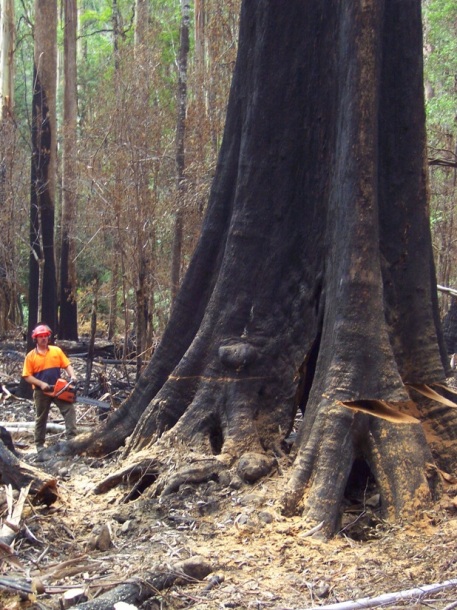 A more apt logo for the Logging Industry A more apt logo for the Logging Industry
The motives for World Forestry Day are nothing but blatant pro-logging propaganda.
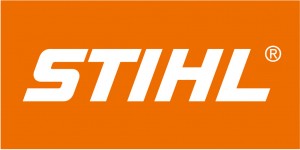 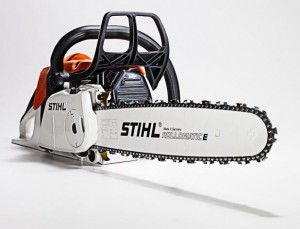 Stihl Chainsawing Old-Growth Stihl Chainsawing Old-Growth
…’are you looking for the best chainsaw for cutting trees?’ ~ quote from Stihl’s website.
.
The term ‘Existence value’ deserves to be further explored and promulgated, so we can develop a greater non-utilitarian value of our natural and now rare forests. Our precious forest exists for their own sake, the forest ecosystems they support and of which we have so little comprehension of their global existence value and scarcity.
– end of article –
Tags: AFPA, Australian Forest Products Association, DSE, eco-logging, forestry, General Assembly of the European Confederation of Agriculture, greenwashing, logging industry, NAFI, National Association of Forestry Industries, Stihl, stihl chainsawing old-growth, Victorian Department of Sustainability and Environment, World Forestry Day, world logging day
Posted in Threats from Deforestation, Threats from Greenwashing, Threats from Road Making | No Comments »
Add this post to Del.icio.us - Digg
Leave a Reply
You must be logged in to post a comment.
August 6th, 2011
On August 6th, 2011 Tigerquoll on CanDoBetter.net stated:
 to know one’s fate to know one’s fate
.
Globalisation is evangelised as the modern religion of humanism. But dare criticise it and so invoke the blind wrath of SBS devotees, and be cast out, branded a facist racist and persecuted as if a 1692 Salem witch – burned at the stake!
.
Yet the demise of local values, endemic plants, endemic animals and traditional peoples are under barrage from the human pathogen. The torrent of human numbers, morphing influence and power out of the hands of incumbent local populations into the hands of the immigrant, who arrives, breeds, colonises and usurps. At least Julius Caesar left after he came, saw and conquered.
Every immigrant (alien) who steps off a plane, every introduced plant (weed), every introduced animal (feral) compounds the human pathogen against endemic species and peoples. Our 21st Century has the most humans ever. Climate change is not the problem.
.
Beachhead immigration in Australia has prevaded local society into becoming a preferred choice of Labor MPs.
It’s no different to VicForests logging Potoroo forest habitat throughout Victoria’s East Gippsland and then introducing sheep. Then there is the bizarre argument of one breed of ferals proclaiming more rights over that of another.
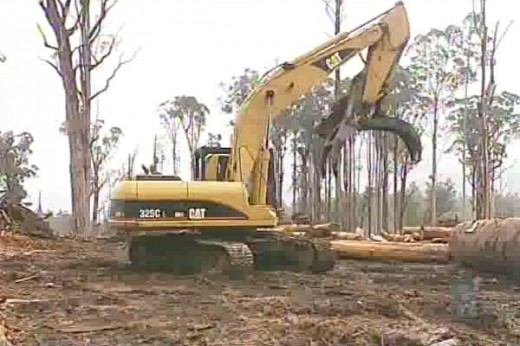 the absolute power of our species the absolute power of our species
.
.
Read the following article:
.
‘Deer culling attracts wild dogs’
[Source: ABC, Wednesday, 20110427, ^http://www.abc.net.au/rural/news/content/201104/s3201322.htm]
.
‘Wild dogs are encroaching closer into urban areas of Victoria’s east Gippsland.
Leo Hamilton, retired agronomist and 40-year landholder, has lost $1,000 worth of sheep to wild dogs in two months at his fine wool enterprise on the outskirts of Bairnsdale.
He says a formerly minor dog problem is escalating, as shooters try to control feral deer, and their fallen carcasses attract other pest animal predators.
“Sambar deer is not the sort of thing you throw in the back of the ute and cart off. You are talking 300-400 kilos of meat,” he said.
“And you talk to the truckies and the truckies have got the same problem. If they hit one on the road, it is two and half grand to fix the truck.”
Mr Hamilton says wild dogs were controlled in the past, but the behaviour of the large dogs has changed from shy killers for food, to aggressive and savage attacks that maim sheep.
“What is different about this attack is they are not predictable. In the past, the dog has come in and eaten the sheep, but these are unpredictable as they come in at any time, don’t eat the sheep, they mutilate the sheep, they just play with the sheep and maul them.”
Mr Hamilton says the culled feral pest deer weigh 300-400 kilogram, making them too heavy for shooters to remove.
“Their attitude is that they disaster in a couple of days…but they disappear in a couple of days because the wild dogs and foxes eat them.”
He says the wild dog problem is escalating and growing as the sambar deer population spreads to the outer urban areas.’
.
.
.
No mention of the indigenous Potoroo in all that. The controlling ferals are debating inter-feral rights, while the indigenous are ignored, forgotten…relegated to history’s underclass.
.
The terror of invasion. The defeat of a people and their cultural annihilation – resigned, racial hopelessness in the face of an invader’s genocidal ‘business as usual’.
.
Dominant sociopolitical dogma embraces, prescribes and propagates globalisation as global benefiting from cultural sharing and harmonisation of wealth, living standards and life expectancy. Hence AUSAID http://www.ausaid.gov.au/ is hell bent on parting Australia’s wealth to Third World prolific breeders of humanity.
.
But Globalisation erodes all labour industries in societies that have embraced human values of a safe, healthy and meaningful workplace to those backward sweatshop societies that couldn’t give a damn. This is why Australia’s unionised manufacturing which hard fought for OH&S standards has succumed to off-shoring who couldn’t give a damn about their workers.
Cheap products are human cheap, they dismiss human labour as ‘cheap’ – cheap in cost and cheap in value – cheap and nasty. 99% of all products sold in K-Mart are made in China, where cheap labour has supplanted Australia’s manufacturing base.
.
Globalised competition can force a ‘race to the bottom’ in wage rates and labour standards. Profit-imperative employers and government employer-sympathisers brand it euphemistcally ‘trade liberalisation’. Free enterprise in globalisation spares small operators no chance against the market might of multinationals. Only the big survive.
Indigenous and national culture and languages are being eroded by the modern globalised culture – the United States imposes Sarbanes Oxley on the rest of the planet who wish to trade with it.
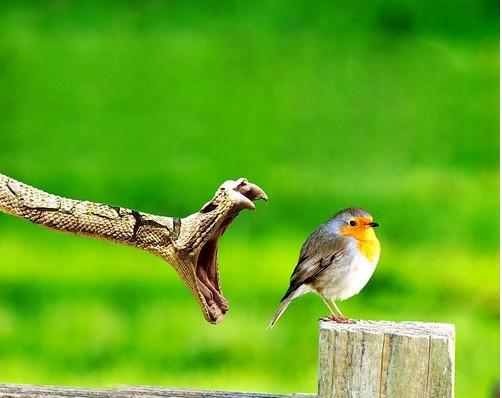 the tenet of globalisation the tenet of globalisation
.
Currently ecological conservation efforts are being made to deal with the rabbit population on Macquarie Island in a bid to save and restore the indigenous fauna populations and their habitat.
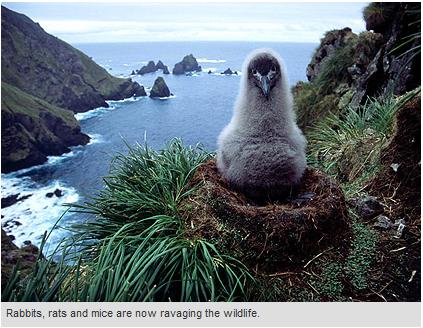 habitat reduced to islands habitat reduced to islands
.
Tigerquoll
Suggan Buggan
Snowy River Region
Victoria 3885
Australia
Tags: beachhead immigration, ferals, globalisation, habitat reduced to islands, human pathogen, humanism, indigenous, invasion, overpopulation, Potoroo, tenet of globalisation, the absolute power of our species, to know one's fate, wildlife extinctions
Posted in 34 Wildlife Conservation!, Threats from Colonising Species, Threats from Overpopulation, Wildlife | No Comments »
Add this post to Del.icio.us - Digg
Leave a Reply
You must be logged in to post a comment.
August 4th, 2011
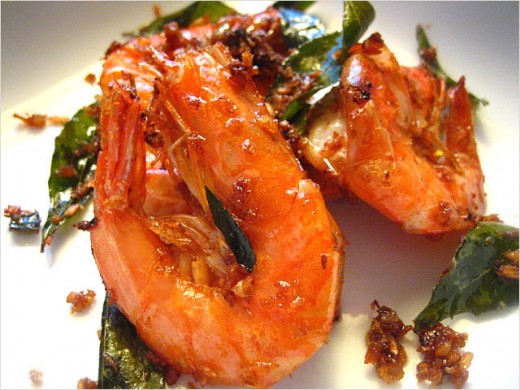 Prawns – an Australian favourite dish Prawns – an Australian favourite dish
[Source: http://rasamalaysia.com/butter-prawns/]
.
Back in 1987 at the formative age of 23, the author worked ten days as a deck hand aboard a prawn trawler off the coast of Townsville in northern Queensland.
Those ten days formed the basis of what would contribute invaluably toward ultimately obtaining a year’s inshore sea time to qualify as a licensed commercial coxswain. But those ten days are also vividly recalled of the experience of the work of a prawn trawler. For those ten days aboard the comparatively small 9.8 metre diesel trawler ‘Charada‘, Frank the skipper, his first mate and I trolled the sea floor along the north Queensland coastline between Townsville and Cape Bowling Green.

My Record of Service log confirms this, as my memory of twenty four years ago is not that acute. My log shows that I later went on to work as a deckhand aboard mainly commercial tourist vessels after that. So my only commercial fishing experience was that short stint aboard the Charada.
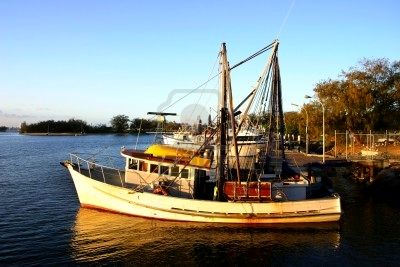 A prawn trawler similar to the ‘Charada’ A prawn trawler similar to the ‘Charada’
.
However, my memory remains vivid of the nightly three shifts we worked, commencing respectively at 9pm, midnight and 3am – hauling in the prawn catch after trawling the sea floor for three hours at a time.
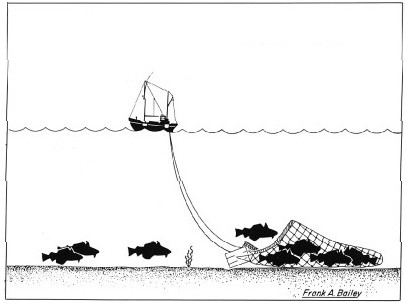
But after tugging the net’s cod end knot, it was not just prawns that ended up on deck’s sorting tray. Everything that lived along the sea floor was dragged into the net by the heavy chain that raked the sandy seabed.
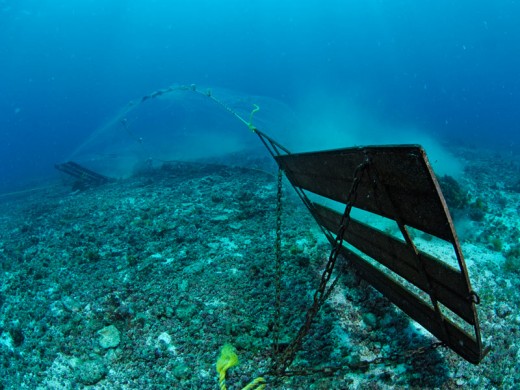 Trawlers raking the sea bed Trawlers raking the sea bed
[Source: http://marksecology.blogspot.com/2011/04/big-fish-review-part-2.html]
.
I recall the variety of creatures that were in the net, the fish, bugs, squids, the odd sting ray, sea snake and the sea urchins and marine sponges. I recall one occasion when the skipper had had to shoot a shark with his .303 which had got caught up in the net. I recall the marine sponges the most because of their strong seaweed like stench, and it was this stench in particular that caused me, a Victorian landlubber up until then, to become queasy. I was sea sick by the smell more so than the motion of the boat. I didn’t generally get sea sick.
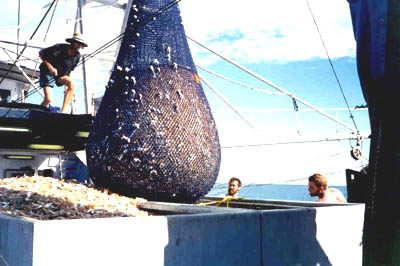
For those ten days on that small trawler for three shifts a night, we raked the seabed of its marine life. We only wanted the banana prawns which we sorted into white plastic tubs, covered with ice and snap frozen in the freezer down below. The rest of the smelly marine creatures we tossed back overboard – dead.

I recall watching the depth sounder next to the boat’s wheel, displaying the colourful array of marine life activity (prawns).
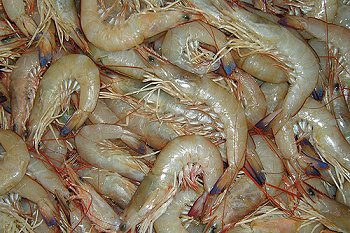
But then later in the trip there were no colours, just a blank screen, so we headed back to Townsville. The sea bed was just sand after our chain had dragged and raked the sea bottom. Nothing was left alive.
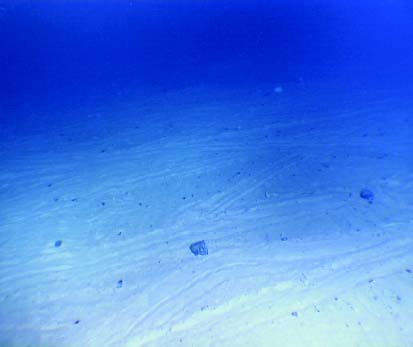 Typical sea bed after trawling Typical sea bed after trawling
Though hard manual labour and night shifts, the whole trawling process was pretty straight forward – head out to sea, throw the net over, trawl for three hours, haul in, sort the prawns from the rest, freeze ’em, then after the freezer was full head back in sell ’em and go to the pub. A simple life.
That was my brief introduction to Queensland prawn trawling. Yet looking back, the Charada was just one of hundreds of prawn trawlers that plied the Queensland coastline. It was just ten days out of many years and decades of similar fishermen doing their trade since perhaps the 19th Century. One must consider then how can there be any marine life left in Queensland inside the Great Barrier Reef? At the age of twenty three I just accepted that trawling was a normal legitimate Queensland industry. I hadn’t considered the environmental impact at the time. The work was there.
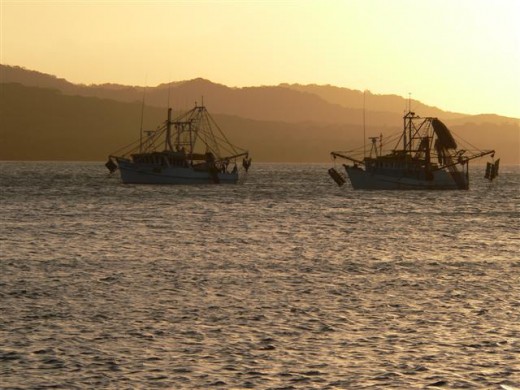
.
.
For years the Queensland Fisheries Service (QFS) has assured that commercial prawn trawling has met strict environmental guidelines. This has supported the prawn industry continuing to earn lucrative revenues from both domestic and export markets. This has been reassuring, after all the World Heritage listed Great Barrier Reef is not far away.
In 2005, Queensland’s Fisheries Research and Development Corporation (FRDC) and Fisheries Queensland jointly funded a marine research project called ‘Reducing the impact of Queensland’s trawl fisheries on protected sea‘. This research project measured the incidental catch and fishing mortality of sea snakes in the Queensland trawl fishery.
By 2008, the project had concluded that about 105,000 sea snakes were being caught annually in the fishery, with about 26% dying as a result. The effect of bycatch reduction devices (BRDs) on the catch rates of sea snakes and prawns was also evaluated, as part of the project. One BRD in particular, known as the fisheye BRD, was highly effective at excluding sea snakes from trawl nets, with no reduction in prawn catch rates. As a result of the project, trawler operators are now being encouraged to install fisheye BRDs in their nets to reduce their impacts on these protected snakes.’
[Source: Queensland Department of Primary Industries and Fisheries, ^ http://www.dpi.qld.gov.au/28_5193.htm ]

Example of sea snakes caught in catch
.
.
.
So all that unwanted marine life we had been throwing overboard the Charada was officially termed ‘bycatch‘. Sea snakes are protected species in Australia and therefore measures need to be implemented to minimise commercial fishing impacts on them, plus the many other bycatch that may happened to be threatened and endangered.
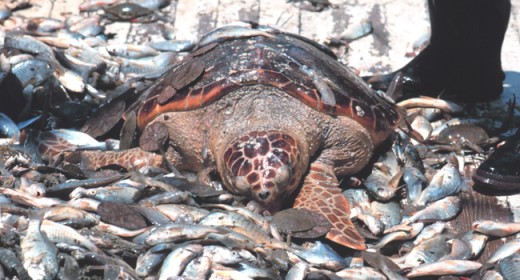
.
.
Then yesterday The Queensland Times reported the following article:
.
‘Net fishing damaging marine life’
.
[Source: ‘Net fishing damaging marine life’, The Queensland Times, 20110803, ^http://www.qt.com.au/story/2011/08/03/net-fishing-damaging-marine-life-report/ , accessed 20110804]
.
‘Trawler fishing is devastating slow growing marine life and damaging Australia’s oceans, a new report has found.
The study by environmental consultancy J Diversity has found that seafloor fishing and gill netting is “indiscriminate” in its impact on marine life.
Less than five per cent of Australian waters are protected from fishing and mining. It found in the south-west marine region gill nets up to eight kilometres wide are decimating shark and ray species.
NT Environment Centre director Stuart Blanch said the practice of trawling is as destructive as the clear-felling of forests on land and “death nets” must not further damage feeding and breeding areas for marine life.
“Trawling is one of most indiscriminate fishing methods. It produces only two per cent of wild fish harvest but up to one third of its bycatch,” Dr Blanch said.
The report says the WA South Coast Shark Fishery and Great Australian Bight Trawl Fishery catch at least 34 and 50 shark and ray species but discard around one third of the catch. It also says most Australian stocks have been fished to between 20 to 40 per cent of their unfished biomass, below the threshold of 75 per cent recommended by scientists to ensure fish stocks are conserved. Gavan McFadzean from The Wilderness Society called on federal Environment Minister Tony Burke to rule out any move that would benefit seafloor trawling or gill net fishing in new marine sanctuaries.
“If the Minister allows these death nets into important feeding and breeding areas, he would undermine the government’s election commitment to improve protection of our marine life,” he said.
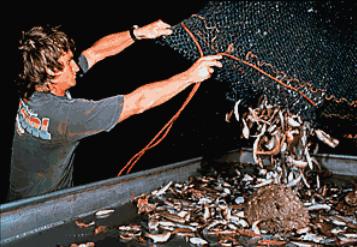 Brings back memories of my ten days on the prawn trawler Brings back memories of my ten days on the prawn trawler
.
.
Back in 1987, at age 23 I was clearly naive about what I was involved in, but governments and fisheries cannot feign naivety.
.
Yesterday’s response comment by ‘Atrax’ from Maroochydore is apt:
.
“Gees it took a new megabucks report to tell you this?
We sure have some geniuses in the Australian Marine management departments.
Of course it damages marine habitat and spawning sites.
This has only been known for the last 50 years, they banned Scallop dredging in Port Phillip bay because of this 35 years ago.
The bycatch destroyed in purse seine and gill netting is mind blowing.
Just shows how useless the drones in these departments really are.”

.
.
‘Satellite images reveal trawling damage’
.
[by Robert Shikina, rshikina@starbulletin.com, ^http://archives.starbulletin.com/2008/02/25/news/story01.html, accessed 20110804]
.
‘Bottom trawling, a fishing practice that involves dragging a net along the seabed behind a boat, causes extensive damage that can even be seen from space, a Hawaii scientist reports.
“There is a massive amount of mud that gets kicked up,” said Les Watling, a professor of zoology at the University of Hawaii.
He joined other scientists in a presentation on the problem last week in Boston at the annual meeting of the American Association for the Advancement of Science.
Trawling is not a problem in the deep waters around Hawaii, since the method is used in waters less than about a mile deep, but areas where it is used sustain a significant loss of marine life, he said. “It does more harm to the sea floor than any other kind of fishing, and now we have images from space showing how much sediment it lofts into the water column,” added Elliot Norse, president of Marine Conservation Biology Institute.
A University of Hawaii zoologist is among a group of scientists decrying the destructive effects of bottom trawling, a type of fishing, visible in satellite images from space. “We’re hoping that people will have a look,” said Les Watling, a professor of zoology at the University of Hawaii. “There is a massive amount of mud that gets kicked up.”
The satellite images of mud trails kicked up by bottom trawling are available on the Web site www.skytruth.org, inside the gallery and labeled as “trawling impacts.”
Watling, who has been working for about 15 years on limiting the effects of trawling, added that 99 percent of the areas that are trawled cannot be seen by a satellite. He was a panelist in a session that discussed the effects from bottom trawling at the annual meeting of the American Association for the Advancement of Science this month in Boston. Since trawling cannot be done in waters deeper than 6,500 feet, it is not a problem around Hawaii, but in areas where it is used, there is usually a significant loss of marine life, scientists say. Trawling equipment can be about 150 feet across and weigh half a ton. In its wake the trawling nets leave nothing but rubble, killing sponges and coral on the sea floor. Bottom trawling is used to catch shrimp and other bottom fish such as cod.
“Trawling removes much of the life from the sea floor,” said Elliot Norse, president of Marine Conservation Biology Institute, who participated in the session.
.
“The effect is basically to denude the sea floor.”
.

He said bottom trawling catches more unwanted fish and does more harm to the sea floor than any other kind of fishing. The sediment disturbing the water column can also clog fish gills, possibly reintroduce absorbed carbon into the water and kick up toxic materials that have settled to the bottom, Norse said.
“Now we have images from space showing how much sediment it lofts into the water column,” he said. “Not just affecting the sea floor, it also affects the water column.”
Ten years ago, Norse and Watling completed a study that found bottom trawling covers an area the size of the continental United States every year. John Amos, president of skytruth.org, used the detail in satellite images from Google Earth to discern the fishing vessels creating the squiggly sediment trails from bottom trawling. He gathered satellite images from the U.S. Geological Survey of fishers using bottom trawling in the Gulf of Mexico and China.
“I think that what’s exciting about this imagery is it’s one of the few examples where we can provide people with visual truth of what we’re doing to the oceans,” Amos said. “Imagery from space can actually show what we’re doing to the bottom of the ocean floor. When you show people images they understand, they get it in ways that thousands of pages of reports doesn’t quite communicate.”
.
– end of article –
.
.
Tags: bycatch, fish habitats, gill netting, Great Barrier Reef, inshore beam trawl fishery, Les Watling, Marine Conservation Biology Institute, marine habitat, marine sanctuaries, overfishing, prawn trawling, protected sea snakes, Queensland marine life, seafloor fishing
Posted in Threats from Fishing | No Comments »
Add this post to Del.icio.us - Digg
Leave a Reply
You must be logged in to post a comment.
July 30th, 2011
Australia has a flawed, hollow and at best, a casual democracy that only surfaces once every three or four years when the Australian people enjoy the right vote for a government to represent their best interests.
The Ku-ring-gai highrise impost by the New South Wales Labor Government between 2005 and 2011 blatantly revealed how undemocratic a government system we have and how vested corporate interests and party political whims are allowed to run roughshod over local community values.
Communities can learn from the Ku-ring-gai experience.
.
Revisiting NSW Labor’s sprawl alternative – highrise impost on ‘Ku-ring-gai’
.

‘Let’s all get behind FOT in this continuing fight for all of Ku-ring-gai.
Save our heritage for our children and grandchildren.‘
~ Isabel Lewis
.
Apt, prophetic words by Isabel; but they resonate well beyond Ku-ring-gai, an established leafy residential area of Sydney’s North Shore.
.
.
What’s driving Australia’s urban housing demand?
.
Ku-ring-gai is a microcosm of what has been steadily inflicted upon neighbourhoods across Australia’s capital cities, directly driven by federal uncontrolled immigration policy. Australia’s Federal Department of Immigration does not factor ‘carrying capacity‘ or ‘public infrastructure‘ (more housing, hospitals, schools, transport) into its immigration policy, or social and environmental impacts. They’re dismissed as State problems.
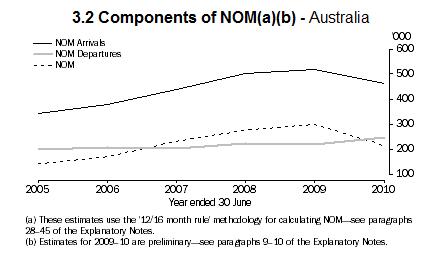 Australia’s Net Overseas Migration (NOM)
(Australian Bureau of Statistics)
Australia’s Net Overseas Migration (NOM)
(Australian Bureau of Statistics)
.
The bush fringe outlying Australia’s capital cities is succumbing steadily to the urban fringe. ‘Housing values‘ euphemistically propagandised as ‘affordable housing‘ override ‘ecological values‘ in human eyes, because humans think they have a preconceived god-given right to breed, proliferate and colonise. Australia’s national uncontrolled immigration policy that has been unchecked for decades by successive Labor and Liberal federal governments, has been the key driver of unrelenting housing property demand in Australia’s capital cities, much to the benefit of corporate developers, who are only too ready to donate generously to the coffers of both complicit political parties. It’s all become very corrupt and locals are losing their valuable leafy neighbourhoods to towering high rise.
The corporate developers, lead by the likes of corporate developer lobby groups Urban Development Institute of Australia and the Urban Task Force cleverly propagate this as ‘unlocking land for housing‘. To the rest of us, it’s called ‘sprawl’.
And it’s urban sprawl because its the big cities that the bulk of the demand, the economic immigrants, want to live. Sydney, Melbourne, Brisbane and Perth have consequently become swamped by unsustainable housing demand.“An independent report prepared for NSW Planning said the city would require an extra 640,000 homes over the next 20 years as the city’s population increased by at least 1.1 million to 5.3 million.
A Centre for International Economics report has found that under a 50:50 ratio between greenfield and established sites, construction of houses on the city’s fringe would cost the State an extra $5 billion for infrastructure over the next 20 years. Building more homes in areas surrounding Rouse Hill in the northwest and Camden in the southwest would incur more than $2.3 billion in extra transport costs and $724 million for water and electricity connections, it said.” [Read More]
 Net Economic Immigration into Australia averages around 200,000 every year
Over 1.2 million immigrants in the past six years!
Net Economic Immigration into Australia averages around 200,000 every year
Over 1.2 million immigrants in the past six years!
Nearly all settle in urban Sydney, Melbourne, Perth and Brisbane.
.
Frankly, Australia’s mainstream media’s current pre-occupation with the volume of new asylum seekers/refugees arriving by boats is a red herring distraction and propaganda beat up. Australia in the past year has received well less than 10,000 asylum seekers/refugees. This is comparatively few by international standards.
More importantly, the numbers are comparatively few in relation to Australia’s annual economic immigrant numbers. Asylum seekers represent a small fraction of Australia growing population problem.
While the mainstream media and federal politicians are distracted in a froth over the pennies, they are ignoring the pounds. Why! Vested interests are driving Australia’s economic immigration at record levels, and it is all about economic outcomes and nothing about social outcomes.
.
.
How are State governments coping with overpopulation?
.
Well in New South Wales they’re frankly not coping.
The current O’Farrell Liberal-National coalition government is trying to cope with the immigration fueled housing property demand attacking Sydney by reverting to the classic outer suburban sprawl, reminiscent of the 1960s and 70s.
In the lead up to the 2011 NSW election, O’Farrell spruiked pushing more of the city’s new housing developments to the urban fringe, aka ‘sprawl’. His “Sydney development strategy would force more than 550,000 people into the western suburbs and require an extra 128,000 homes to be built on the city’s fringes“. O’Farrell was reacting to the incumbent Labor Government’s policy of medium- and high-density development being concentrated along the rail corridor through his electorate of Ku-ring-gai.
The Centre for International Economics report prepared for NSW Planning said the city would require an extra 640,000 homes over the next 20 years as the city’s population increased by at least 1.1 million to 5.3 million.
[Source: ‘O’Farrell’s housing plan sinks in the west‘, by Barclay Crawford, The Sunday Telegraph, 20110213, ^http://www.dailytelegraph.com.au/news/indepth/ofarrells-housing-plan-sinks-in-the-west/story-fn58y44f-1226005046481]
.
Now in government, O’Farrell has identified “key growth areas“, is “speeding up the land rezoning process” and will “unlock more land for housing development“. This month, O’Farrell announced that up to 13,000 homes in Sydney’s growth centres (Marsden Park (some 10,000 houses in Sydney’s outer north-west) and Catherine Field (some 3000 houses in Sydney’s outer south-west) would be “released” for greenfield housing development. And with the new government, the new Department of Planning has new consultants and not surprisingly the unpalatable realism of ‘sprawl’ has received new euphemistic branding. It is the government’s ‘Precinct Acceleration Protocol‘ (a new acronym ‘PAP‘)…”to speed up the rezoning of growth centre precincts”. Not surprisingly, the Urban Development Institute of Australia NSW, CEO Stephen Albin, said “it was a good step“. And the Urban Taskforce Australia’s CEO Aaron Gadiel, said “the government plan was positive“. But not surprisingly, they both want more land to be ‘unlocked’!
[Source: ‘O’Farrell unlocks land for 13,000 homes‘, by Anna Patty, Sydney Morning Herald, 20110713, ^http://www.smh.com.au/nsw/ofarrell-unlocks-land-for-13000-homes-20110712-1hcch.html, accessed 20110731]
It is not just Sydney that is struggling. Melbourne, Brisbane and Perth are losing the battle to cope with unrelenting population increases and demand for public services and infrastructur.
While state and local governments across Australia are failing to cope with the spiraling housing demand, no-one in government is questioning the demand itself. While state and local governments can’t keep up with the sand bagging tactical response, the broader population tide is unrelenting. The flood gates are being kept open by Canberra. Since few immigrants want to go to Canberra (unknown to immigrants, too cold, not enough work), looking out the window in Canberra, the population problem is not apparent to the politicians.
A 2011 report by the National Housing Supply Council estimating Australia to have a shortfall of 178,400 properties across the country, and forecast shortfall of 640,600 by 2028. [Read More] Hardly any of that will be in Canberra.
The pressures imposed on state and local governments to accommodate the human hoards is nationally the most pressing economic, social and environmental problem of the 21st Century; not climate change.
.
.
‘Immigration is just another dirty word’
[by Jennifer Hewett, The Australian newspaper, 20100723, ^http://www.theaustralian.com.au/national-affairs/immigration-is-just-another-dirty-word/story-fn59niix-1225896226208]
Increasing congestion is causing concern among the residents of Sydney’s western suburbs.
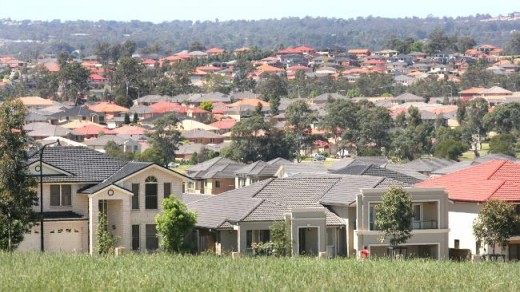 Sydney’s Western Sprawl
(Photo by Dean Marzolla) Sydney’s Western Sprawl
(Photo by Dean Marzolla)
‘Lunchtime midweek in Campbelltown’s main street in the heart of western Sydney is a slow-moving affair. Cars drive in and out of the one-way street at a leisurely pace. Business is not exactly booming in most of the small, tired-looking shops. There’s plenty of room on the footpath for pedestrians. But underneath the languor, there’s a much more heated mood – particularly when it comes to immigration in general and boatpeople in particular.”It’s just too much,” says one woman. “Sometimes I don’t feel I’m in Australia any more. And the land can’t take it.”
A few metres away, Jeanette Creedon is waiting for customers in the discount clothing shop she runs. She regularly travels to other shops in the chain and says the congestion is terrible.
“It takes me 2 1/2 hours to drive sometimes. But I have given up on the train. It’s like being a sardine and it’s not clean or healthy,” she says. “Immigrants get so many freebies when they get here and there’s plenty of Australians who need a helping hand. And the government desperately needs to do something about boatpeople.”
It’s views such as these that have Julia Gillard hurrying to the neighbouring electorate this same day to address western Sydney’s conveniently timed national population summit. Campelltown is in Macarthur, currently held by the Liberals with a margin of 0.1 per cent. It is one of a swag of vulnerable seats Labor needs to nail down in a region the Prime Minister delicately suggests is reaching capacity.
The new ultimate PC phrase in Canberra is “sustainable population“. The coded message is the need to cut back on immigration. That is even though Gillard refuses to spell out the logic of her position that Australia’s present growth path is “irresponsible“. No, she says, it’s not a debate about immigration. Oh sure.
Instead she relies on a siren song meant to calm the anger about inadequate services and crowded roads and trains without committing her government to anything concrete.
She says she will focus on “preserving the quality of life of our Australian sanctuary“. She emphasises that she does not believe in “hurtling down the path to a big Australia“. She says it’s time to question assumptions and values that haven’t changed since the beginning of the post-war period (and the start of Australia’s hugely successful mass immigration program).
“It is time to consider whether our model of growth is right for an Australia facing fundamental constraints on our water supplies,” the Prime Minister tells the conference. And, of course, fundamental constraints in areas such as transport.
“If you listen to people in places like Campelltown, Penrith, Parramatta or any of the many suburbs in between, I suspect many of them would say to you, yes, Australia is the world’s best country,” she says.
“But I suspect many would also say, year by year, it’s getting a bit harder . . . more time on the road, less time with the kids . . . They wonder how many more people can fit on the sardine express to Central, Town Hall, Wynyard. And on our motorways and roads, they could be forgiven for thinking they’d got in the car in Penrith but were caught in traffic in Los Angeles.”
Yet rather than suggest the real problem is that government, especially the NSW state Labor government, has been totally unprepared to deal with the pressures of an ever-expanding city, it’s much easier to talk vaguely about the need for sustainable population and nostalgically about Australia as a land of openness and space.
Her former close colleague, ex-Labor leader Mark Latham, a long-time resident of western Sydney, has been quick to accuse the Prime Minister of running a phoney population campaign.
“If it’s not an immigration debate, it’s no debate, ” he tells Sky News. “And I’ll tell you what it is, it’s a fraud. It’s an attempt to con the people of western Sydney she’s going to do something about congestion.”
Labor is clearly reluctant, so far at least, to follow the Liberals’ tack and commit to an actual cap on immigration numbers as a way of “getting population under control“. But the Liberals are leaving it up to the Productivity Commission to determine the numbers. And if the commission comes up with the obvious point that economic growth requires high levels of skilled immigration, it will all be conveniently post-election.
The government has established three expert panels with impressive titles: Demographic Change and Liveability, Productivity and Prosperity, and Sustainable Development. Tony Burke, in the new position of Minister for Sustainable Population, will also put out a strategy paper — but, of course, later in the year.
For now, both sides appreciate that this issue has been brewing a long time, particularly in the outer suburbs, and is one of the most sensitive of the election campaign.
Bob Birrell, a professor at Monash University and a prominent demographer, tells The Australian the public’s mood is finally reaching the ears of the politicians.
“Their concerns about the costs of population growth, issues such as congestion and housing, are real,” he says.
But it’s also an issue in which reality mocks the repetitive soundbites of an election campaign.
In essence, it requires recognition that Australia has prospered for decades on the back of a strong immigration policy and that the economy will continue to need high levels of skilled immigration if it is to continue to grow in a truly sustainable way.
Immigration has helped, for example, to keep the mining boom going without a wages explosion that would increase inflation pressures and interest rates.
Immigration also provided some of the economic momentum to help shield the economy from recession during the global financial crisis. Yet governments have resisted the need to make sure services and infrastructure keep up with the demands of a steadily increasing population, most obvious in areas such as the outer suburbs of Sydney and the high-growth areas of southeast Queensland.
Add concerns about the fragility of Australia’s environment, a spike in immigration numbers in recent years and, most explosive of all, a surge in the boats coming, and the politics has turned toxic.
Many voters, even those in comfortable inner-city middle-class suburbs where apartment blocks are steadily replacing houses, feel uneasy about where it will all all end.
They want jobs for their kids and the opportunities of growth without the hassle.
It doesn’t help this notion of being crowded out when Australia’s pattern of population has been to cluster in big cities, making it one of the most highly urbanised countries in the world.
But the Labor government seems to have no stomach to argue either the economic virtues or the inevitability of continuing high immigration. That vacuum is allowing the perfect political storm to develop.
The 36 million figure by 2050 that got everyone so agitated, for example, came from Treasury’s Intergenerational Report last year. It was merely an extrapolation of current trends based on the fertility rate and an average net increase of 180,000 a year from immigration. The figure actually required Australian population growth to slow to an increase of 1.2 per cent a year from the 1.4 average of the past 40 years. Kevin Rudd initially embraced this but Labor has been rowing backwards ever since.
It’s significant that net immigration in recent years has been much bigger than the official 180,000 permanent intake – with a net figure of 300,000 last financial year. This was largely due to skewing of the temporary visa system for overseas students, which has been belatedly tightened to avoid it becoming the easy route to permanent immigrant status. The change in the student visa system and the government’s tightening of requirements for business visas were always going to bring down the 300,000 figure quickly.
But what it doesn’t do is fix the skills shortages that are already a constant for employers and will continue to be a natural outcome of the growth of the economy. In Western Australia, the unemployment rate is back to 4 per cent already. This shortage will become more apparent in the next decade given the demographic time bomb of an ageing population.
The Australian Chamber of Commerce and Industry’s Peter Anderson says it is difficult to get rational debate in an election campaign, particularly when the issue of border protection is mixed up with the need for skilled migration and broader population policy.
“This is very damaging to the national interest because it fails to recognise our economy requires a judicious mix of skilled migration and natural increase for the next 50 years,” he says. “Our growth forecasts on returning the budget to surplus and improving our standard of living depend on our economy getting bigger, and that requires skilled migration.”
The corollary, of course, is to do more to train the Australian workforce. It’s a requirement simultaneously pushed, not coincidentally, by Gillard as she unveiled extremely modest measures last week to help schoolchildren choosing a trade as a career.
For all the talk of an education revolution, Labor’s approach has been, at best, a modest and often ineffective way of addressing skills shortages.
Over time, Australia’s immigration numbers tend to go up and down according to the economic cycle. Assuming Labor and the Liberals are neither projecting nor wanting a big downturn in the economy, it will require high levels of immigration to continue before any long-term investment in roads and the rail system begins to emerge.
The government is trying to negotiate though this dilemma by suggesting immigrants will be encouraged to go to regional areas rather than the outer suburbs of Australian cities. In most cases, this will remain a political dream.
In a state such as Western Australia, for example, the fly-in fly-out worker from Perth is the standard. In Queensland, there’s more spread of population in terms of mining towns but the real pressure is on the southeast, dominated by an influx of homegrown refugees from other states. In Sydney, immigrants are not suddenly going to decide the best job opportunities are in small rural towns that Australians are leaving.
Nor are most people going to follow the now discredited Bob Carr theory, which declared Sydney was full and attempted to prevent urban sprawl by making it prohibitively expensive to build houses there, while neglecting infrastructure and focusing on higher-density housing in inner-city areas.
The only option is to accept the reality that Australian cities will continue to grow, to try to develop more job opportunities and work centres in outer suburban areas and to build the infrastructure that will enable people to live and breathe more easily.
Just don’t expect any of that to come out of this election campaign.’
.
.
Lessons from NSW Labor’s highrise impost on Ku-ring-gai
.
Just two years ago in 2009, the then NSW Labor Planning Minister, Kristina Keneally projected:
“Sydney will grow and it will change … it is projected to reach a population of about 6 million by 2036, up by about 1.7 million people from 2006.”
.
Yet, instead of questioning or challenging the human population growth, the NSW Labor Government accepted it in its limited short term perspective of providing cheap economic demand. Labor opted away from pursuing outer urban sprawl due to the costly infrastructure it would require. Labor’s accommodating strategy was to concentrate the population growth along existing transport corridors.
Since it knew it would never win Sydney’s leafy Liberal blue ribbon seat of Ku-ring-gai for votes, Labor chose Ku-ring-gai for major high density high rise development. Labor’s unpopularity in Ku-ring-gai was cemented two years later in the NSW Election of 2011. Barry O’Farrell’s Liberal/National Coalition secured 87% of the vote.
Meanwhile, Labor introduced land use planning legislation that flatly ran roughshod over local councils and residents. In Ku-ring-gai the affected suburbs included Gordon, Killara, Lindfield, Turramurra, Wahroonga, Pymble, Roseville and St. Ives.
The following extracts, articles and photos are testament to what happened next to leafy Ku-ring-gai.
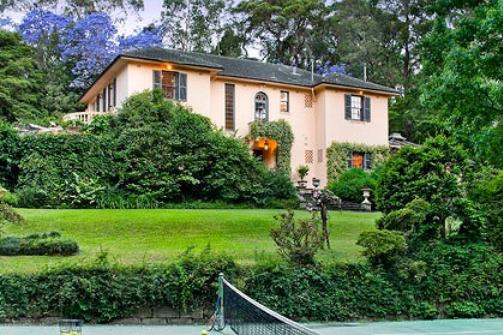
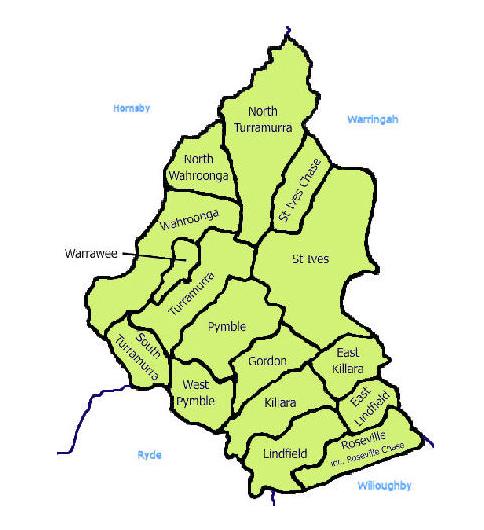
 Ku-ring-gai’s leafy amenity
Gardens established over a century by generations of residents
Ku-ring-gai’s leafy amenity
Gardens established over a century by generations of residents
.
. Turramurra landscape
Turramurra landscape
.
.
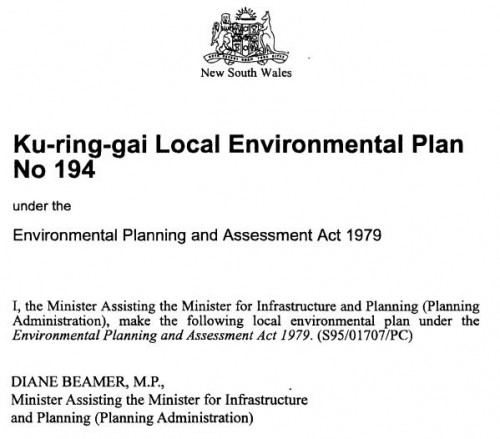
The highrise impost on Ku-ring-gai started back in the days of NSW Labor Premier Bob Carr who was anti-sprawl. His Planning Minister in 2004, Diane Beamer MP, signed off on a new planning instrument for Ku-ring-gai – the infamous ‘Local Environment Plan 194‘. Its main impost was to rezone the rail corridor through Ku-ring-gai into allowing “multi-unit housing” (read ‘highrise’) development under the guise of “providing increased housing choice” (Ref. Div 3 ‘Aims and Objectives‘).
The following year in 2005, the Carr Labor Government introduced its notoriously undemocratic Part 3A planning provision for New South Wales, which legally handed the New South Wales Planning Minister consent authority (read ‘absolute power’) for major projects deemed to be of state or regional significance. Of course, many developers made sure that their projects became deemed to be ‘State Significant‘. The new law allowed the State Government to overrule local planning objectives and zoning rules and ignore the rights of local councils and their communities. Carr then resigned and left the mess.
Under Planning Minister Frank Sartor, in the 2007-08 financial year, 295 of the 296 applications were approved under Part 3A, despite over 14,000 public submissions being received, most opposing projects on environmental and/or heritage grounds.
“If you get your project called in under Part 3A you can’t lose really,” said Sylvia Hale, NSW Greens MP and Planning spokesperson. “It is virtually certain your project will be approved.” [Source: ^http://nonewcoal.greens.org.au/on-the-burner/part-3a-99.6-of-projects-approved, 20081120]
Then once Kristina Keneally became Planning Minister from October 2009, she approved ninety Part 3A projects within the first five months. “The rush of approvals makes Frank Sartor look like a rank amateur,” the Opposition’s planning spokesman, Brad Hazzard, said. One in 10 of the major projects approved since Ms Keneally became minister involve donors to the ALP.’ [Source: ^http://nonewcoal.greens.org.au/on-the-burner/new-minister-hastens-developer-approvals]..
.
‘Concrete raiders of a stately Eden’
[by Wendy Frew, 20080823, ^http://www.smh.com.au/news/national/concrete-raiders-of-a-stately-eden/2008/08/22/1219262525172.html]
Privacy destroyed … Jenny Lim waters the front garden of her much-loved Lindfield home of 12 years, newly hemmed in by apartment blocks.
 The developers go to town in Lindfield and privacy is destroyed by highrise
(Photo by Bob Pearce) The developers go to town in Lindfield and privacy is destroyed by highrise
(Photo by Bob Pearce)
Residents of the rapidly growing district of Ku-ring-gai believe they have been forsaken for the developer’s dollar. On the quiet, leafy streets of Ku-ring-gai, on Sydney’s upper North Shore, the houses are shaded by a canopy of native trees, the shopping centres have the air of a country village, and the whole area is enveloped in a well-heeled, conservative hush.
This is the landscape that inspired the watercolours of Grace Cossington Smith and Ethel Turner’s classic childhood book Seven Little Australians.
But Ku-ring-gai’s suburban nirvana is at risk, according to residents, who say both the State Labor Government and Ku-ring-gai Council have forsaken them for the developer’s dollar.
.
The Government’s planning philosophy for all of Sydney:
Build high-rise apartments along railway lines to avoid urban sprawl!
.
– could not be more damaging for Ku-ring-gai, say residents, because that is where some of the best examples of heritage homes can be found.
In the past four years, development applications for more than 3600 units worth more than $2 billion have been approved for the area.
That has gone a long way to meet the Government’s Metropolitan Strategy requiring Ku-ring-gai to provide an extra 10,000 new dwellings by 2031.
.
The Planning Minister, Frank Sartor, says ‘Ku-ring-gai must accept its share of Sydney’s growth‘, but the Mayor of Ku-ring-gai, Nick Ebbeck, worries that nothing his council does will satiate the Government’s desire to push more people and higher apartment blocks into this traditionally blue-ribbon territory.
Regardless of the merits of urban consolidation, the changes will rewrite the map of Ku-ring-gai. Block by block, rezonings are allowing polished concrete blocks to replace the stately homes of the 1920s, ’30s and ’40s.
Where the zonings have been changed, people are selling their homes to developers rather than live in a street that has lost its charm.
Those who have stayed, such as Jenny and Beng Lim, have found themselves squeezed between buildings that look more like office blocks than apartments.
When the Lims moved to their California bungalow in Burleigh Street, Lindfield, 12 years ago, there was no hint of what was to come. Back then, there were 10 bungalow homes in the street and little traffic. Today only two houses are left, a massive apartment block looms over their backyard, and two more five-storey buildings are going up across the road.
Mrs Lim worries about the influx of residents and traffic the developments will bring.
“It is a hard decision to make but I believe we will stay put,” she says. “We have put a lot of effort into the house. It is a home, not just a house.”
The developers are destroying the very features that attract people to the area, according to the residents group Friends of Ku-ring-gai Environment.
“It is like they are chopping out great chunks of the character of these suburbs. There will be no heritage left worth protecting,” says the group’s vice-president, Kathy Cowley. “Liberal and Labor are exactly the same on this issue and that is why we have no allies in this battle.”
Two years ago, the group became so concerned at the pace of development across Ku-ring-gai’s nine suburbs that they began to photograph what was being lost. Half the 4000 photographs they took will be included in a book soon to be published that documents the area’s inter-war heritage buildings, such as the Walter Burley Griffin house in Marion Street, Killara, and The Oaks, a large Federation house with turrets and detailed fretwork, on the Pacific Highway.
Mr Sartor denies the planning strategy will change the area’s character. “I don’t think they have been asked to do an unfair thing,” he told the Herald, adding that any complaints about the design of the buildings should made to Ku-ring-gai Council because it had approved most of the development applications.
“The local interests are legitimate but so is the issue of Sydney’s carbon footprint.”
Cr Ebbeck, who with some other Ku-ring-gai councillors stood as an independent but is a member of the Liberal Party, says the rezonings will affect about 5per cent of the community and dramatically change the character only of areas along the transport corridor. “The bad news is that it is where all our heritage is.”
Cr Ebbeck says the council has tried to work with the Government on the planning changes, but it still waiting for the minister to approve special heritage zonings suggested by the council.
“I am not against development but I am against this crass way of doing it, this one-size-fits-all approach,” he said.’
 Cheap and nasty precast concrete panel design
It may be pragmatic in the Abu Dhabi desert, but it is out of place in Federation Ku-ring-gai Cheap and nasty precast concrete panel design
It may be pragmatic in the Abu Dhabi desert, but it is out of place in Federation Ku-ring-gai
 Precast Concrete Panel highrise in Sydney’s Liverpool
An industrial amenity threat to Ku-ring-gai Precast Concrete Panel highrise in Sydney’s Liverpool
An industrial amenity threat to Ku-ring-gai
.
.
‘Friendless and furious: Ku-ring-gai fights for life’
[by David Marr, 20090919, Sydney Morning Herald, ^http://www.smh.com.au/national/friendless-and-furious-kuringgai-fights-for-life-20090918-fvcr.html].
“The word was Ku-ring-gai had it coming to them“…Kathy Crowley illustrates the problem the suburb faces. Stripped of any say in how it is developed, the north shore is battling on alone to save its heritage, writes David Marr.
“We’ll see plenty of disasters,” said the deputy mayor as the minibus pulled out of the Ku-ring-gai Council Chambers. The small party had accepted the council’s invitation “to witness firsthand the impacts of state-imposed over-development on this beautiful part of Sydney”.
It’s blossom time. The crab apples are flowering at full throttle. Freesias are poking through the lawns. Magnolias are coming into leaf. Everything about this scene is familiar from my childhood except the glimpse now and again of swing cranes hovering above the houses.
The bus takes us into cul-de-sacs packed with five-storey blocks of apartments; to council car parks slated for nine-storeys of shops and flats; down streets where Meriton and Mirvac have done their familiar work; and past rows of houses with that graveyard look buildings wear waiting for demolition. In the bus they are saying: bad as this looks it’s only the beginning.
That new apartments have to be built in these suburbs strung along the railway line from Roseville to Wahroonga is no longer seriously challenged. But Ku-ring-gai has been effectively stripped of any say in what’s happening here. Approval to build apartment blocks has been taken out of its hands.
Heritage protections are among the most meagre in NSW and the appetite for development here is ravenous. Projects worth about $2 billion have been or are nearing completion in these prosperous streets. Ku-ring-gai is a new El Dorado for development in NSW.
But it’s also a joke. Deeper than its problems with bricks-and-mortar is Ku-ring-gai’s struggle to be taken seriously. Few chunks of the city have so few allies. Sydney celebrates the preservation of Paddington and rallied to save Haberfield’s streets, but outside the confines of its own suburbs, the “leafy north shore” is regarded as home to rich folk who don’t want to suffer as other suburbs have suffered, intractable NIMBYs.
Some of that is true. Ku-ring-gai fought tooth and nail against ”dual occupancy” and medium-density developments for the elderly in the 1980s and early 1990s as if they meant the end of the world. These suburbs weren’t alone in these early brawls against urban consolidation.
So much antagonism built up across Sydney that Nick Greiner in 1988 and Bob Carr in 1995 both came to power with the mantra that planning was to be handed back to the people.
Such promises are rarely kept in Sydney. The Carr government soon decreed that half a million new “dwellings” were to be inserted into the city’s suburbs. Local councils were only free to pick the precincts where these new apartments and townhouses would go. Ku-ring-gai’s plans were rejected in 1996 and 1997. A third strategy in 1998 was abandoned.
Across Sydney, municipalities slowly made peace with the government. Not Ku-ring-gai. Bureaucrats from that time talk of a slow poisoning of the atmosphere, of blame on both sides, of frequent changes to plans, to politicians and to personnel that led eventually to a breakdown in dialogue.
“There was always the word coming back that Ku-ring-gai had it coming to them,” says Kathy Crowley of Lindfield, one of the few campaigners left standing after 20 years. She admits nearly every battle in those years has been lost. “We haven’t had terribly many victories – small ones, mainly local. It’s been a huge saga for people involved all this time. It’s very wearing.”
The people of Ku-ring-gai might be big figures in industry and the law, but under Labor they have no political clout in Macquarie Street. There are no kicks for beating up on Ku-ring-gai. Having Barry O’Farrell as their local member hasn’t helped either. Nothing will make these people vote against him, but on the biggest issue in his electorate O’Farrell scores very poorly.
“The general perception is that Barry hasn’t done enough,” says Mrs Cowley. “He hasn’t pulled up the Liberal councillors doing the wrong thing.” And the Liberals have supported most of the draconian planning powers the Labor Government has awarded itself year after year.
Peace might have broken out in 1999 when a new council led by a new group called the Ku-ring-gai Preservation Trust was elected. Despite the name, the council wasn’t digging in its heels. There was a new willingness to meet the government’s wishes. Studies were commissioned. Leading planners were engaged.
“The council reluctantly did what they had to do and they did it professionally,” says the planning consultant from Architectus who spent two years working on the plans. “But no very clear objectives were given them by the state government. The implicit target was 10,000 dwellings and then the Department of Planning would be off their backs. Everyone at the council spoke of 10,000,” he says. “But no one at the department did.”
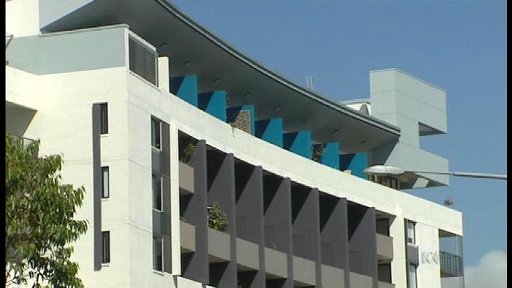 Precast Concrete Panel highrise for Ku-ring-gai Precast Concrete Panel highrise for Ku-ring-gai
At the core of this story is the reluctance – or perhaps the cunning – of the Department of Planning over that figure. What’s required of Ku-ring-gai was and remains rubbery. As local activist Don Brewer says: “Success was never defined.”
The Architectus scheme kept developments close to the railway stations along the ridge line. Four to five-storey buildings stepped down to meet their neighbours. Heritage neighbourhoods didn’t escape unscathed, but the sacrifices were minimal. Though the plan allowed for more than 12,000 new dwellings, it was rejected by the then planning minister Andrew Refshauge for offering “only very limited opportunities for provision of additional housing choice” and placing “unnecessarily restrictive” controls on development.
“Fundamentally you would have to say the council did what it was asked,” says Andrew Watson, who is now director of strategy and environment at Ku-ring-gai, but was then the department’s regional director in Western Sydney. “Council would to this day swear they have done exactly what they were asked and were treated unfairly and history will say that’s probably not an unfair interpretation.”
Finally gazetted by the government in 2004 was a brutally simple scheme known as LEP 194 allowing for five-storey apartments from edge to edge of the planning zones. No set backs. Individual heritage buildings would escape demolition, but there were none of the Urban Conservation Areas that protect swathes of Mosman, Woollahra and Hornsby. Indeed, Ku-ring-gai is at present one of only two municipalities in the state with no gazetted heritage protection for streetscapes and neighbourhoods.
What’s more – and again this was unique to Ku-ring-gai – all the development slated until 2031 could happen at once.
.
There was to be no co-ordination, no order. Open slather. Developers swooped, picking the eyes out of the rezoned neighbourhoods. Already built or under construction are 4500 apartments, nearly half the supposed final target. Hence the cranes flying over the blossom trees.
.
The purpose of our little bus tour early this week was to see what Local Environment Plan 194 has already achieved. Many of the apartments are fine. Suburbs all over Sydney would welcome blocks of this quality.
But there are many shockers –
“We think they’re designed in Singapore,” says Mr Brewer – and the interface between apartments and houses is brutal.
 Garish Precast Concrete Panel highrise imposed upon Ku-ring-gai Garish Precast Concrete Panel highrise imposed upon Ku-ring-gai
.
Big thinkers about the politics of necessary but painful planning changes make the point that residents need to know where the process will end. There needs to be a compact that once the sacrifices have been made, once the targets have been met, the residents and their community will be left alone. That’s absolutely not been the case in Ku-ring-gai. The Government keeps demanding more.
Even while LEP 194 was being haggled over, Refshauge announced that he had chosen six big sites scattered through the municipality for urban consolidation. And the day the LEP was gazetted, the new minister Craig Knowles directed Ku-ring-gai to go back to work and plan six new “town centres” along the railway line.
A fresh wave of horror swept the hills and valleys of the north shore. Once again the council prepared a plan to meet these targets and once again their plan was rejected by the minister – by this time the fractious Frank Sartor.
Developers effusively welcomed the fresh powers he was granted in the last weeks of the Carr regime. In March 2006, he was given further independent authority, this time to appoint – without inquiry or proof of corruption – a panel to take over most of the councils’ planning powers.
Ku-ring-gai was placed under a panel, one of three in NSW. Watson says: “This is the only council that has a panel it absolutely didn’t want and has fought tooth and nail.” A court challenge by the council failed in May 2008.
Imposing the panel provoked deep suspicions. In the ordinary run of things – ordinary, that is, in NSW – donations from Ku-ring-gai developers would be expected to flow to the majority party on the council. After a ferocious campaign in the 2004 local government elections, the Liberals were back in charge. “By appointing a planning panel to Ku-ring-gai,” argues activist Alan Parr, “the Labor Party effectively cuts off a revenue stream to the Liberal Party.”
In May this year, the panel presented its scheme for the town centres to a huge and unruly meeting in the auditorium of the UTS campus in Lindfield. This plan takes more care at its edges and for the first time gives heritage protection to neighbourhood blocks – not nearly as many as heritage experts have identified in past surveys for the National Trust and the council, but at least to a few.
The culture-breakers in the plans were the nine and 10-storey buildings on the sleepy – perhaps comatose – shopping centres of the upper North Shore.
How many new dwellings this represented is a matter of furious contention. Activists say the total has now crept up to about 18,000 with the possibility of many more if all the available development opportunities are taken up. Watson puts the number at 12,000.
But if the target figure ever really counted, it doesn’t count now. The chairwoman of the Planning Panel, Elizabeth Crouch, told the Herald: “We haven’t approached it on that basis. We’ve asked: what is a sensible planning outcome for properties within five or 10 minutes’ walk of the railway stations?”
Placards at the UTS meeting read “Time to stand up Barry”, ”Stop the rape of Ku-ring-gai”, ”Developer donations corrupt political parties”, ”Ku-ring-gai keep green not greed”, ”Trees not towers”. After three hours and 60 angry speakers, the Planning Panel retired to consider these representations and returned after four or five minutes to unanimously adopt the plan unaltered.
O’Farrell was there. He told the Herald: “These are people who live in Ku-ring-gai, who are law-abiding, who aren’t normally regarded as rabble-rousers, and this process … has driven them mad. We almost saw that come to blows.”
On September 27 a procession of hearses organised by Not So High, a new umbrella group of resident protesters, will wend its way down from Turramurra to the Domain to mark the Death of Democracy.
Come what may, it seems friendless Ku-ring-gai will be the seat of the premier in 18 months’ time. Developments worth hundreds of millions of dollars could be given the green light before then. No one there seems to have much faith that things will change radically if the Liberals come to power. O’Farrell is promising ”to return local planning control to local residents”.
 Promotional property development
to lure people into new medium density apartments Promotional property development
to lure people into new medium density apartments
.
.
Developer Donations
.
Indeed, donations from many property developers were forthcoming to the NSW Labor Party between 2003-07. According to the Greens NSW website ‘Democracy 4 Sale‘ the following corporations were major donors to the NSW Branch of the Labor Party between 2003-07 alone. Which ones had/have a stake in property development in Ku-ring-gai?
Click to see details of each…
.
- >Australand Holdings
- >Bradcorp Holdings
- >Builddev
- >Grocon
- >Holdmark Developers
- >Johnson Property Group
- >Leighton Holdings
- >Medich Property Group
- >Memo Corporation Australia
- >Meriton Apartments
- >Mirvac Group
- >Multiplex Group
- >Property Council of Australia
- >Rosecorp
- >St Hilliers
- >Stockland Trust
- >Terrace Tower Group
- >The Village Building Co
- >Thiess
- >Tiffany Developments
- >Togo Group
- >Transfield
- >United Group
- >Walker Corporation
- >Westfield
[Source: Greens NSW, Democracy4 Sale Project, ^http://www.democracy4sale.org, GoTo Search Donations > ‘Search NSW Election Funding Authority (NSWEFA) donations’, ^http://www.democracy4sale.org/index.php?option=com_content&view=article&id=206&Itemid=22, ‘The Democracy4sale project is an initiative of the Greens NSW. The Greens took a leading role in the campaign to reform political donations because we believe donations taint the democratic process – they allow big business to buy a level of access to politicians that ordinary people can’t afford.’ ]
‘National Trust warns on Ku-ring-gai Planning Panel plan’
[by Katrina Adamski, 20090814, ^http://north-shore-times.whereilive.com.au/news/story/high-density-plans-ripping/]
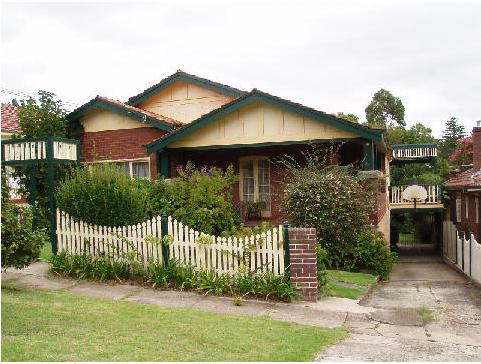 8 Burleigh Street, Lindfield demolished 8 Burleigh Street, Lindfield demolished
.
 2-8 Burleigh Street, Lindfield replacement 2-8 Burleigh Street, Lindfield replacement
.
‘The heart of Ku-ring-gai is being ripped out with the possible demolition of 692 heritage homes. This is the view of the National Trust, which has taken a stance against the Ku-ring-gai Planning Panel’s proposals to build medium- to high-density development in the area’s six town centres. The trust’s core programs director Scott Woodcock said its members were trying to protect the natural and cultural heritage of Ku-ring-gai.
“The scale and magnitude of the threat to heritage buildings is unprecedented,” Mr Woodcock said.
“The outrage is still prevalent in the community following the public meeting attended by 1000 people and more than 1800 submissions were received.
“At the National Trust, we are still receiving calls every day about what they can do to stop the Planning Minister (Kristina Keneally) from gazetting the plans. People have also been calling for us to organise a rally but we would prefer to speak to the minister first.”
Heritage buildings under threat of demolition in National Trust conservation areas include 1 Maclaurin Pde, Roseville; the Spanish mission-style church, 1186 Pacific Highway, Pymble; Tulkiyan 707 Pacific Highway, Gordon; and 2 Victoria St, Roseville.
The former Gordon home of Harbour Bridge designer John Bradfield could also be bulldozed under the proposal.
Mr Woodcock said people were rightly concerned about losing their homes or having a six-storey development built next door to them.
“The spectacular P&O-style house at 1 Maclaurin Parade is not on the council’s heritage list or in a council conservation area,” he said.
“It is within the trust’s urban conservation area, but even if it was individually saved, it would be surrounded by high-rise.
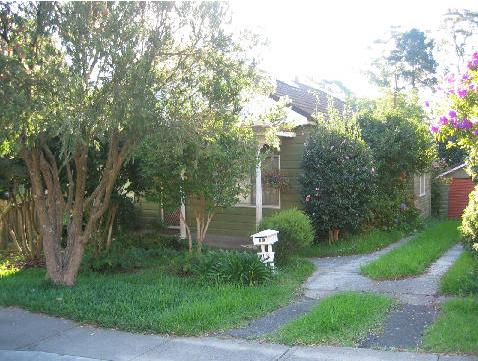 19 Moree Street, Gordon demolished 19 Moree Street, Gordon demolished
.
 11-19 Moree Street, Gordon replacement 11-19 Moree Street, Gordon replacement
.
“The church and Tulkiyan are listed by the council, but even if they were kept they could be surrounded by high-rise which would destroy their curtilage.
“Practically the whole of Victoria St, Roseville, is under threat between Hill St and Spearman St.
“Only the school isn’t zoned for higher density’‘
But Planning Minister Kristina Keneally said there was “no requirement’’ for the 700 heritage homes to be demolished.
“The plan actually introduces heritage conservation zones,’’ Ms Keneally said. “In fact, the Bradfield house is proposed for heritage listing under the plan put forward to the department.
“It is important to remember that these are people’s homes.
It is up to an individual home owner as to what they do with their property.’‘
The minister said the government was identifying places, particularly around rail lines, where increased density and a different housing type could be accommodated.
Ms Keneally said only 6per cent of Ku-ring-gai was covered by the town centres plan.
But Opposition Leader Barry O’Farrell said almost 80 per cent of Ku-ring-gai urban conservation areas would be destroyed under the State Government’s planning proposals.
Mr O’Farrell said the National Trust report confirmed Labor’s statewide attack on heritage conservation.
“(Premier) Nathan Rees and (Planning Minister) Kristina Keneally are the Bonnie and Clyde of NSW, stealing the heritage heart out of the state,’’ he said.
“These decisions are borne out of the inherent conflict of interest of a minister also being responsible for preservation of heritage items.’‘
He said the National Trust report was as close as you could get to a respected, independent umpire giving Labor a capital F for fail for its “lousy heritage credentials’‘.
He said the NSW Liberal/Nationals had already committed, when in office, to appoint a separate heritage minister.’
.
Comments:
by Denise Hendy (20090820):
‘The ‘planning committee’ meeting at UTS was an insult to our intelligence. It was a total farce from a bulldozer panel committed to wrecking Ku-ring-gai’s leafy outlook. I have recently rejoined the National Trust because I feel they need support from locals to keep this Government on track. I cant believe the State Government iis allowing our heritage to be torn down. Australia is a young country and has little heritage to show. Obviously these people have never been to visit old communites overseas to see the beauty and wonder of heritage which is important for younger generations to see and realise our history.’
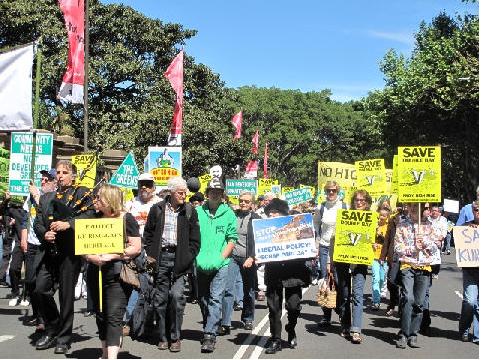
.
Residents formed the ‘Ku-ring-gai Residents Alliance’

http://www.notsohigh.org.au
- We oppose the plans for over-development and excessive high-rise in Ku-ring-gai
- Under the NSW ALP Government’s Sydney Metropolitan strategy an additional 10,000 dwellings are to be constructed in Ku-ring-gai between 2004 and 2031.
- Our two local state MPs are agreeing with the state ALP Government’s target of 10,000 dwellings for Ku-ring-gai.
- At the time of next year’s election (March 2011) we extrapolate from council’s data that only around 6,000 new dwelling DAs will have been approved in Ku-ring-gai.
- We want to limit new high-rise developments in Ku-ring-gai to the 6,000 dwellings. Our local state MP’s are thus supporting a further 4,000 new dwellings post the election.
- Stop_at_6000
- 4,000 additional dwellings are equivalent to another 100 new five-storey, high-rise blocks, about an additional 12,000 residents and about an additional 8,000 cars on our already congested roads.
Mr O’Farrell is quoted in the North Shore Times (Friday 15th October, 2010) as saying that he ‘has as much chance of halting development in Ku-ring-gai as unscrambling an omelet’.
However, the Ku-ring-gai Residents’ Alliance has prepared a recipe for Mr O’Farrell to ‘unscramble an omelet’ and limit dwellings to 6,000.
This Blueprint recipe was mentioned in the North Shore Times (3rd November, 2010) and the recipe can be found in full below….
1) Restore planning power to council by disbanding the Ku-ring-gai Planning panel (the Panel’s contract expires in March 2011 anyway)
2) Subject to the status of the Town Centres Local Environment Plan (LEP) as at March 2011 (currently LEP being litigated by Friends of Turramurra) council can then issue a new LEP with reduced heights and dwelling numbers and other revisions (a new LEP can override existing LEP(s))
3) The new Liberal Planning Minister can gazette the new LEP(s) (the Minister must be willing to accept an LEP providing for less than 10,000 total Metro Strategy Ku-ring-gai dwellings)
4) Disband the Joint Regional Planning Panels. These bodies approve developments over $10Million and Council developments over $5Million -which effectively mean most high-rise blocks and Council projects. (If these Panels are not disbanded then giving power back to Ku-ring-gai council is meaningless, as large developments will still go ahead, approved by these bodies).
5) Repeal Part 3A of the Act –which currently provides for developments that, in the opinion of the Planning Minister, are of State or regional environmental planning significance and includes large private developments over $100Million. These developments are taken over by the state government with few, if any, merit appeal rights by objectors and with overriding decision making by the Planning Minister.
6) Review and change the Metro Strategy and its targets. The Metro Strategy is purely a policy document that can be changed by the new government. The Labor Party is also currently reviewing the Metro Strategy and its targets and released a discussion paper in March 2010 Sydney Towards 2036.
You may wish to send an email to Ku-ring-gai’s two local MPs, Mr Barry O’Farrell (LOP@parliament.nsw.gov.au) and Mr Jonathan O’Dea (davidson@parliament.nsw.gov.au), urging them to adopt a comprehensive intelligent planning policy that takes into account all the possibilities such as green field development, satellite cites and development of regional areas and meanwhile for them to publicly pledge to limit new high-rise developments in Ku-ring-gai to the 6,000 dwellings figure, not the 10,000 target they want to respect (North Shore Times 1.10.10 and 15.10.10).
Please also email your concerns to the North Shore Times at letters@northshoretimes.com.au
You are not alone. Of more than 700 votes cast in the October 2010 North Shore Times’ online poll, 96 per cent wanted new dwellings capped at 6000.
‘Our elected representatives must listen to the community’

.
.
‘Friends of Turramurra seek public unity as they take Town Centres plan to Land and Environment Court’
[by Elias Jahshan, Hornsby Advocate newspaper, 20101125, ^http://hornsby-advocate.whereilive.com.au/news/story/lep-to-be-challenged-in-court/]

Friends of Turramurra are seeking donations to help fund their legal action against the State Government over the Ku-ring-gai town centre plans. The community group will be taking NSW Planning Minister Tony Kelly and the Ku-ring-gai Planning Panel to the Land and Environment Court on Monday to appeal the Ku-ring-gai Town Centres Local Environment Plan (LEP), which was gazetted by Mr Kelly in May this year.
“We have been advised that our case has reasonable prospects. We hope the community will get behind us,” Friends of Turramurra (FOT) president Alan Parr said.
As the quality of decisions made during the LEP process can not be challenged, the appeal will attempt to prove that Mr Kelly and the Panel did not follow correct procedures when making the LEP.
Some of these incorrect procedures, as alleged by FOT, include an incomplete, invalid and misleading exhibition process, lack of consideration on environmental impacts, and changes allegedly made by the Panel and Mr Kelly without re-exhibition.
Mr Parr said that should FOT win the appeal, the LEP will be scrapped as a result.
“A whole new planning process can (then) be carried out, one that values public participation, follows proper process and correctly considers the environment,” he said.
Mr Parr refuted claims that compensation will need to be paid out to developers should the LEP be overturned. He explained that no construction under the LEP has commenced and compensation would be limited those who spent money to obtain an approved development application, and so far only three minor DAs have been approved under the LEP.
“If there is a change of Government next March and (NSW Opposition Leader) Barry O’Farrell remains true to his word and gives planning controls back to Council, then (Ku-ring-gai) Council will have no excuse to perpetuate these appalling plans,” he said.
“Instead it can scrap them completely and work with the community to do something positive and appropriate.”
FOT will be represented by Kirsty Ruddock, lawyer at the Environmental Defender’s Office and daughter of Berowra Federal Liberal MP Phil Ruddock.
The Planning Minister’s office was contacted for a comment on the issue.
“It’s not appropriate that the NSW Government commentate on legal action against (the LEP),” the spokesman to Mr Kelly said.
“In saying this, we stand by our decision in regard to the LEP.”
.
.
By July 2011…
.
‘Court finds Ku-ring-gai’s town centres plan `has no legal standing’
[by Lisa Herbertson and Catherine Zuill, North Shore Times, 20110728, ^http://north-shore-times.whereilive.com.au/news/story/court-finds-ku-ring-gais-town-centres-plan-has-no-legal-standing/]
.
Ku-ring-gai residents are celebrating after the town centres plan was found to have no legal standing by the Land and Environment Court’s Justice Malcolm Craig.
In a far-reaching decision this afternoon, Mr Craig said that the Ku-ring-gai Local Environmental Plan (Town Centres 2010) published on the NSW legislation website on May 25, 2010 had been made:
.
“Contrary to the provisions of division four of part three of the Environmental Planning and Assessment Act 1979 and is thereby of no legal force or effect’”.
The handing down of the decision took less than one minute at about 2pm today.
Planning MInister Brad Hazzard is considering this afternoon’s judgment.
Ecstatic residents who had packed the court room to hear the decision were carrying bottles of champagne and grinning from ear to ear as they were ushered out of the room where they stood chatting joyfully outside about today’s decision.
Premier Barry O’ Farrell, also the Ku-ring-gai MP, welcomed the result: “It’s a good decision because it seeks to reflect that local communities should be at the heart of local planning”’ he said.
“Our position and what we took to the campaign is that you can’t do local planning and ignore the community.
“This decision is consistent with our approach.’”
Davidson MP Jonathan O’Dea said he was delighted to hear the news on behalf of the local community. “I visited the court hearing a couple of time myself and congratulate those who led that action.
“It’s another demonstration on how planning power will be returned to the local community which is the philosophy of this government.’”
Mr O’Farrell’s Coalition government abolished the Planning Panel shortly after they came into power in March. The town centres LEP was challenged by Ku-ring-gai resident groups via Friends of Turramurra (FOT) on the grounds that due process was not followed, the public exhibition process was misleading, the impact on bushland and the environment was not properly considered, and the Planning Minister and Planning Panel made too many changes after the plan was exhibited.
Friends of Turramurra argued that these issues had state-wide implications and that there was a public interest in challenging the plan.
A tearful Alan Parr, president of Friends of Turramurra said: “The message we’d like to convey is it’s a great day not only for Ku-ring-gai, but for communities all across NSW.
“It’s really going to force Planning Ministers to follow proper procedures.”
“What we’re hoping is that it will hold planning ministers to account and should generally return powers to Ku-ring-gai.”
“This gives Ku-ring-gai the chance to start fresh with plans that are sympathetic to the community.”
Mr Parr said he was not able to say how much had been spent on the court challenge but they would apply for costs to be paid by the opposing party.
A Ku-ring-gai Council spokesman said the council was not in a position to comment until the council had seen the court’s document.
“It’s a very long and complex judgement which requires quite a bit of analysis,”’ he said.
“Also, it’s worth noting that the council is not a party to the case, which is between Friends of Turramurra and the State Government.”
.
Other Comments:
The National Trust of Australia descibed the decision as a “victory for all of NSW”.
The Trust’s policy and communications director Scott Woodcock said:
“Regrettably, Sydney’s heritage has suffered irreversible damage during the short life of the Town Centres LEP. Entire neighbourhoods of heritage significance have already been destroyed.’‘
“Many of the recently constructed apartment buildings display a fundamental lack of understanding of context and neighbourhood character. These new poorly sited apartments will stand for the next 100 years as monuments to a planning failure. “
.
Ku-ring-gai Residents’ Alliance (KRA) president Chris Drummer said: “It’s a very big day for Ku-ring-gai and all communities in NSW.
“The decision reflects the poor planning we have endured for almost two decades,’’ he said. “We trust this is a new beginning and look forward to resolving the dwelling numbers now for Ku-ring-gai and the other destructive existing planning instruments.”
KRA had called on Premier Barry O’Farrell, also the Member for Ku-ring-gai, to revoke “this destructive LEP’‘.
Friends of Turramurra’s Stan Wesley said: “A lot of taxpayers’ money went into creating these plans. I hope that today’s decision encourages other community groups to stand up for their rights.”
Friends of Turranmurra’s Janet Harwood said: ” It was just clearly wrong.
“The system is full of flaws and to put something in like this would have been a disaster. The decision is an indication of what the community have been saying for years.”
Davidson MP Jonathan O’Dea said he was delighted to hear the news on behalf of the local community. “I visited the court hearing a couple of times myself and congratulate those who led that action.
“It’s another demonstration of how planning power will be returned to the local community which is the philosophy of this government.”
.
.
‘Celebration time as high-rise plans thrown out of court‘
[by Kelsey Munro, Sydney Morning Herald, 20110729, ^http://smh.domain.com.au/real-estate-news/celebration-time-as-highrise-plans-thrown-out-of-court-20110728-1i2e3.html, accessed 20110729]
.
Resident action group ‘Friends of Turramurra‘ (FOT) last month felt that they had won a significant victory against over-development in the Sydney North Shore leafy suburb of Ku-ring-gai. The New South Wales Land and Environment Court ruling a Ku-ring-gai town centre plan was judged ‘invalid’ due to failures in the state Planning Department’s public exhibition process. The plan for the rail corridor running through six suburbs making up Ku-ring-gai, threatened to impose dense high rise apartment buildings of up to ten storeys in what has for over a hundred years been a quiet leafy residential area, characterised by stately heritage dwellings and gardens, many dating back to Australian Edwardian and Federation periods.
The plan was one devised by the previous Labor Government, since thrown out of office in the March 2011 NSW election. NSW Labor, trying to cope with excessive housing demand in Sydney, had sought to supply capacity for 10,000 along the northern rail corridor through Ku-ring-gai. But NSW Labor had been frustrated by resistance from local councils defending the rights and interests of their constituent residents. So NSW Labor had introduced legislation to overrule local councils’ planning powers, give absolute power to the Minister for Planning and In the Ku-ring-gai case, set up a Ku-ring-gai Planning Panel to rezone (degrade) Ku-ring-gai real estate from first class residential into high rise commercial along the rail corridor. But for Ku-ring-gai, the proposed scale of rezoning and development threatened substantial undermining of the mush prized residential amenity of leafy Ku-ring-gai.
NSW Labor’s impost was an undemocratic law and process, behind closed doors that ignored the interests and value of local residents. It was seen as ideological vindictive an impost by a socialist Labor Party culture that perceived the residents of Ku-ring-gai as wealthy elites undeserving of their leafy exclusive suburbs. It was reminiscent of land grabs of established society by totalitarian socialist regimes – Castro’s Cuba (1960), Mao’s China (1966-76), Lenin’s Russia (1917).
The Friends of Turramurra have since called for an inquiry into the way the former Labor government and the Planning Department handled Ku-ring-gai during the past decade. This is appropriate and important to restore the community’s faith delegating representative trust in government at elections and to restore the community’s support for the machinations of government process and law making.
In Ku-ring-gai, the July 2011 judgment is being hailed as a victory for communities fighting for a say in how their suburbs develop. But victory was perhaps more due to the commitment and deep pockets of the residents and the expert support from the Environmental Defender’s Office. President of the Friends of Turramurra group, Alan Parr, has said:
.
”What the judgment does is show that planning ministers are not all powerful.
They have to follow proper process and procedure.
They have to show respect to community opinion and they cannot conduct themselves behind closed doors outside of public scrutiny.”
.
.
‘Resident group’s victory leaves Ku-ring-gai in a planning limbo’
[by Kelsey Munro, Urban Affairs, Sydney Morning Herald, 20110802, ^http://www.smh.com.au/nsw/resident-groups-victory-leaves-kuringgai-in-a-planning-limbo-20110801-1i8by.html]
.
‘Ku-ring-gai residents may have been jubilant last Saturday, but the council not faces a planning challenge. Unlike the residents who won a battle against high-rise, Ku-ring-gai council is not opening champagne over last week’s court decision which threw out a major planning document and put a costly six-year process back to square one.
The Ku-ring-gai mayor, Ian Cross, said the legal victory of the Friends of Turramurra has put the area in planning limbo, stuck with the problem of where to fit 10,000 new dwellings, and effectively burning about $4 million of ratepayers’ money.
Despite Ku-ring-gai council previously distancing itself from the Town Centres Local Environmental Plan as a creation of the Labor government, yesterday the mayor called the court decision ”a major disappointment”.
Cr Cross said procedural errors which invalidated the LEP were not council staff’s doing, and he hoped to meet the Planning Minister, Brad Hazzard, to discuss the ramifications.
”I certainly respect the actions of Friends of Turramurra as its members had a democratic right to challenge the legality of this plan,” Cr Cross said.
”But it’s important to note the decision rested on procedural matters, not the actual merits of the plan.”
.
The plan was not just about ”medium density housing” and extra capacity for town centres at Gordon, Roseville, Lindfield, Pymble, St Ives and Turramurra, he said, but also provided for new parks, heritage conservation areas and streetscape improvements.
Ku-ring-gai councillor Tony Hall said those affected, such as Charter Hall REIT, which bought the Gordon Centre shopping mall in January, or the private Masada College in Lindfield, may have the right to sue for compensation.
”All [Masada’s] plans to upgrade the school have gone down the gurgler. They have the right to a class action against the state government and they’d join the council to it,” Cr Hall said. ”[Hazzard] has the power to amend the LEP to overcome the invalidity issues in the judgment, and if Barry O’Farrell and his government have got the will, that’s what they should do.”
The way in which former planning minister Tony Kelly rezoned Masada’s land from two to five storeys was a key error identified by the court, while Charter Hall bought the Gordon Centre when its height limit had been increased to 10 storeys under the now-defunct plan, affecting its commercial value. The college and Charter Hall REIT did not wish to comment.
The property industry said a new LEP must be developed quickly.
”It does make the investment climate difficult when you can’t rely on consents and instruments issued by the state,” said Glenn Byres, from the Property Council. The planning department is reviewing implications of last week’s judgment and declined to comment.
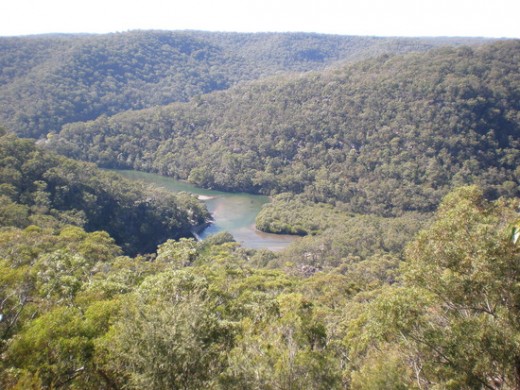 Ku-ring-gai Chase National Park
(Ku-ring-gai before ANY development) Ku-ring-gai Chase National Park
(Ku-ring-gai before ANY development)
.
.
Further Reading:
.
[1] National Trust, ^http://www.nationaltrust.com.au/about/media/files/280711%20Ku-ring-gai%20Judgement.pdf
[2] Friends of Ku-ring-gai Environment, Inc., Newsletter, October 2010, ^http://www.foke.org.au/downloads/NltrOct10.pdf [Read More]
[3] Ku-ring-gai Residents Alliance, ^http://www.notsohigh.org.au
.
– end of article –
.
Tags: affordable housing, Centre for International Economics, Friends of Turramurra, key growth areas, Ku-Ring-Gai, Ku-Ring-Gai Residents Alliance, Not So High in Ku-Ring-Gai, O'Farrell Government, PAP, politics of envy, Precinct Acceleration Protocol, Sydney development strategy, Urban Development Institute of Australia, urban housing demand, Urban Task Force
Posted in Threats from Development, Threats from Overpopulation | No Comments »
Add this post to Del.icio.us - Digg
Leave a Reply
You must be logged in to post a comment.
July 29th, 2011
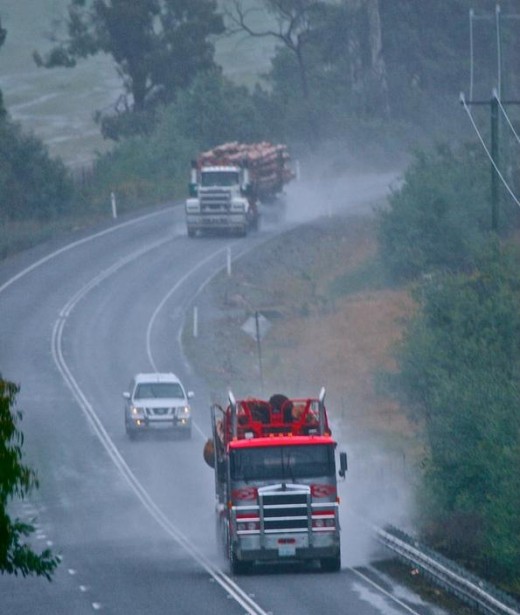 Trucks Logging Tasmania
© Photo by Paul Tapp, Triabunna, Tasmania, 20110718
[Source: http://tasmaniantimes.com/index.php/article/the-triabunna-experiment] Trucks Logging Tasmania
© Photo by Paul Tapp, Triabunna, Tasmania, 20110718
[Source: http://tasmaniantimes.com/index.php/article/the-triabunna-experiment]
.
‘A peace deal between Tasmania’s forestry industry and environmental lobby has been secured by a $274 million government package, raising hopes the long-running conflict is near an end.
.
‘The deal hammered out at the weekend by the Prime Minister, Julia Gillard, and the Tasmanian Premier, Lara Giddings, has the full backing of industry but was criticised by green groups.
The deal ensures existing major logging contracts can be met from forests outside the protected areas but halves the key sawlog quota. The package confirms the reservation of 430,000 hectares of native forest around the state, including the Tarkine rainforests of the island’s north-west and ‘a sprinkling of mountainous coastal forests around the east coast’.
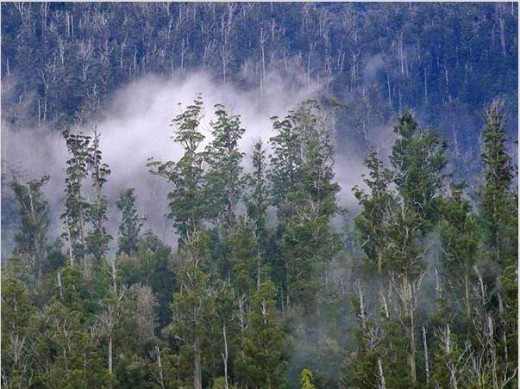
‘With the lion’s share of funds to come from the Commonwealth, the package’s big-ticket items are $85 million to workers and contractors who lose their jobs in industry restructuring, $120 million in extra regional development money for Tasmania and $43 million to implement the changes.
‘The strategically important Triabunna woodchip mill, bought by wealthy environmentalists Jan Cameron and Graeme Wood last week, is to keep operating. But its chips will need Forest Stewardship Council certification, meaning an end for the mass woodchipping of old growth that so divided Tasmania.
‘But one of the chief negotiators, Phill Pullinger of Environment Tasmania, said critical points still lay ahead in translating the weekend’s federal-state heads of agreement into a fully operational process.
‘The federal Greens leader, Bob Brown, said the agreement was a ”Labor-Labor-loggers‘‘ outcome.
”The popular expectation that a 610,000 hectare system of wild forest national parks would be established, as the loggers were bailed out of their failing industry, has been dashed.”
.
[Source: ‘ $274m buys hope that bitter logging dispute is at an end‘, by Andrew Darby, The Age newspaper, Hobart, 20110725]
Read more: ^http://www.theage.com.au/environment/conservation/tasmania-in-274m-forests-deal-20110724-1hves.html
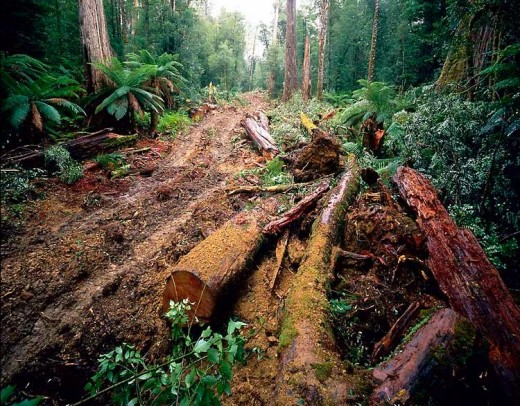 A Forestry Tasmania Footprint
© Photo by Rob Blakers Photography, www.RobBlakers.com A Forestry Tasmania Footprint
© Photo by Rob Blakers Photography, www.RobBlakers.com
http://www.water-sos.org/rob-blakers1.html
‘There has always been good reason to preserve Tasmania’s native old-growth forests. But two years ago the bitter, protracted conflict between loggers and conservationists took a decisive turn.
‘Scientists at the Australian National University revealed that the moist, cool forests of south-eastern Australia are the most carbon-dense environments in the natural world. They store on average more than twice the carbon per hectare than moist, tropical rainforests, which are a more familiar focus of global environmental concerns. Then in May this year, Australia’s new Climate Commission identified the preservation of these forests as critical in limiting Australia’s emissions “while the slower process of transforming energy and transport systems unfolds“.
‘Likewise, the commission estimated billions of tonnes of carbon could be sequestered from the atmosphere if logged areas were reafforested. Add to that the novel intervention of two entrepreneurs who recently paid $10 million for a Gunns sawmill – just so they could close it down – and it seems the three-decade-old impasse over Tasmania’s native forests has finally been broken.
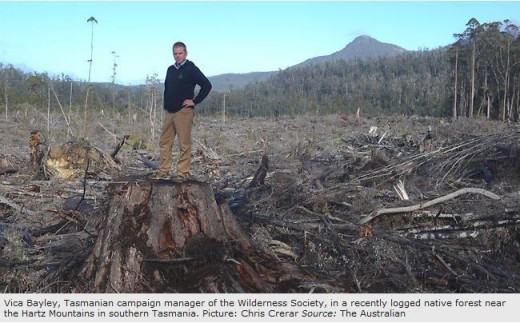
‘This weekend’s $274 million federal government package, which puts 430,000 hectares of native forests off-limits to loggers, is a historic first step. True, the deal between environmentalists and the timber industry is a compromise and not everyone is happy. But the agreement does recognise two crucial claims: the urgent need to protect native forests from further commercial encroachment and the legitimate demand for compensation from communities that have long lived from logging. Tasmania’s small regional economy is vulnerable, which is partly why logging, and the jobs it supports, have long been such a divisive issue. Equally, the dispute has been deadlocked for want of an alternative vision.
‘Globally, forest clearing is responsible for 18 per cent of greenhouse gas emissions. With a carbon tax coming in Australia and numerous carbon trading schemes already operating around the world, such extraordinary carbon sinks as Tasmania’s old-growth forests now have an economic value, not just an ecological one.
‘At the same time, the competitiveness of Tasmania’s woodchip industry has been declining because of the high Australian dollar and low-cost plantations elsewhere. Tasmania’s green credentials have been compromised by images of protesters chained to trunks and of magnificent, ancient trees being felled to satisfy the world’s appetite for woodchips, pulp and disposable chopsticks.
‘Australia’s smallest state should now be able to position itself favourably for the low-carbon economy of the future. That does not rule out supplying high-quality, high-value timber sourced from “certified sustainable” plantations to an environmentally discerning local and global market.’
.
[Source: ‘Old-growth valued at last‘, Sydney Morning Herald, Editorial, 20110725, p.10]
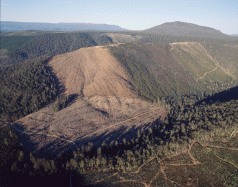 © Photo by Rob Blakers © Photo by Rob Blakers
.
.
Editor’s comment:
.
Government bail out of a 19th Century exploitative industry with taxpayer millions is expedient short term politics ~ throwing other people’s money at the problem. The Labor Gillard Government has just pitched a $274 million bail out package to Forestry Tasmania and its dependents, but as usual the devil is in the detail. That funding is stretched over ten years and is split between the Federal and Tasmanian governments. It seems only $85 million is being made available from Gillard’s bail out in the current year. Her press release (copy below) is unclear on this. Moreover, while $85 million is welcome to Tasmanians, at the same time as Premier Lara Giddings announced recently, Tasmania has been denied a total of around $1.5 billion in expected GST revenue and State taxes from the Federal Government. Tasmanian revenues are being controlled by Canberra. Canberra is treating Tasmania as a welfare state, and a welfare state is what Tasmania is becoming.
.
Twenty-first Century leadership for Tasmania requires triple-bottom line innovative problem solving, listening to all the people of Tasmania.
.
It is incumbent on Tasmanians themselves to strategise a long term competitive and independent vision for Tasmania’s economy and society that respects Tasmania’s natural values. Twenty-first Century political leadership would see the national government encourage this, facilitate a transition process (and not deny GST funding) to trust and enable the island elected Tasmanian Government itself to implement the transition strategies as it sees fit. The transition process demands a quantum investment in vocational education of Tasmanians. So where is that strategy?
.
The crux of Tasmania’s triple bottom line problem in all this is that ‘Tasmania’s small regional economy is vulnerable!’
.
Overhaul and nurture Tasmania’s regional employment to ‘certified sustainability’, since only then may Tasmania’s regional social and ecological systemic problems be resolved with broad community support.
.
In the editor’s view, Tasmania has sufficient natural resources, clean-green industries and innovative entrepreneurs to give New Zealand and its ‘pure’ brand image a run for its money. Tasmania’s natural and human capital just need to be tapped, nurtured and professionally marketed…globally.
.
The following extracts provide some background reading in this issue. Readers can make up their own minds.
.
.
Background Reading:
.
What is the Tasmanian Government’s strategy?
.
Start with the lead agency, termed the ‘Tasmanian Planning Commission’
.
Well it seems its strategy is mainly about urban development. “The current main strategic national priorities are:
- Capital city strategic planning
- Development assessment reform
- Housing affordability
- Climate change (however that is dealt with)
- Retail competition.”
.
What the hell is the Tasmanian Planning Commission’s terms of reference, or is there some other entity delegated to consider Tasmania’s ‘whole of island’ planning?
READ MORE: ^http://www.planning.tas.gov.au/the_planning_system/national_planning
.
.
…meanwhile…’Prime Minister’s press release on the future of ‘Tasmanian Forestry’, 20110724
.
‘Australian and Tasmanian Governments support the future of Tasmanian forestry‘, Sunday 20110724, jointly by the Prime Minister and Premier of Tasmania
[Source: ^http://www.pm.gov.au/press-office/australian-and-tasmanian-governments-support-future-tasmanian-forestry]
.
‘Prime Minister Julia Gillard and Tasmanian Premier Lara Giddings today announced an historic agreement on the future of forestry in Tasmania. In the face of changing market conditions, both in Australia and around the world, it has become clear that the pressure on the Tasmanian forestry industry in its current form is not sustainable. Today’s agreement will secure jobs, ensure a sustainable forestry industry, and achieve iconic environmental outcomes by protecting High Conservation Value forests and remaining old growth forests for future generations.The Heads of Agreement, backed by up to $276 million, will also support workers and their families affected by industry restructure.
Under the Heads of Agreement:
- The Australian and Tasmanian Governments will provide up to $85 million in immediate assistance for workers and contractors who are losing their jobs and livelihoods as a result of industry restructure. This will include employee assistance, retraining and relocation support and assistance for voluntary permanent exits from native forest operations for haulage and harvest contractors (what to?);
- Facilitate sustainable opportunities for the Tasmanian forestry sector with the Tasmanian Government guaranteeing at least 155,000 cubic metres per year in wood supply, 12,500 cubic metres per year of speciality timbers, subject to verification and 265,000 cubic metres of billets, with existing wood supply contracts to be honoured and the Australian Government to fund a voluntary exit mechanism to enable further native wood supply capacity to be retired and reserve areas increased when suitable plantation wood supply is available;
- The Tasmanian Government will reserve and protect 430,000 hectares of native forest from within the 572,000 hectares nominated through the Statement of Principles process, and place the full 572,000 in informal reserve subject to an independent verification process of conservation values and compatibility with yearly guaranteed wood supply, led by Professor Jonathan West. The findings will determine the area of High Conservation Value forest to be reserved, with $7 million a year for their ongoing management to be provided by the Australian Government following incorporation into formal reserves;
- $120 million in Australian Government investment over 15 years, including $20 million in 2011-12, to develop and diversify the Tasmanian economy to drive new job opportunities for Tasmanian families, including through job-creating projects (such as?) in communities affected by forestry restructure. A new ministerial advisory council to be chaired by Mr Bill Kelty AC will drive new regional development opportunities and a new place-based investment Memorandum of Understanding (MoU) between the two governments; and
- The Australian Government will provide $43 million to implement the Heads of Agreement including funding for a range of activities such as working with communities through the transition and provide voluntary compensable exits to sawmillers wishing to exit the native forestry industry.
.
The Heads of Agreement is consistent with the Statement of Principles agreement between environment non-government organisations, the Tasmanian forestry industry and the CFMEU, which was presented by independent facilitator Mr Bill Kelty last month.
It means the forestry industry can continue on a sustainable footing, and guarantees ongoing supply for existing businesses that are critical to supporting jobs and regional communities in Tasmania.The Australian and Tasmanian Governments thank the signatories to the Statement of Principles and Mr Kelty for their commitment and hard work. The Statement of Principles process and the Heads of Agreement reached today creates an opportunity to move forward after decades of conflict and build a stronger future for Tasmania.Governments recognise the significant challenges faced by the industry in the face of global economic and market conditions as well as the historic opportunity provided by forestry and environmental parties coming together to agree on a framework for delivering a sustainable future for the forest industry and the environment. We also recognise that these challenges, as well as the decision by Gunns Limited to exit from native forestry, will have significant impacts on workers, communities and the Tasmanian economy.The Governments clearly expect that following today’s historic agreement environment and industry stakeholders will end the long-running conflict over native forestry. The Governments also expect that the Tasmanian Parliament will pass the required legislation by 30 June 2012. The Australian and Tasmanian governments will work together to identify and support regional economic development through a partnership to create investment and jobs opportunities, particularly for regional communities..
The Australian and Tasmanian Governments will also work together to examine and identify potential opportunities from increased reserves from the Commonwealth Biodiversity Fund. In October last year, the Tasmanian forestry industry and several environmental non-government organisations reached a Statement of Principles for protecting native forests and developing a sustainable timber industry in Tasmania. The Australian and Tasmanian Governments appointed Mr Bill Kelty as an independent facilitator to facilitate talks on the Statement of Principles agreed to between environment non-government organisations, the CFMEU and the forestry industry in Tasmania.’
.
.
…meanwhile…’Independent Strategic Review of Forestry Must Examine Auditor-General’s Report’
by Kim Booth MP, Greens Member for BassKim Booth MP, Greens Forestry spokesperson, Wednesday, 20110706
[Source: ^http://mps.tas.greens.org.au/2011/07/independent-strategic-review-of-forestry-tasmania-must-examine-auditor-general%E2%80%99s-report-and-no-further-public-bail-out-without-parliaments-approval/]
.
‘The Tasmanian Greens today called on the Minister for Forests to ensure that the current independent Strategic Review into Forestry Tasmania includes the Auditor-General’s Special Report 100, Financial and economic performance of Forestry Tasmania, saying that the Report makes it clear that Forestry Tasmania is a failed business and in urgent need of restructure..
Greens Forestry spokesperson, Kim Booth MP, also called for a commitment that no further public monies will be used to bail out Forestry Tasmania from any financial difficulties without such a funding injection first coming before the Parliament.
“I have long been on the record warning the Minister that Forestry Tasmania is a rogue agency that has been unable to return a sustainable commercial rate of return for the Tasmanian public, and is in fact a drain upon the public purse,” Mr Booth said.
“As Shareholder Minister, it is incumbent on him to take responsibility for the fact that the Auditor General formed the view that whilst the ‘expectation of Forestry, and the environment in which it operates, changed fundamentally’ over the last 15 years, the ‘business and funding model did not keep pace with these changes.”
“This Report by the Auditor-General is relevant to the independent Strategic Review of Forestry Tasmania, and the Greens believe it must be formally submitted for the Review’s consideration.”
“With Forestry Tasmania crying poor and the suggestion that more public money might be required to pay their employees superannuation how will the Minister reassure Tasmanians that he will take a more active role in ensuring hard-earned public money is not thrown into the bottomless pit that is Forestry Tasmania?”
“Any further injection of public funds, to bail out this underperforming GBE, should not occur without first seeking Parliament’s approval of any conditions set upon which public money is provided,” Mr Booth said.’
.
.
…meanwhile…’What the community thinks of the forest peace talks’
Media release by Forestry Tasmania, 20110724.
[Source: ^http://www.forestrytas.com.au/news-room/media-releases/what-the-community-thinks-of-the-forest-peace-talks].‘Forestry Tasmania has this morning released a new opinion poll to provide negotiators with an insight into what the community expects out of the forest peace talks.Managing Director Bob Gordon said the survey conducted by respected pollster EMRS for Forestry Tasmania was to his knowledge the only attempt by any of the parties to gain a credible gauge on the community’s expectations and its results therefore could be useful as the Federal and State governments edge closer to a final agreement.
“Finding a durable long lasting agreement that embraced the community’s wishes was always going to be a challenge, and that is reflected in the survey results. The survey found the community wants to strike a balance between environmental outcomes and jobs. When asked to nominate important outcomes, nearly two thirds mentioned protecting old growth forests while 60 per cent nominated jobs. It also found the community overwhelmingly believed that any additional reserves should be determined by rigorous scientific analysis, while less than one in five people thought the State should simply agree to the request by environmentalists to lock up (read ‘save’) 572,000 hectares. It is therefore reasonable to conclude that any agreement must include independent verification of the so called high conservation value forests, if it’s to win community acceptance.”
Mr Gordon said governments also had a communications challenge ahead. “More than half of respondents did not believe they had sufficient information to make an informed decision about the peace talks.”
The EMRS survey of 600 people in late June was part of an ongoing series of tracking surveys that FT has commissioned since August 2008. Mr Gordon said he was delighted that Forestry Tasmania’s reputation had remained strong during a period of considerable turmoil.
“FT’s rating as a good corporate citizen had slipped slightly, but 56 percent had a positive perception of FT compared to 28 per cent with a negative view. “This particular survey indicates there has been a significant shift in community expectations since the previous survey 12 months ago. The community is becoming more concerned about employment and the economy. For example, the percentage of those wanting FT to focus on creating jobs was now at its highest level since March 2009. On the other hand, the percentage of those wanting carbon to be the highest priority had dropped from 30 per cent two years ago to just 13 per cent now.”
.
.
…meanwhile…’Tasmania – $111 million better off with Forestry Tasmania’
Media Release by Forestry Tasmania, 20110722
[Source: ^http://www.forestrytas.com.au/news-room/media-releases/tasmania-111-million-better-off-with-forestry-tasmania]
..
‘Forestry Tasmania has launched a new television advertising campaign highlighting the contribution made by the timber industry to rural Tasmania.The new commercial was shot in Geeveston featuring local workers earlier this week and goes to air for the first time tonight. Forestry Tasmania’s Managing Director Bob Gordon said the commercial draws heavily on the recently released Auditor General’s report into FT’s financial and economic performance, which found Tasmania was $111 million a year better off with Forestry Tasmania operating.
“This report debunks the myth peddled by anti forestry activists that FT and the native forest industry is heavily subsidised and Tasmania would be better off without it. “The fact is the future of many rural and regional communities would be at risk if there was a sudden halt to native forestry. Forestry is the life blood of many, many country towns in Tasmania, and already many are suffering as a result of the forestry downturn.”
Mr Gordon said the $111 million referred to by the Auditor General was conservative.
“Last year, the final value of products produced from state forest timber was $563m – and that’s in a year where forestry was dealing with its worst downturn in memory. That $563m supported in the vicinity of 3,000 full time direct jobs. There are many more workers that indirectly depend on the income from forestry – in retail, hospitality, transport and service sectors. “It’s important to remember that the $111m is just FT’s contribution, it doesn’t include the contribution of the local sawmiller, the local contractor, veneer mills and furniture makers that rely on the wood products harvested from State forests. The full value of the timber industry is around $1.4billion.”
Mr Gordon said FT had committed $14,000 in airtime for the new commercial.
“I’m not going to apologise for spending that money on keeping the community informed and our brand healthy. Too many people depend on FT maintaining a good, strong reputation for us to become squeamish about spending dollars on advertising.”
FT will soon release the results of its latest EMRS poll, measuring corporate brand. The results show FT remains one of the most respected brands in Tasmania, remaining ahead of eight other key businesses and GBE’s.
“Community support for the work we do is still very strong, but this poll is significant because jobs are emerging as the number one issue. People still want a balance between development and the environment, but they think the balance has tipped too far in favour of green ideology, and not enough emphasis is being placed on jobs, particularly in rural and regional communities.”
.
.
…meanwhile…’Step forward for Tasmania’s forests’
Media release by The Wilderness Society (Tasmania), 20110725
[Source: ^http://www.wilderness.org.au/regions/tasmania/step-forward-for-tasmanias-forests]
.
After a campaign lasting more than three decades, the end is now closer than ever in the battle to protect Tasmania’s unique native forests.
With the Prime Minister and Premier Giddings finally coming to the negotiation table, the full implementation of last year’s forest agreement is now in sight. Back in May this year, we suspended our involvement in the Tasmanian forest talks. This was due to inaction by both the Federal and Tasmanian Governments in implementing the forest agreement that was signed by environment groups and the timber industry in October 2010. Now the two governments have finally shown the leadership we have been calling for and the implementation of the historic agreement can now begin.
“This is an important day in the history of the 30-year battle to save Tasmania’s magnificent forests,” said Wilderness Society Tasmania Campaign Manager Vica Bayley.
While the full Statement of Principles has not yet been implemented, this is a major step forward. The next steps in the process will be crucial to bringing a lasting peace in the forests.
Sunday’s signing of the Heads of Agreement between the Federal and Tasmanian Governments maps out a process to immediately protect 430,000 hectares of high-conservation value native forests, with a further 142,000 hectares set aside from logging and awaiting protection subject to verification processes.
The agreement also includes $128 million to assist logging companies and contractors to exit the industry. We will continue to work with other environment groups, unions, the timber industry and both governments to ensure all 572,000 hectares of high-conservation value native forests are protected within world heritage areas and national parks.
The proposed Tamar Valley pulp mill is not part of this latest announcement and the Wilderness Society remains opposed to its construction.
.
.
…meanwhile… back to the subject of Strategies for Tasmania…this is what Tasmania’s leader is focusing on:
.
‘Ministerial Statement: Tasmanian State Services Structural Reforms and Productivity Strategies’
by Lara Giddings Labor Premier of Tasmania
[Source: ^http://www.premier.tas.gov.au/hot_topics/ministerial_statement_-_tasmanian_state_service_structural_reforms_and_productivity_strategies, no date]
.
Introduction
“Mr Speaker, on the 10th of February I released the Mid-Year Financial Report.
The Report detailed the significant financial challenge we face in framing this year’s State Budget. Since then, we have heard in the Federal Budget that Tasmania will lose a further $343 million in GST receipts. That means we have now lost a total of around $1.5 billion in expected GST revenue and State taxes from the Forward Estimates.
Mr Speaker, we are faced with some difficult decisions to ensure we do not go back to the bad old days of the 1990s, when we had spiralling debt, and when we saw funds that should have been spent on services instead being used to pay the interest on that debt. I am determined not to allow the State Budget to slide back into that situation. How we will achieve that will be in next month’s Budget.
But today I want to announce some of the approaches the Government will be taking to help us to return the State’s finances to a sustainable footing while improving the productivity of the public service
In releasing the Mid Year Financial Report, I said the Government would implement a Public Sector Productivity Strategy, with the aim of achieving savings of around $200 million per annum by 2014 15.
Today I will give more detail about some of the ways we will achieve that. Our first priority has been to look at reducing expenses that do not impact on employment, such as phones, cars, travel and the like, but of course those things alone will not be enough to reach our savings target.
In simple terms, the measures I will announce fall into two broad categories. The first set is about making our public service more productive and more efficient The second set is about reducing the cost of our public sector. Both are critical if we are to restore the State Budget to a sustainable footing. The Government’s response to our Budget challenge is not about slashing costs just for the sake of it.
It is about returning the Budget to surplus so we can continue to invest in jobs and services that will ensure Tasmania remains a great place to live. It is about making the right decisions today so we can have a better future.
Mr Speaker, I am aware of the anxiety created in the public service by the Government’s need to find savings.
I know there are many hard working and dedicated public servants who are worried about how these changes might affect them. It is unfortunate that this period of uncertainty has been unavoidable as we work through the issues around the Budget. It is also disappointing that some have chosen to fill the vacuum while we were formulating our response with fear campaigns and misinformation.
In the meantime I have been discussing our approach with key stakeholders, unions, heads of agencies and my Labor and Green colleagues. I hope to be able to allay some of the concerns that have arisen by making it clearer how we will go about making those changes.
That is one reason that I have brought this announcement forward to today rather than leaving it to Budget day next month: so that people will know more about what is happening – and what is not – sooner rather than later.
I value the contribution of our public servants, and indeed strong public services are at the very core of Labor values such as equity, fairness and helping those most in need.
Mr Speaker, I will first outline to the House some of the measures we will be taking to achieve the productivity changes I spoke about – how we will go about achieving greater flexibility and efficiency.
This approach is about making the state service more contemporary, less bureaucratic and more accountable, with a more agile and productive workforce to meet future needs of the Tasmanian community.
Once I have done that I will outline the processes we will follow to reduce our costs. I will not be outlining the exact savings we will be making – that is an issue for next month’s budget.
But I will talk about the process we will follow to ensure employees are treated as fairly, flexibly, compassionately and openly as possible if their positions are identified as no longer being required. The reality is that employee salaries and associated costs make up over 50% of operational expenditure, and in some Agencies this percentage is as high as 70%. Savings in recurrent expenditure of the magnitude that we require can only be achieved through prioritising programs and achieving savings in Agency employment costs.
I have said repeatedly since I released the Mid Year Financial Report that redundancies, and particularly involuntary redundancies, would be a last resort. The measures I announce today are consistent with that approach and will maximise the opportunity for those affected to find new jobs with minimal disruption to their lives.
But where redundancies are required these reforms will ensure affected staff are treated fairly through a clearly understood process. Two of these measures will require legislative change but in large part they are entirely consistent with existing powers and processes
Although they will not be part of the Budget legislation, I will be asking members to agree to the necessary amendments to the Tasmanian State Service Act during the Budget session.
.
Independent State Service Review
Mr Speaker, one of the key steps we will take to address the productivity of our public sector relates to the longer term governance arrangements that should apply to State Service employment.
The State Service Act 2000 underpins all employment in the State Service and establishes governance, employment and structural arrangements for the Tasmanian State Service.
It is time to review these arrangements to guarantee the State Service remains able to meet the challenges of the future.
There are concerns about some aspects of the current arrangements including:
- The clarity of lines of authority
- Support for contemporary workforce management, which allows for flexibility to respond to service delivery, program or policy changes; and
- The number of jurisdictions involved in appeals and reviews (e.g. State Service Commissioner, Tasmanian Industrial Commission, Integrity Commission, Anti-Discrimination Commission).
Mr Speaker, these are concerns that have been raised with me in my discussions with unions, agencies and other key stakeholders and I believe we must address them if we are to make our public sector the best it can be.So today I announce that the Government will commission, through our usual procurement processes, an independent review to examine:
- Employer role responsibilities
- The State Service Commissioner role and responsibilities
- Head of Agency roles and responsibilities
- Tasmanian Industrial Relations Commission roles
- Appropriate grounds of appeal and the correct jurisdiction to determine appeals.
This review will involve consultation and discussion with all stakeholders, including staff, unions and other relevant bodies. In addition the reviewer will be asked to provide recommendations and propose a way forward which may involve amendments to the State Service and Industrial Relations Acts.
State Service Amendment (Performance) Bill 2011
Mr Speaker, improving productivity is essential if we are to maintain a high level of service in the key front line areas – like health, emergency management and education – on which we all depend.Following consultation with agencies and key unions, the Government has determined that performance management, including dealing with underperformance, is a critical component of a Tasmanian State Service “reform agenda” to improve the efficiency and productivity of our public sector.It was also accepted that an authority is required within the legislation to enable us to assist those employees who are struggling or unable to perform the tasks required of them. Most of us want to know if we are not performing to the expectations of our employer, and we need to be given the feedback and the opportunity to improve.It is the Government’s duty as a responsible employer to work with staff to ensure they can perform to the best of their ability, which is good for their morale and career prospects, and obviously a boost for productivity and the quality of service we provide to the public.
We have a responsibility to strengthen our performance management processes, including better training for managers, and indeed that is an issue that unions have raised with me as a way of ensuring staff are given the feedback they need and deserve.
In response, I will be introducing the State Service Amendment (Performance) Bill 2011 to amend the State Service Act 2000 to enable more active management of both performance and underperformance of state service employees.
The amendments will also provide a proper authority for the termination of those employees who after support is given are still unable to perform their duties effectively. It is important that this legislation be introduced at this time to distinguish between this and processes involving surplus employees.
These changes are not a ‘backdoor’ way of sacking people to reduce costs. They are about ensuring our public sector is working efficiently and effectively and providing taxpayers with value for their money. But if at the end of the day some individuals cannot meet those expectations we need a fair and open process to work through.
The provisions of the amendment will ensure that agencies adhere to “due process” (natural justice) in cases involving termination and provide authority to the Minister administering the State Service Act to ultimately, after due process, terminate employment of under-performing employees.
.
Workforce Renewal Incentive Program
Mr Speaker, I have already announced the implementation of a Workforce Renewal Incentive Program.
This program provides an incentive (of up to $20,000) to allow staff to separate from the State Service in certain circumstances, and gives us the opportunity to gain new skills and capabilities in the workforce.
The Program will allow Agencies to renew their workforce and maintain a balanced workforce profile to meet their priority objectives.
The Workforce Renewal Incentive Program is about ensuring the State Service has the right skills profile to meet the challenges of 2011-12 and beyond.
This approach has already been successfully implemented in the Education Department, allowing us to help renew the teaching profession and provide more opportunities for graduates.
.
Vacancy management
Mr Speaker, I now want to turn to the reforms that relate to reducing the cost of our public service.
These changes go to the processes we will follow in seeking to reduce our costs, and how we will attempt to minimise the disruption to the affected individuals in the process.
It is clear that we will not be able to maintain public service employee numbers at the current levels – it’s just not sustainable. Recognising this situation, the Government will put in place a range of measures designed to support Agencies in managing reductions in employee numbers.
As I have consistently said, redundancies will be the last resort. And if we do have to offer redundancies, they will be targeted and limited to positions that are no longer required. We will not be offering mass redundancies because they are too costly and they are not strategic.
Invariably when you open redundancies to anyone who wants to go you lose skills and experience that you did not want to lose. So, if we identify that a position is no longer required the first step we will take will be to see if the person in that position can be redeployed to a vacancy within their own agency.
Each agency has already implemented internal vacancy management measures. These will ensure that each position that becomes vacant will be fully reviewed before any recruitment process is started to determine:
• If it is essential for the position to be filled;
• If the classification level of the position is appropriate; and
• If there are any surplus employees within the agency able to fill the position.
Internal agency vacancy management also encompasses other strategies such as:
• the timing of filling the vacancy;
• the ability of the position to be filled on part-time or job-sharing basis;
• natural attrition following normal separation (abolition of funded vacancies);
• restructuring within Agencies where programs or services are to be discontinued;
• reviewing the need for specific fixed term employment;
• reassignment of duties to existing employees (within the Agency);
• increased approval of leave without pay applications;
• increased approval of secondments to organisations outside the State Service (where available);
• increased use of flexible working arrangements, such as part time employment; and/ or
• workforce re-profiling and utilisation of the Workforce Renewal Incentive Program that I mentioned earlier.
.
Inter-agency vacancies
Mr Speaker, if a member of staff who is surplus to requirements cannot be redeployed within their own agency the next step will be to see if their skills can be used in another agency.
I will be issuing a Ministerial Direction that details procedures to manage inter-agency vacancies. The Direction will ensure that there is a whole of government approach to matching surplus employees with vacancies that exist across all agencies.
It is essential that there is a consistent and coordinated approach to these strategies and the Public Sector Management Office (PSMO), within the Department of Premier and Cabinet is to be the single contact point for matching surplus employees and vacancies.
Where a Head of Agency is unable to identify suitable vacancies within the agency, he or she may recommend to the independent State Service Commissioner, who will oversee the process, that an employee be made available for redeployment in accordance with section 47 of the State Service Act 2000.
In the case of a Senior Executive Service (SES) officer, the Secretary of DPAC is advised.
Employees and officers accepted as surplus may be considered on a suitability basis for transfer to vacant state service positions in other agencies. Assessments of suitability will be undertaken by assessment panels established by agencies for that purpose. The purpose of a suitability assessment is to determine whether the referred employee/officer can satisfactorily carry out the duties either immediately or within a reasonable time given appropriate training and experience.
.
External placement of surplus employees
Mr Speaker, the next step if staff who are no longer required cannot be redeployed within government will be to see if we can assist them to find work externally.
The Public Sector Management Office will explore career or specific job opportunities external to the Tasmanian State Service for surplus employees and officers, including permanent and fixed term placements. The terms and conditions of any external placement will be negotiated with the relevant parties in accordance with Section 46 of the State Service Act.
PSMO will also establish a schedule of preferred providers that may be available to assist surplus employees. These will include, but not be limited to:
• Career Planning;
• Outplacement;
• Job search;
• Counselling (Employee Assistance Program);
• Financial management;
• Superannuation; and
• Taxation
Agencies may refer surplus employees at any time to the above support services and will, in consultation with their employees, decide the appropriate provider, type and level of advice to assist the employee.
Targeted voluntary redundancy arrangements
Mr Speaker, the Government is currently reviewing its targeted voluntary redundancy arrangements, and I would hope that these, combined with our vacancy control and redeployment measures, will help to minimise the need for any involuntary redundancies.
As I have already said, the emphasis of these arrangements will be on specific targeted redundancies within identified programs, rather than a general offer of voluntary redundancies across a range of program areas, as has been the previous approach.
This will better align our voluntary redundancy arrangements with the structural reform and productivity strategies required to meet our Budget task.
The renewed arrangements will also be designed to:
• place greater onus on Heads of Agency to consider and exhaust other options before offering voluntary redundancies;
• ensure greater emphasis on justifying the cost/benefit of voluntary redundancies before offers are made;
• improve flexibility by incentivising redundancies where other alternatives have been exhausted and early voluntary separation is both desirable and cost effective; and
• minimise the need for involuntary separations.
Changes to Section 47
Mr Speaker, currently the Tasmanian State Service Act provides for a twelve month redeployment period for employees declared as surplus under Section 47.
After much discussion within Government and Cabinet this period was considered to be too long. The Government did consider moving to a three month period but it was agreed that this was too short to allow all options for employees to be redeployed to be explored.
As a result, the Government intends to introduce an amendment to section 47 of the State Service Act which will limit the maximum redeployment period to six-months.
Some other jurisdictions do not specify any redeployment period for surplus employees, though they do require genuine attempts to be made to redeploy surplus employees before termination occurs.
Industrial precedent and decisions in Industrial Tribunals require that an employer demonstrate that redeployment attempts have not been successful, or are not available.
A six-month period is reasonable for inter-agency and alternative strategies to be properly explored. In some cases, particularly for an employee with highly-specialised skills and employment needs, the likelihood or otherwise of redeployment would be established well within this timeframe.
A six-month period appropriately balances redeployment requirements and the costs of continued employment. A longer period of uncertainty also has a negative impact on the employee and the workforce generally.
.
Involuntary redundancies
Mr Speaker, once all of the options I have detailed have been exhausted the very last step we may be forced to take is involuntary redundancies.
I can inform the House that the Government will not be seeking to amend Section 44 of the State Service Act to allow for involuntary termination on economic and operational grounds.
I recognise that some stakeholders were concerned that we might have chosen this path because they feared it could lead to widespread and abrupt redundancies without the type of redeployment options and voluntary processes I have spoken about today. This was an issue of particular concern to unions and my Labor and Greens colleagues.
Instead, if required we would seek to achieve the savings required through the existing provisions of Section 47 of the current State Service Act, which was introduced in 2000 by the Bacon Labor Government.
Section 47 provides for termination after it is has been declared that suitable redeployment has not been available through the various processes I have detailed. Previously, it has been unclear under Section 47 whether an involuntary redundancy package should be made available after this declaration is made.
To ensure there is no longer any doubt, the Government has agreed that, should this stage be reached, after the opportunity has been given to take a voluntary redundancy or pursue redeployment options over six-months, the affected employee will be entitled to a redundancy package.
This package should reflect a balanced and reasonable approach based on the need for “fair” treatment of our employees while recognising the financial benefit that accrues through having had a guaranteed six month paid redeployment period.
The package will contain a minimum payment consistent with the Targeted Voluntary Redundancy Arrangements. The package will also contain a ‘years of service’ payment.
The difference between the package for a ‘voluntary offer and acceptance’ and an involuntary redundancy will need to take into account the benefits that accrue to an employee who remains on redeployment for the full 26-weeks.
We will finalise the details of the involuntary redundancy entitlements following further discussion and consultation with the Unions.
Conclusion
In conclusion, Mr Speaker, the current fiscal situation means the Government is no longer able to meet its budget targets, and we risk moving into an unsustainable position if action is not taken.
Improving the efficiency and productivity of the state service, and reducing our costs, are key strategies we will be implementing in the coming months. But this is also about strengthening our public sector so it can better perform its key role – providing services to the Tasmanian community.
It is important to remember that the majority of employees will not be affected by decisions that identify programs that are no longer required. But I am very conscious that the changes we need to make should be done fairly and openly so we can minimise concerns among staff and the impact on the affected individuals.
That is why I have detailed today the measures we will be implementing and the processes we will be following, and I will ensure that all of our public servants are made aware of what we will be doing.
And I hope that by releasing more details about the direction we will be taking we can allay some of the concerns and fears that have arisen in recent weeks, and we will continue to work with staff and unions as we work through this process.
I believe these changes will lead to a more productive and efficient public service. They will reduce the Government’s costs at a time of financial pressure, and they will do so in a way that gives affected staff the best chance of finding alternative employment. And for employees who find themselves in areas where the positions they occupy are no longer required, it is critical that the alternatives available to them should be fair and clear.
I believe the range of measures I have announced today will help us to achieve all of these goals as we negotiate the difficult times ahead.”
.
.
– end of article –
Tags: certified sustainable, Environment Tasmania, forest peace talks, Forest Stewardship Council certification, Forestry Tasmania, Gunns, Julia Gillard, Lara Giddings, logging trucks, old growth, Phill Pullinger, sawlog quota, Strategies for Tasmania, Tasmania welfare state, Tasmania's old-growth forests, Tasmanian logging, Tasmanian Planning Commission, The Wilderness Society, Triabunna, wildtasmania.org, Woodchipping Tasmania
Posted in Tasmania (AU), Threats from Deforestation, Threats to Wild Tasmania | No Comments »
Add this post to Del.icio.us - Digg
Leave a Reply
You must be logged in to post a comment.
July 28th, 2011
The following article was initially posted 20090414 by Tigerquoll on CanDoBetter.net:.

The UN position in 1992 on conserving native forests of the world:
.
‘At the 1992 United Nations Conference on Environment and Development (UNCED) the forest issue was among the most controversial, polarizing developing and developed countries.
In Rio de Janeiro, Brazil, intense negotiations among governments at UNCED resulted in the Non-legally Binding Authoritative Statement of Principles for a Global Consensus on the Management, Conservation and Sustainable Development of all Types of Forests, also known as the “Forest Principles”, as well as Chapter 11 of Agenda 21: Combating Deforestation.”
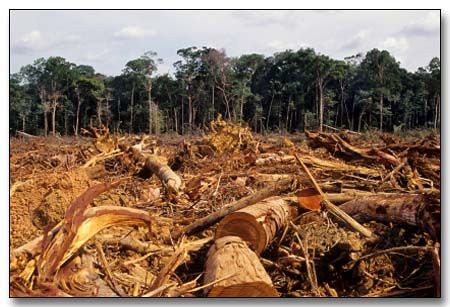
.
..
1992 Report of the United Nations Conference on Environment and Development [UNCED]
(Rio de Janeiro, 3-14 June 1992)
Extract from ‘Annex III’:
[NON-LEGALLY BINDING AUTHORITATIVE STATEMENT OF PRINCIPLES FOR A GLOBAL CONSENSUS ON THE MANAGEMENT, CONSERVATION AND SUSTAINABLE DEVELOPMENT OF ALL TYPES OF FORESTS]
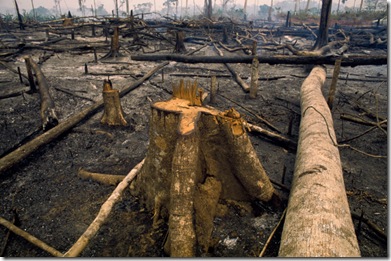
.
PREAMBLE
(a) The subject of forests is related to the entire range of environmental and development issues and opportunities, including the right to socio-economic development on a sustainable basis.
(b) The guiding objective of these principles is to contribute to the management, conservation and sustainable development of forests and to provide or their multiple and complementary functions and uses.
(c) Forestry issues and opportunities should be examined in a holistic and balanced manner within the overall context of environment and development, taking into consideration the multiple functions and uses of forests, including traditional uses, and the likely economic and social stress when these uses are constrained or restricted, as well as the potential for development that sustainable forest management can offer.
(d) These principles reflect a first global consensus on forests. In committing themselves to the prompt implementation of these principles, countries also decide to keep them under assessment for their adequacy with regard to further international cooperation on forest issues.
(e) These principles should apply to all types of forests, both natural and planted, in all geographical regions and climatic zones, including austral, boreal, subtemperate, temperate, subtropical and tropical.
(f) All types of forests embody complex and unique ecological processes which are the basis for their present and potential capacity to provide resources to satisfy human needs as well as environmental values, and as such their sound management and conservation is of concern to the Governments of the countries to which they belong and are of value to local communities and to the environment as a whole.
(g) Forests are essential to economic development and the maintenance of all forms of life.
(h) Recognizing that the responsibility for forest management, conservation and sustainable development is in many States allocated among federal/national, state/provincial and local levels of government, each State, in accordance with its constitution and/or national legislation, should pursue these principles at the appropriate level of government.
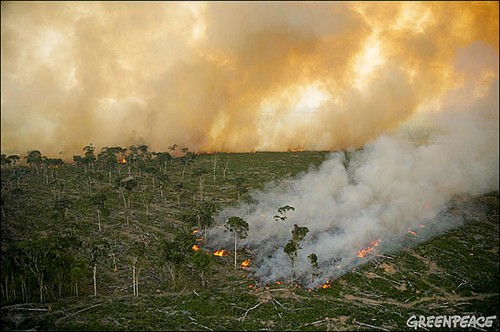
.
PRINCIPLES/ELEMENTS
.
1. (a) States have, in accordance with the Charter of the United Nations and the principles of international law, the sovereign right to exploit their own resources pursuant to their own environmental policies and have the responsibility to ensure that activities within their jurisdiction or control do not cause damage to the environment of other States or of areas beyond the limits of national jurisdiction.
(b) The agreed full incremental cost of achieving benefits associated with forest conservation and sustainable development requires increased international cooperation and should be equitably shared by the international community.
2. (a) States have the sovereign and inalienable right to utilize, manage and develop their forests in accordance with their development needs and level of socio-economic development and on the basis of national policies consistent with sustainable development and legislation, including the conversion of such areas for other uses within the overall socio-economic development plan and based on rational land-use policies.
(b) Forest resources and forest lands should be sustainably managed to meet the social, economic, ecological, cultural and spiritual needs of present and future generations. These needs are for forest products and services, such as wood and wood products, water, food, fodder, medicine, fuel, shelter, employment, recreation, habitats for wildlife, landscape diversity, carbon sinks and reservoirs, and for other forest products. Appropriate measures should be taken to protect forests against harmful effects of pollution, including air-borne pollution, fires, pests and diseases, in order to maintain their full multiple value.
(c) The provision of timely, reliable and accurate information on forests and forest ecosystems is essential for public understanding and informed decision-making and should be ensured.
(d) Governments should promote and provide opportunities for the participation of interested parties, including local communities and indigenous people, industries, labour, non-governmental organizations and individuals, forest dwellers and women, in the development, implementation and planning of national forest policies.
3. (a) National policies and strategies should provide a framework for increased efforts, including the development and strengthening of institutions and programmes for the management, conservation and sustainable development of forests and forest lands.
(b) International institutional arrangements, building on those organizations and mechanisms already in existence, as appropriate, should facilitate international cooperation in the field of forests.
(c) All aspects of environmental protection and social and economic development as they relate to forests and forest lands should be integrated and comprehensive.
4. The vital role of all types of forests in maintaining the ecological processes and balance at the local, national, regional and global levels through, inter alia, their role in protecting fragile ecosystems, watersheds and freshwater resources and as rich storehouses of biodiversity and biological resources and sources of genetic material for biotechnology products, as well as photosynthesis, should be recognized.
5. (a) National forest policies should recognize and duly support the identity, culture and the rights of indigenous people, their communities and other communities and forest dwellers. Appropriate conditions should be promoted for these groups to enable them to have an economic stake in forest use, perform economic activities, and achieve and maintain cultural identity and social organization, as well as adequate levels of livelihood and well-being, through, inter alia, those land tenure arrangements which serve as incentives for the sustainable management of forests.
(b) The full participation of women in all aspects of the management, conservation and sustainable development of forests should be actively promoted.
6. (a) All types of forests play an important role in meeting energy requirements through the provision of a renewable source of bio-energy, particularly in developing countries, and the demands for fuelwood for household and industrial needs should be met through sustainable forest management, afforestation and reforestation. To this end, the potential contribution of plantations of both indigenous and introduced species for the provision of both fuel and industrial wood should be recognized.
(b) National policies and programmes should take into account the relationship, where it exists, between the conservation, management and sustainable development of forests and all aspects related to the production, consumption, recycling and/or final disposal of forest products.
(c) Decisions taken on the management, conservation and sustainable development of forest resources should benefit, to the extent practicable, from a comprehensive assessment of economic and non-economic values of forest goods and services and of the environmental costs and benefits. The development and improvement of methodologies for such evaluations should be promoted.
(d) The role of planted forests and permanent agricultural crops as sustainable and environmentally sound sources of renewable energy and industrial raw material should be recognized, enhanced and promoted. Their contribution to the maintenance of ecological processes, to offsetting pressure on primary/old-growth forest and to providing regional employment and development with the adequate involvement of local inhabitants should be recognized and enhanced.
(e) Natural forests also constitute a source of goods and services, and their conservation, sustainable management and use should be promoted.
7. (a) Efforts should be made to promote a supportive international economic climate conducive to sustained and environmentally sound development of forests in all countries, which include, inter alia, the promotion of sustainable patterns of production and consumption, the eradication of poverty and the promotion of food security.
(b) Specific financial resources should be provided to developing countries with significant forest areas which establish programmes for the conservation of forests including protected natural forest areas. These resources should be directed notably to economic sectors which would stimulate economic and social substitution activities.
8. (a) Efforts should be undertaken towards the greening of the world.
All countries, notably developed countries, should take positive and transparent action towards reforestation, afforestation and forest conservation, as appropriate.
(b) Efforts to maintain and increase forest cover and forest productivity should be undertaken in ecologically, economically and socially sound ways through the rehabilitation, reforestation and re-establishment of trees and forests on unproductive, degraded and deforested lands, as well as through the management of existing forest resources.
(c) The implementation of national policies and programmes aimed at forest management, conservation and sustainable development, particularly in developing countries, should be supported by international financial and technical cooperation, including through the private sector, where appropriate.
(d) Sustainable forest management and use should be carried out in accordance with national development policies and priorities and on the basis of environmentally sound national guidelines. In the formulation of such guidelines, account should be taken, as appropriate and if applicable, of relevant internationally agreed methodologies and criteria.
(e) Forest management should be integrated with management of adjacent areas so as to maintain ecological balance and sustainable productivity.
(f) National policies and/or legislation aimed at management, conservation and sustainable development of forests should include the protection of ecologically viable representative or unique examples of forests, including primary/old-growth forests, cultural, spiritual, historical, religious and other unique and valued forests of national importance.
(g) Access to biological resources, including genetic material, shall be with due regard to the sovereign rights of the countries where the forests are located and to the sharing on mutually agreed terms of technology and profits from biotechnology products that are derived from these resources.
(h) National policies should ensure that environmental impact assessments should be carried out where actions are likely to have significant adverse impacts on important forest resources, and where such actions are subject to a decision of a competent national authority.
9. (a) The efforts of developing countries to strengthen the management, conservation and sustainable development of their forest resources should be supported by the international community, taking into account the importance of redressing external indebtedness, particularly where aggravated by the net transfer of resources to developed countries, as well as the problem of achieving at least the replacement value of forests through improved market access for forest products, especially processed products. In this respect, special attention should also be given to the countries undergoing the process of transition to market economies.
(b) The problems that hinder efforts to attain the conservation and sustainable use of forest resources and that stem from the lack of alternative options available to local communities, in particular the urban poor and poor rural populations who are economically and socially dependent on forests and forest resources, should be addressed by Governments and the international community.
(c) National policy formulation with respect to all types of forests should take account of the pressures and demands imposed on forest ecosystems and resources from influencing factors outside the forest sector, and intersectoral means of dealing with these pressures and demands should be sought.
10. New and additional financial resources should be provided to developing countries to enable them to sustainably manage, conserve and develop their forest resources, including through afforestation, reforestation and combating deforestation and forest and land degradation.
11. In order to enable, in particular, developing countries to enhance their endogenous capacity and to better manage, conserve and develop their forest resources, the access to and transfer of environmentally sound technologies and corresponding know-how on favourable terms, including on concessional and preferential terms, as mutually agreed, in accordance with the relevant provisions of Agenda 21, should be promoted, facilitated and financed, as appropriate.
12. (a) Scientific research, forest inventories and assessments carried out by national institutions which take into account, where relevant, biological, physical, social and economic variables, as well as technological development and its application in the field of sustainable forest management, conservation and development, should be strengthened through effective modalities, including international cooperation. In this context, attention should also be given to research and development of sustainably harvested non-wood products.
(b) National and, where appropriate, regional and international institutional capabilities in education, training, science, technology, economics, anthropology and social aspects of forests and forest management are essential to the conservation and sustainable development of forests and should be strengthened.
(c) International exchange of information on the results of forest and forest management research and development should be enhanced and broadened, as appropriate, making full use of education and training institutions, including those in the private sector.
(d) Appropriate indigenous capacity and local knowledge regarding the conservation and sustainable development of forests should, through institutional and financial support and in collaboration with the people in the local communities concerned, be recognized, respected, recorded, developed and, as appropriate, introduced in the implementation of programmes. Benefits arising from the utilization of indigenous knowledge should therefore be equitably shared with such people.
13. (a) Trade in forest products should be based on non-discriminatory and multilaterally agreed rules and procedures consistent with international trade law and practices. In this context, open and free international trade in forest products should be facilitated.
(b) Reduction or removal of tariff barriers and impediments to the provision of better market access and better prices for higher value-added forest products and their local processing should be encouraged to enable producer countries to better conserve and manage their renewable forest resources.
(c) Incorporation of environmental costs and benefits into market forces and mechanisms, in order to achieve forest conservation and sustainable development, should be encouraged both domestically and internationally.
(d) Forest conservation and sustainable development policies should be integrated with economic, trade and other relevant policies.
(e) Fiscal, trade, industrial, transportation and other policies and practices that may lead to forest degradation should be avoided. Adequate policies, aimed at management, conservation and sustainable development of forests, including, where appropriate, incentives, should be encouraged.
14. Unilateral measures, incompatible with international obligations or agreements, to restrict and/or ban international trade in timber or other forest products should be removed or avoided, in order to attain long-term sustainable forest management.
15. Pollutants, particularly air-borne pollutants, including those responsible for acidic deposition, that are harmful to the health of forest ecosystems at the local, national, regional and global levels should be controlled.’
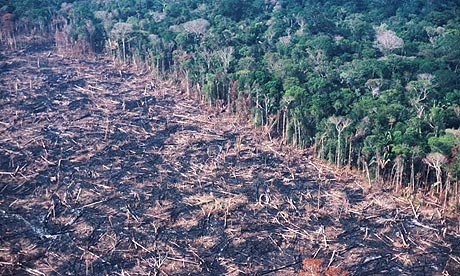
.
.
The UN position in 2007:
.
‘Following nearly 3 years of intense negotiations, starting from UNFF5 and culminating at UNFF7, the Non-Legally Binding Instrument on All types of Forests was adopted on 28 April 2007. The Instrument was adopted by the UN General Assembly (Resolution 62/98) on 17 December 2007.
The purpose of this instrument is:
(a) To strengthen political commitment and action at all levels to implement effectively sustainable management of all types of forests and to achieve the shared global objectives on forests;
(b) To enhance the contribution of forests to the achievement of the internationally agreed development goals, including the Millennium Development Goals, in particular with respect to poverty eradication and environmental sustainability;
(c) To provide a framework for national action and international cooperation.’
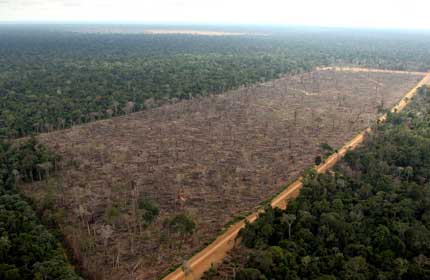
– end of article –
.
.
Rainforest Reality, 2011:
.
‘Deforestation in Brazil’s Amazon Region Increases 400% in One Year’ [ May 2011]
[20110520, hispanicallyspeakingnews.com]
.
‘Brazil is reporting a dramatic increase in deforestation in the Amazon that has the country’s environmental protectionists and some government officials troubled. In just one year – March/April of 2010 -2011 – Brazil’s Amazon has seen a 400 percent increase in the amount of acres that have undergone deforestation – 25,451 acres to 146,533, according to satellite images from the Brazilian space research institute.
Environmental protectionists believe the increased demand for cattle and soy are behind the decision to clear so many acres, while other blame the government for not being hesitant in regards to laws to regulate deforestation. The country’s Environmental Minister Izabella Teixeira said she was troubled to see the satellite images, and said the government would establishing a special panel to address the matter.
Currently, Brazilian law states that 80 percent of the land in the Amazon region must remain forested, and that has been in place since 1934. Still, deforestation advocates claim additional clearing is needed. In the state of Mato Grosso, deforestation occurs in large part to make room for soybean production.’
.
[Source: ^ http://www.hispanicallyspeakingnews.com/notitas-de-noticias/details/deforestation-in-brazils-amazon-region-increases-400-in-one-year/7782/, accessed 20110728]
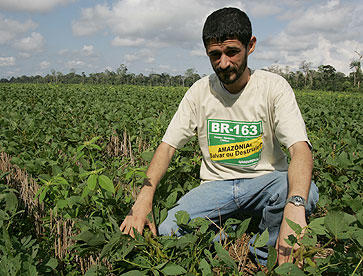
Editor’s comment: ‘This the consequence of ‘non-legally binding UN ‘Forest Principles’.’
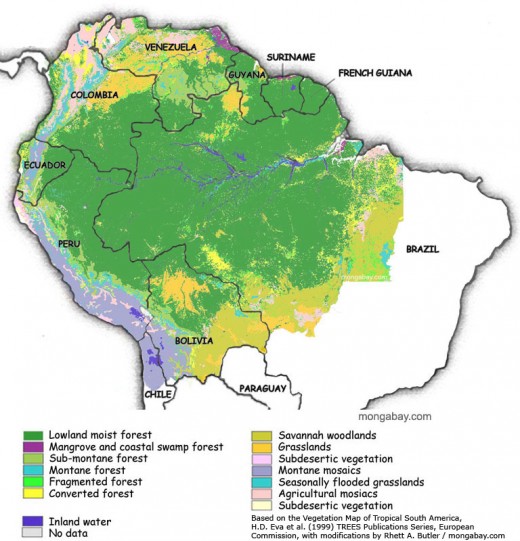
.
.
Read More:
.
[1] United Nations Forum on Forests, ^http://www.un.org/esa/forests/
[2] Mongabay.com, ^http://www.mongabay.com/brazil.html
[3] Greenpeace.org, ^http://www.greenpeace.org/international/en/press/releases/second-largest-rate-of-amazon/
[4] Greenpeace campaign to save the Amazon, ^http://www.greenpeace.org/international/en/campaigns/forests/amazon/
[5] ‘Deforestation in decline but rate remains alarming, UN agency says‘, UN News Centre, ^http://www.un.org/apps/news/story.asp?NewsID=34195
[6] ‘REDD’, The United Nations Collaborative Programme on Reducing Emissions from Deforestation and Forest Degradation in Developing Countries, ^http://www.un-redd.org/
[7] ‘UN: $40bn a year could halve deforestation worldwide‘, by Will Nichols, 20110606, Business Green, ^http://www.businessgreen.com/bg/news/2076417/-usd40bn-halve-deforestation-worldwide
.
(above references accessed 20110728)
.
– end of article –
Tags: Agenda 21: Combating Deforestation, Amazon forest, deforestation, Forest Principles, old growth conservation, old growth forest, Rainforest Reality, soybean, tigerquoll, U.N. Principles, UNCED, UNFF
Posted in Amazon (BR), Threats from Deforestation, Threats from Farming | No Comments »
Add this post to Del.icio.us - Digg
Leave a Reply
You must be logged in to post a comment.
July 27th, 2011
 (click to enlarge photo) (click to enlarge photo)
‘There is a proposal by (Queensland-based) Coalpac Pty Ltd to mine coal, using high wall and open cut mining techniques. This activity would occur within the Ben Bullen State Forest, this forest adjoins the Gardens of Stone, an amazing area containing rock formations called pagodas.
If this destructive mine is approved, at least 1088 ha of old growth forest will be destroyed, with its iconic, rare flora and fauna. We have an unenviable record of species extinctions, locally and nationally.
Lyrebirds use the sides of the pagodas to nest and raise their young. The area is home to tiger quolls, powerfull owls and more than 30 native animals, five of which are listed as endangered.
Local residents will not suffer from dust in the air, but they, and others further afield, will have their water supply contaminated.
Please write to Mrs Roza Sage (Liberal Party Member for Blue Mountains electorate) to express your concern about this irreplaceable environment at risk frominappropriatre and unnecessary mining development.’
Anne Dillon, Blackheath.
.
[Source: Blue Mountains Gazette, ‘Threat to forest’, 20110713, page 12, Blue Mountains, New South Wales Australia]

.
Further reading:
.
[1] ^http://fatcanyoners.org/2011/05/14/gardens-of-stone-protest/
Leave a Reply
You must be logged in to post a comment.
|
|
 Pilliga Forest
The early morning sun illuminates fresh forest grasses
beneath a stand of young native White Cypress Pine (Callitris glaucophylla), Feb 2010
^http://huntervalleyjournal.blogspot.com/2010_02_01_archive.html
Pilliga Forest
The early morning sun illuminates fresh forest grasses
beneath a stand of young native White Cypress Pine (Callitris glaucophylla), Feb 2010
^http://huntervalleyjournal.blogspot.com/2010_02_01_archive.html
 Nuable Creek in flood, Pilliga 2004
Source: David Brodrick, 2004, ^http://www.narrabriweather.net/events/10Dec2004.html
Nuable Creek in flood, Pilliga 2004
Source: David Brodrick, 2004, ^http://www.narrabriweather.net/events/10Dec2004.html
 Location of ‘The Pilliga’ as shown by the distribution map of the native Pilliga Mouse
Australian Department of Environment et al.
[Source: ^http://www.environment.gov.au/cgi-bin/sprat/public/publicspecies.pl?taxon_id=99#recovery_plan_loop]
Location of ‘The Pilliga’ as shown by the distribution map of the native Pilliga Mouse
Australian Department of Environment et al.
[Source: ^http://www.environment.gov.au/cgi-bin/sprat/public/publicspecies.pl?taxon_id=99#recovery_plan_loop]
 The Pilliga Forests
lie between the towns of Coonabrabran in the south and Narrabri in the north
situated in north western New South Wales in the Brigalow Belt South bioregion.
[Source: ^http://maps.bonzle.com/c/a?a=p&p=56925&cmd=sp]
The Pilliga Forests
lie between the towns of Coonabrabran in the south and Narrabri in the north
situated in north western New South Wales in the Brigalow Belt South bioregion.
[Source: ^http://maps.bonzle.com/c/a?a=p&p=56925&cmd=sp]
 Wooleybah Sawmill, Pillaga
(NSW Heritage Office)
Wooleybah Sawmill, Pillaga
(NSW Heritage Office)
 The Pilliga is susceptible to bushfire – by lighting, arsonists and incompetence.
[Source: clubr8255’s photostream, http://www.flickr.com/photos/32053650@N03/with/3038473001/
The Pilliga is susceptible to bushfire – by lighting, arsonists and incompetence.
[Source: clubr8255’s photostream, http://www.flickr.com/photos/32053650@N03/with/3038473001/
 A Silhouette of Pillage
Eastern Star Gas’s coal seam gas development in the Pilliga State Forest,
A Silhouette of Pillage
Eastern Star Gas’s coal seam gas development in the Pilliga State Forest,
 Santos footprints in The Pilliga
Santos footprints in The Pilliga
 The Bibblewindi water pollution ponds are one of ten constructed during the Pilliga ‘exploration’ phase.
So far there are 1,100 well heads planned for gas extraction just in the eastern quarter of the Pilliga alone.
Photo: T Pickard
The Bibblewindi water pollution ponds are one of ten constructed during the Pilliga ‘exploration’ phase.
So far there are 1,100 well heads planned for gas extraction just in the eastern quarter of the Pilliga alone.
Photo: T Pickard
























































































